A Beginner's Guide to Pannier Tanks
by Jim Champ
(pictures from the webmaster's collection unless otherwise credited)
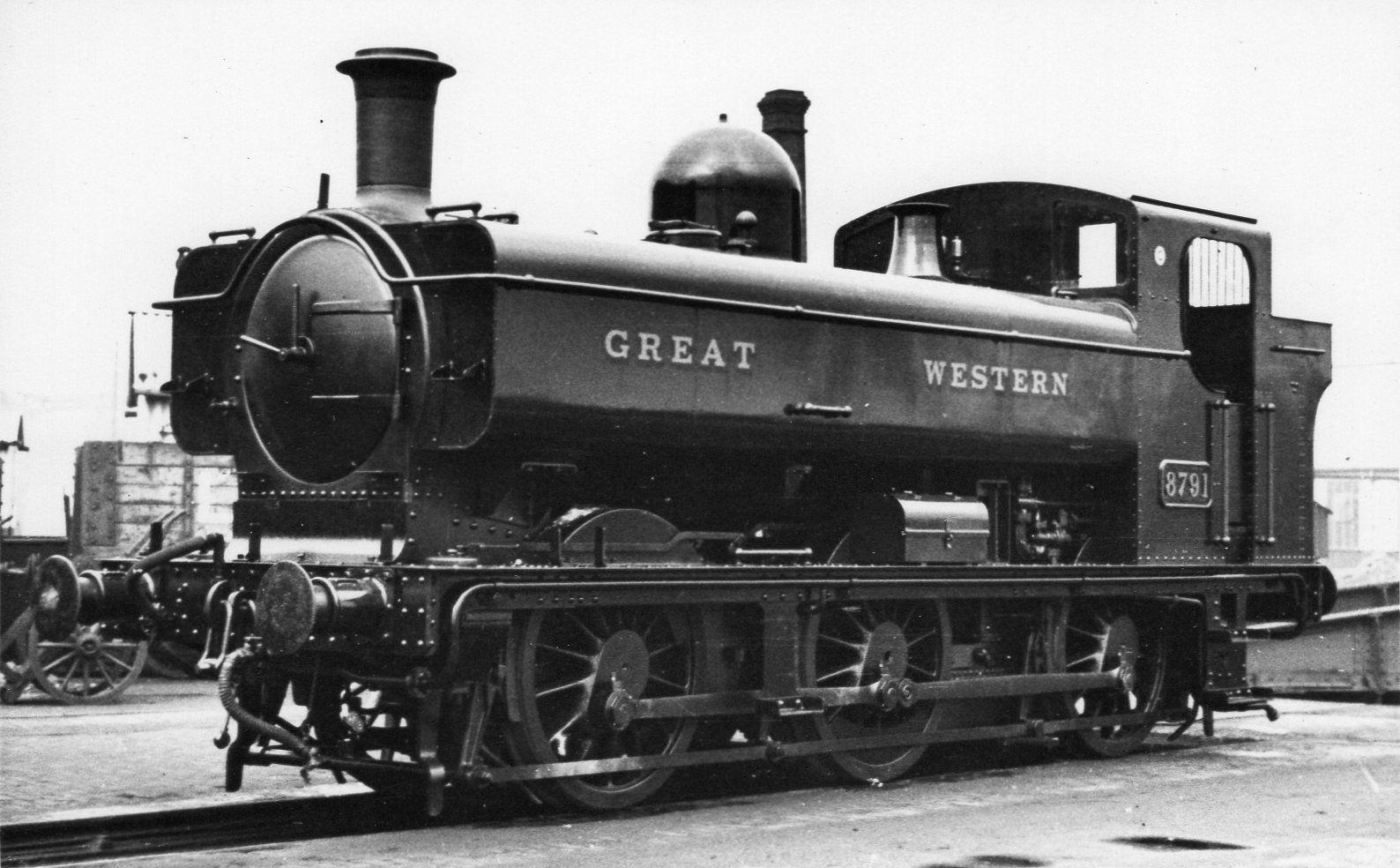
8791, ex-works at Swindon in 1934. Despite the 'official' livery of the time, the safety valve cover is unpainted brass. It is one of the last pannier tanks to receive 'GREAT WESTERN' insignia.
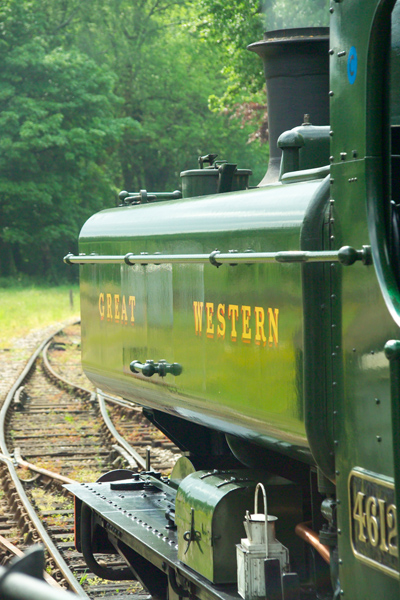
Preserved 4612 on the Dean Forest Railway. It was built in 1941/2, so never carried 'GREAT WESTERN' insignia in its GWR days. Photo from FreeFoto.com, and licensed for reuse under this Creative Commons Licence |
Introduction
When the GWR started to put Belpaire fireboxes on their 0-6-0 tank locomotives it seems that the saddle tanks they'd used up to that time were just too complicated to fabricate 1. Equally it seems they did not favour side tanks, which had only been used on two classes of 0-6-0, one of which was already being converted to saddle tanks. The concept was first seen on a rather strange 4-4-0 tank, number 1490 2, but the story of what were to become the Pannier tank classes starts much earlier.
In the earlier days of the GWR, Swindon built Broad gauge and Wolverhampton narrow (=standard) gauge locomotives. As the broad gauge faded, Swindon took on standard gauge as well – and indeed came to be dominated by Wolverhampton trained staff 3 but the two factories were very independent with their own design teams and practices.
There were many classes and types of pannier tanks, including various absorbed engines and small classes for special purposes. However, the predominant batches can be roughly divided into two main groups, large and small, and in both a line of development can be seen. In Victorian days there was a plethora of different classes, and for the purposes of this article much detail will be simplified and even omitted. Variations in boiler pressure, topfeed or superheating, number of tubes or dome position (or absence), size and shape of saddle tanks, shape of bunker and the like are beyond the scope of this document 4. |
Maintenance and its implications
The pre-grouping classes appear to exist in quite mind-numbing complexity and variety. A lot of the reason for this is based around maintenance practices. When a major overhaul was due the GWR would dismantle a locomotive virtually down to its component parts 5. The boiler in particular would take longer to repair than the rest of the locomotive, so by the beginning of the 20th century an alternative boiler (and matching water tanks) would be fitted as soon as the rest of the locomotive was ready in order to bring the locomotive back into service. Because of the interchangeability of boilers, this boiler might well not be the same design (or even class) as the one that came off. Thus a locomotive might be rebuilt with pannier tanks at one major overhaul, yet revert to saddle tanks at the next one, depending on what was available. Over the years the earlier boiler classes went out of use (no new Standard Goods, Sir Daniel or Metro boilers were built after the 1920s for instance) and so the amount of variation tended to reduce. Wolverhampton tended to go very much its own way in the 19th century, and a locomotive rebuilt at Wolverhampton would be appreciably different to one rebuilt at Swindon. In minor details like bunker shape this practice persisted as late as the 1920s.
Boilers
The RCTS volume on GWR 6-coupled tank engines lists well over 150 variations in boilers used on the classes mentioned in this piece. However, for our purposes we can list nine basic 'classes' 6 of boiler used on them.
Boilers seem to have been the subject of continuous development, especially during the Churchward era. It's a mistake to think that a P type constructed in 1880, pressed to 140psi with a round top firebox and 268 1½" tubes, had much in common with the last of the type, pressed to 200psi with Belpaire firebox, 219 1⅝" and two 5½" tubes, which were still being built as late as 1950.
Further information on boilers. |
| Large Classes |
| Class |
Name |
Barrel
length |
Barrel
diameter |
Firebox
length |
| O |
Standard Goods |
11' |
4'5" |
5'4" |
| P |
2301 |
10'3" |
4'5" |
5'4" |
| Q |
Sir Daniel |
11' |
4'3" |
5'4" |
| T |
Metro |
10'6" |
4'3" |
5'1" |
| K |
Standard 10 |
10'3" |
5' taper to 4'5" |
6' |
| Small Classes |
| R |
850 |
10' |
3'10" |
4' |
| U |
2021 |
10' |
3'10" |
5' |
| Q (later) |
Standard 16 |
10'1" |
3'10" |
5' |
| F (later) |
Standard 21 |
10'6" |
4'3" |
5'6" 7 |
|
Autofitting
Autogear for push-pull operation seems to have started being fitted as early as 1906, but became more widely fitted as the Steam Rail Motors started to go out of service. Available records suggest locomotives fitted with autogear at one major overhaul might have it removed at a subsequent one. I suspect that when an autofitted locomotive came into the shops then the gear might be removed and fitted on one just about to leave in order to maintain the desired number of autofitted locomotives in service. Of the smaller classes, the 2021 was most often autofitted, and 655 and 1076/1134 amongst the large wheel classes, but odd ones and twos of 1901, 1501 and 1016 classes received the gear from time to time. Thus there was a mixture of small and large classes fitted, although the large ones selected were among the less powerful types. As noted below the 'small' 5400 and 6400 Collett classes would have been equally capable as the 'large' 655 and 1134, and no 5700 or 9400s ever seem to have received the gear. When more powerful autofitted engines were required in BR days the equipment was fitted to some 4500 class small prairie 2-6-2 locomotives.
Rebuilding and updating
It's easy to think that, because few 0-6-0 tanks were nominally built under his charge, Churchward had no interest in the type. However, the RCTS volumes detail an immense amount of work on subtle and less subtle boiler changes, topfeed, superheating and so on. The conversions to pannier tanks started before 1914, but were very much as and when, with a very few retaining saddle tanks even after 1948. Many but not all were given enclosed cabs. Pannier tanks were designed to fit the boilers used, which varied over time as well, so it seems that quite a selection of different sized tanks, boilers and cabs could be seen at various times on locomotives that had started life in the same batch. It must have made life interesting for trainspotters, and makes life equally interesting and research essential for the discerning modeller. Through Churchward's time, and going on into Collett's, the earlier large tanks tended to receive larger boilers, mainly Q and then P units. An engine that had started out as the same class would have looked quite different with the longer and thinner Q class boiler than it would with the stumpier P class. Some of the earlier locomotives had very considerable increases in weight over the years – the early 302 class for instance, 35tons 13½cwt when built, weighed 43tons 2cwt in their final condition with P class boilers and other changes 8.
The GWR had an extensive program of superheating the later pre-grouping pannier tank classes, mainly in the earlier 1920s, but from 1930 the superheating started to be removed again, so presumably the disadvantages were considered to outweigh the advantages. None of the Collett/Hawksworth pannier tank classes, with the exception of the ten GWR-built 94xxs, were superheated.
Bunker capacity was another area of significant updating, and usually involved increasing the length of the frame at the rear. Early (side tank and saddle tank) locos had low coal capacities, but increased frame length and bunker capacities began to feature at a very early (c 1870) stage. Swindon and Wolverhampton bunker styles and practices differed, and the Dean locos underwent a continuous, but essentially ad hoc, programme of increasing bunker capacity throughout the Churchward era. Many locos, particularly of the 645 and 655 classes, retained their small Churchward bunkers because they were low-mileage shunting locos not needing to stray far from their sheds. A common bunker style would not be established until the early Collett era, although many of the earlier locos would be scrapped before receiving Collett bunkers.
Superheating history for the pre-grouping pannier classes in their later years can be deceptive.
655 class 2710's chimney is in the rear position, and the loco is saturated. It was superheated in May 1920, but reverted to a non-superheated boiler at a later stage, as shown here.
2721 class 2752, with its chimney in the forward position, has never been superheated, although it has been fitted with an S-shaped blastpipe casting used for locos that have been superheated. Any superheater elements in its boiler will have been removed. |
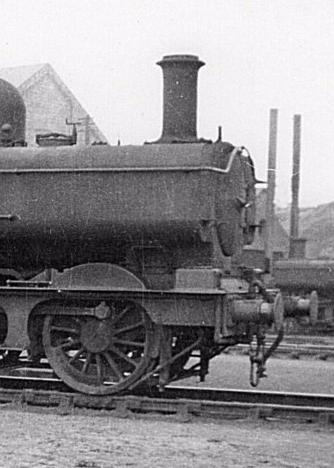
2710, late 1930s |
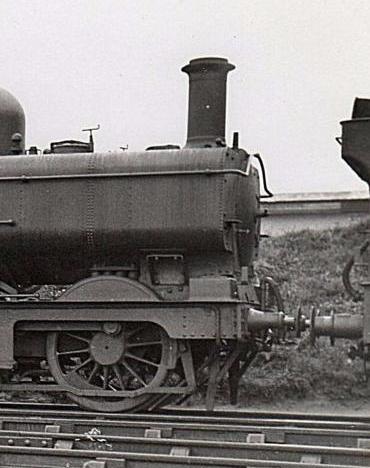
2752, 18 July 1936 |
Census of saddle tanks and pannier tanks, 1864–1966
A total of approximately 2380 standard gauge saddle and pannier tanks were built by the GWR/WR. The combined population (saddles plus panniers) peaked in June/July 1955 at 1285 locos. (Click on the graph for a larger version.)
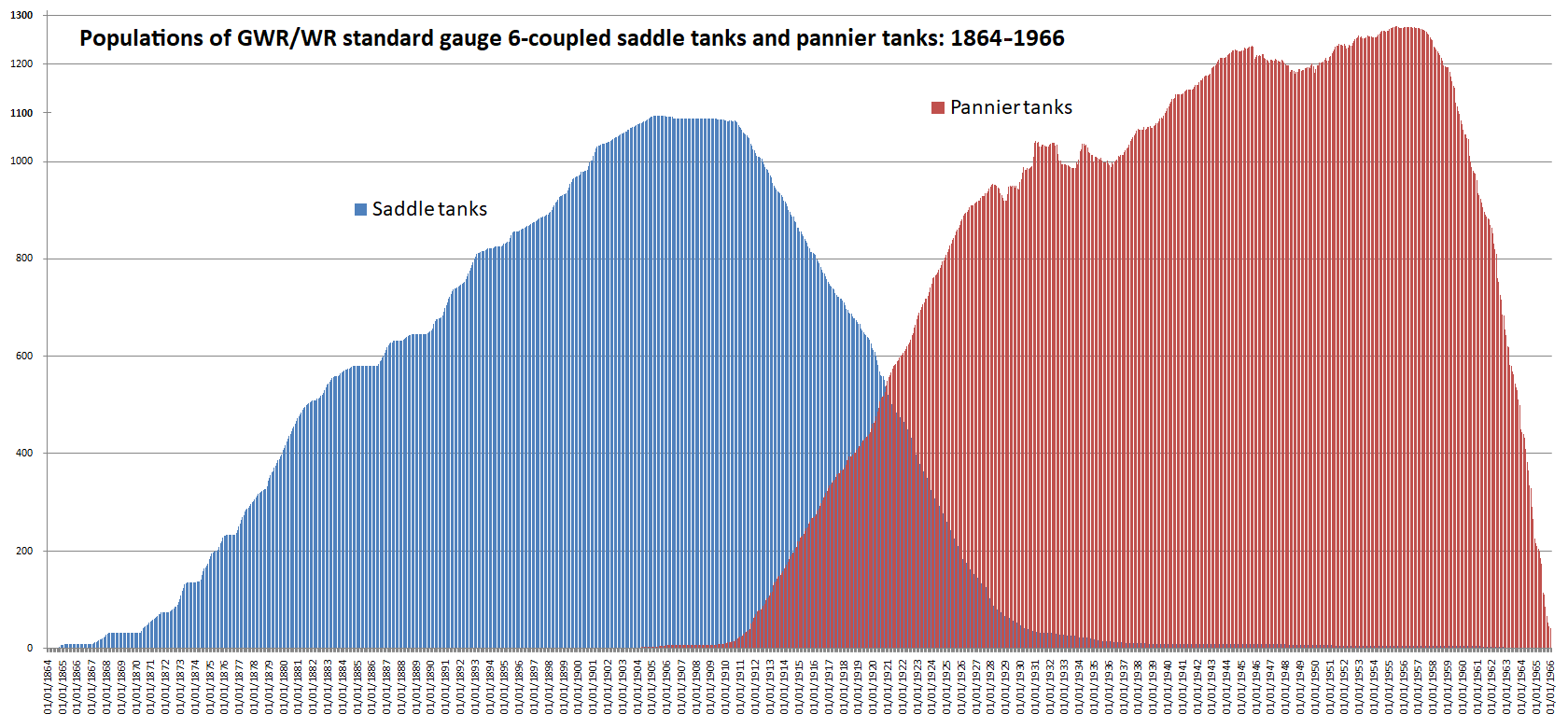
(Data for the census graph above is from RCTS Part 5 4 and BRdatabase. To keep the graph simple, the effects of those few locos reverting to saddle tanks and then back again to panniers, and the locos originating with side tanks for a short while (a few Buffalos and the 1813 class), have been ignored. Absorbed locos are not included in the survey.)
Saddle to pannier conversion dates indicate the benefit of panniers was considered important enough for the programme to continue throughout WWI, and many of the conversions in the 1920s and 1930s were done in the knowledge that the locos would last only a few years longer, or at least until the Collett pannier designs began to come on stream in significant numbers from 1929 onward. Of the approximately 1100 saddle tanks built, only 73 never received pannier tanks. (Off the scale of the graphic are the early 1813 class panniers of 1903–6 and 2021 class loco 2048, which was converted as late as 1948.)
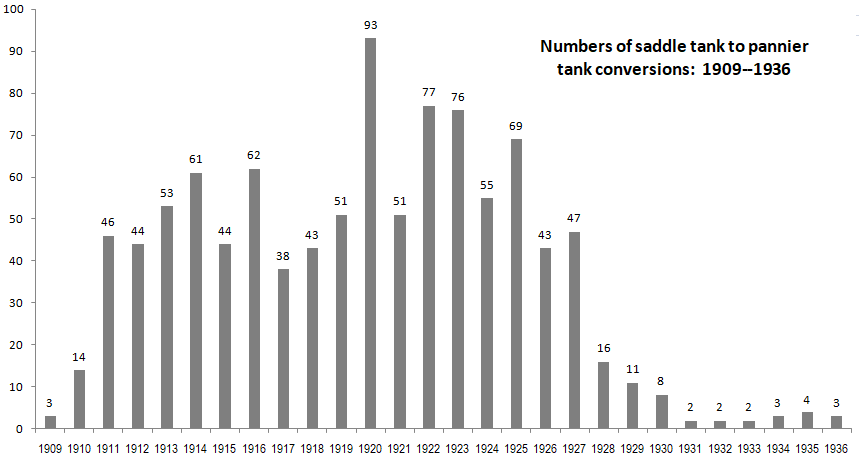
Large engines
Outside frames
Wolverhampton 302 and 1016 classes
The large tanks started with outside-framed saddle tank engines, all with the barest minimum of weather protection for the crew – just a spectacle plate and waist level cab sides. The progenitors started at Wolverhampton with the 302 class (1864/5) of eight engines, and its close successor the 60 locos of the 1016 class (1867–71). These had wheel spacing of 7'4" (leading) and 8'2", and wheels that started at 4'6" but were later fitted with thicker tyres to 4'7½". The 302s had 4'6" front overhang and 5'2" rear overhang, and the 1016s were somewhat longer: 5'3½" front and 5'11" rear.
Between 1878 and 1885 Wolverhampton also produced various conversions from tender engines including the 119 class of 11 and the 322 (with 5'2" wheels) class of six. Some were converted back to tender engines, but the others survived to gain pannier tanks in the fullness of time.
The original boilers were similar to but smaller in diameter than the Q class. They first received Belpaire Q class boilers from 1911 and then P class from 1922. Pannier tanks appeared with the Belpaire fireboxes. All but 11 of the 1016 were eventually fitted with pannier tanks. Some of the later survivors received larger bunkers and enclosed cabs. They were mostly scrapped in the 1920s and early 1930s, with the last survivor (1047) going in summer 1935.

1051 in near-original condition with a short low-capacity (880 gallons) saddle tank of five unequal segments. The filler is barely discernible on top of the rearmost tank segment. Even at this comparatively early stage, the cab and bunker have been Swindonised and a Swindon chimney has been fitted. The cab has however kept its original narrow width. Note how slender the rods are.
| 1029 at Aberdare in 1905, with a 6-segment tank and a front-ring S2 boiler, with a filler toward the rear of the tank. It has been spruced up for passenger work. |
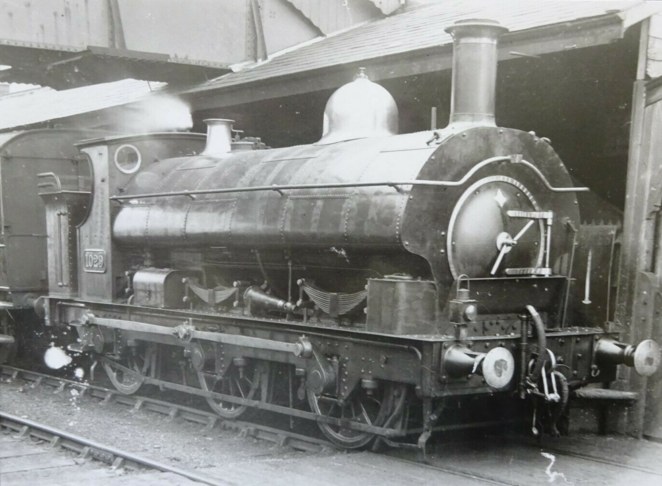 |

1042 fitted with a later standard 3-segment tank with a filler on the front segment, c 1905. The frame has been extended at the rear for the enlarged bunker, which was unusual at this early date. The cab and bunker are lined, but the tank is not.

1026, one of the first batch of the 1016 class, at Reading shed on 18 October 1919, shortly after being fitted with a Q class boiler and small pannier tanks.
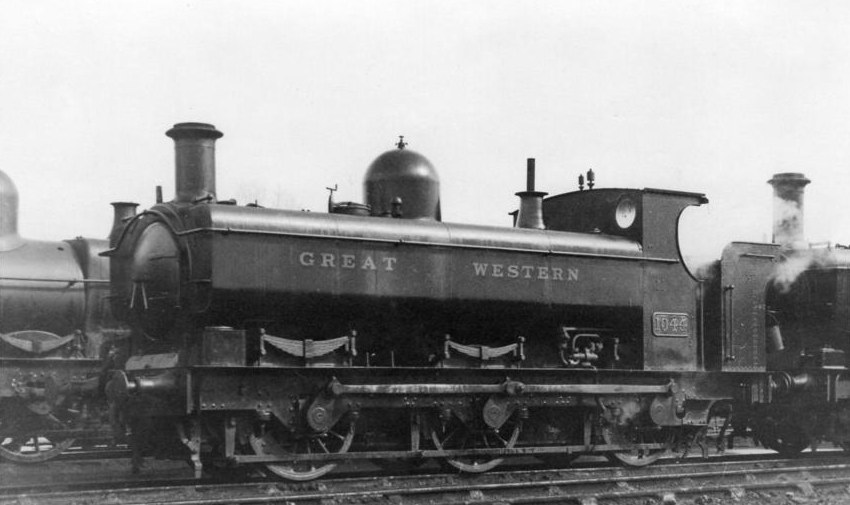
1044, fitted with a P class boiler and large (flush-riveted) tanks and a Collett smokebox. Domes on P class boilers were a larger diameter than those on Q class boilers. The frame has been extended at the rear for the Collett bunker. Oxford, 9 April 1927

Towards the end of its life, open-cabbed 1054 retains its Churchward bunker. This has a P class boiler and large tanks. A small handrail to assist accessing the filler has not been fitted, despite the large tanks.
| 1047, the last survivor of its class, with a P class boiler and large tanks. It has acquired a Collett smokebox, a capuchon chimney and some Collett parallel body buffers in its final days, but has kept its Wolverhampton bunker and simple injector. It was withdrawn in July 1935. |
 |
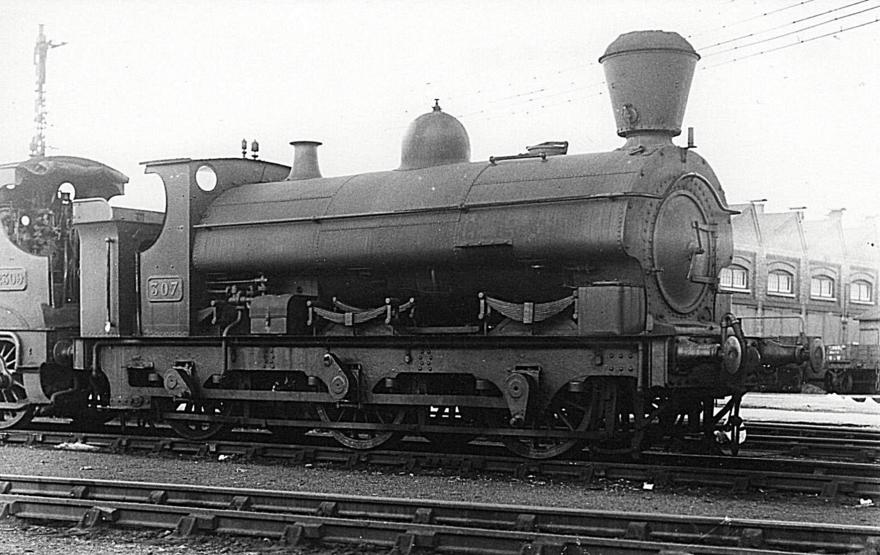
307, one of the small number (eight) of the 302 class, receiving attention at Swindon on 11 September 1927. It was allocated to Didcot at the time, and fitted with a spark-arrester ('busby') for working the Didcot Ordnance Depot. This particular loco received pannier tanks in 1916, but reverted to a saddle tank later. The class had a distinctive form of slotted frames. The inner frame springs of the middle axle are mounted above the axle, and this unusual feature can also be seen in the 1054 picture above. The loco would re-emerge with large pannier tanks a few weeks after this photograph was taken.
Swindon 1076/1134 Class
Swindon chimed in with the 1076 class in 1870. The first six (1076–1081) had side tanks, 4'9" front overhang and 5'2" rear overhang, and had boilers similar to but smaller in diameter than Q class. They were followed by the 50 of the 727 class of 1872/3 (locos 727–756 and 947–966), substantially similar but with short saddle tanks and 6' rear overhang. The 6' rear overhang was continued with subsequent lots of short saddle tanks (locos 1134–1153 and 1166–1185), whilst the remainder of the class (1228–1297, 1561–1660) had 6'9" rear overhangs. Some of the class ran on the Broad gauge for a while, which necessitated the wheels being outside the now inside frames. By 1878 they were being turned out with open cabs and short cab roofs. Middle batches had O or Q class boilers and some of the last batches a shorter boiler, which was closer to the P class. These three classes tended to merge over the years, and are often treated as one. Loco 1134 was named 'Buffalo' shortly after construction, and this became the soubriquet for the whole class. With a total class membership of 266, it is perhaps not surprising there was so much variation over their lifetime.

1077 in original condition with side tanks. It was rebuilt with pannier tanks in 1918.
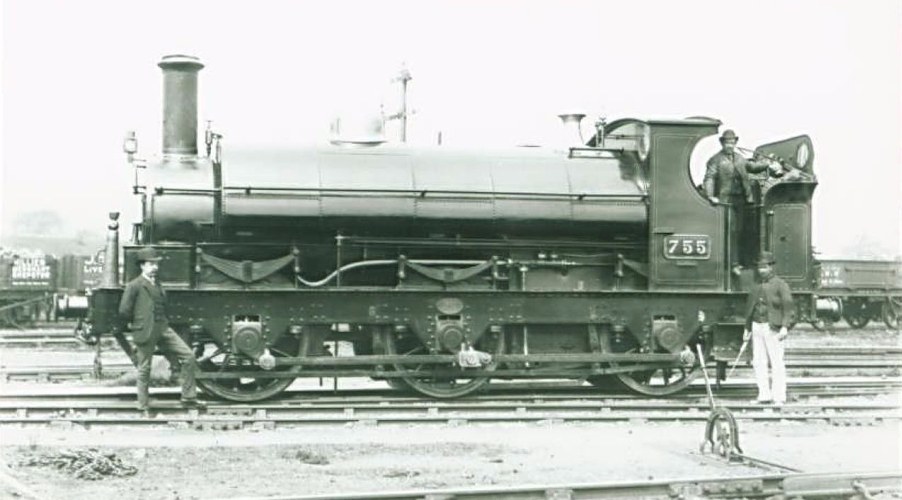
755, of the initial 727 class with a shorter saddle tank, in very early condition, with a rear weathershield fitted. It would eventually receive pannier tanks in January 1918.

An immaculate 1173 with a six-segment tank, possibly in November 1902 after receiving an S4 boiler. No toolbox is apparent, and the injector is of an early form in a forward position, feeding the boiler through side clacks. The shape of the safety valve cover is more curvy than the later standard shape, with a more generous radius to the underside of the top flare. The dome is a low, small one. The filler is at the rear. Worksplates were fitted on the frames above the centre axle on early engines. The couplings seem to be an early 5-link form. No lining is discernible. It would receive pannier tanks in October 1914.

1572 with a five-segment saddle tank, tall chimney and open coal rails on the bunker. The filler is on the second tank segment. The cab and bunker are lined, but the tank is not. Probably between 1900–5. It was fitted with pannier tanks in April 1914.
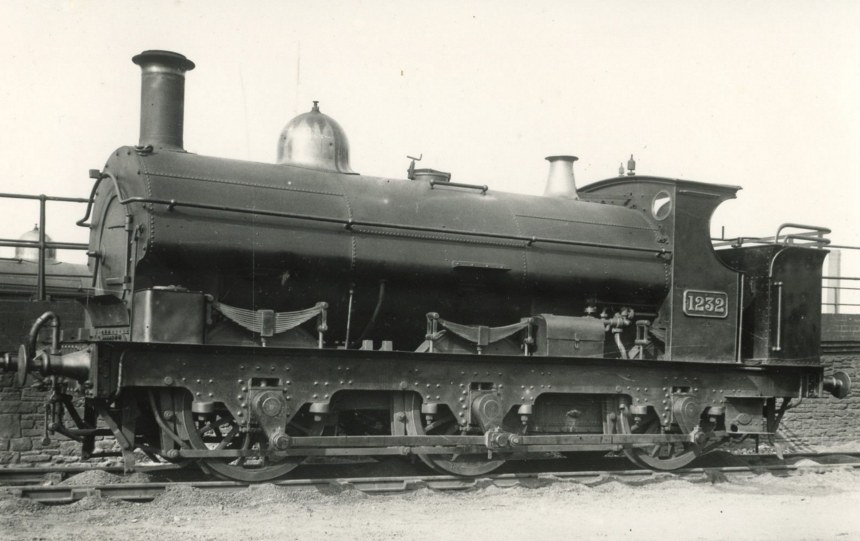
1232, with a later standard three-segment tank but a dome on the front ring, pictured prior to WWI. The lamp sockets are old style, so this picture could be earlier than 1905. It would receive a backring boiler saddle tank in March 1915 and pannier tanks in 1923. These tall chimneys on saddle tanks disappeared about 1920. The water-balancing pipe on saddle tanks was a lot smaller compared to the larger size fitted under pannier tanks.
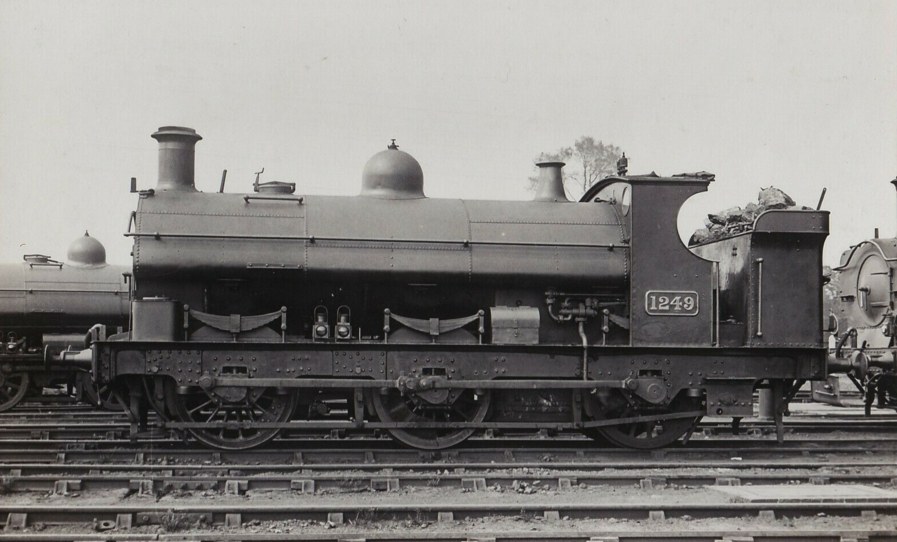
A clean 1249, pictured probably toward the end or just after the end of WWI. It has already begun to acquire some frame-strengthening patches. The chimney is now a medium-height one, which was the later standard for Buffalo saddle tanks.
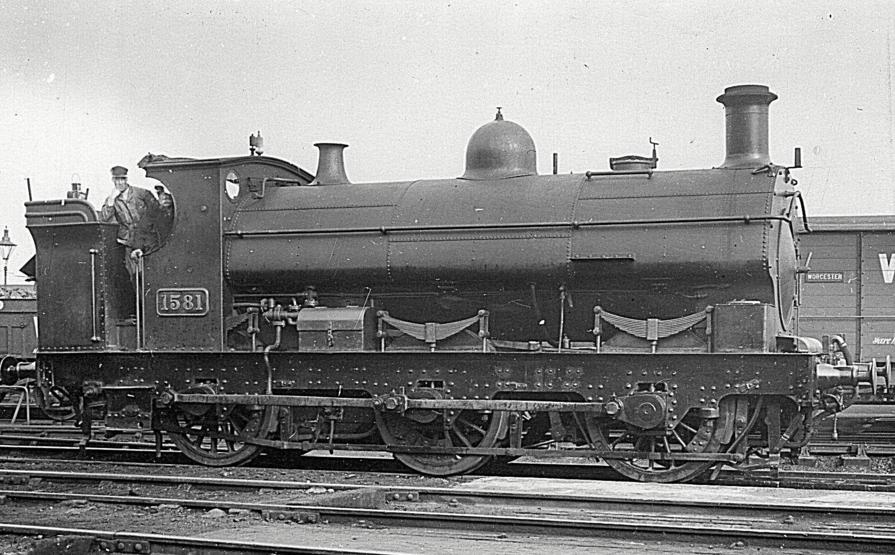
1581, with the later standard three-segment tank and a medium-height chimney, at Worcester in April 1923. 1581 was one of the few Buffalos never to be fitted with pannier tanks, and lasted until 1929.

In its final saddle tank form before being fitted with panniers in February 1924, a buffed up 1176 is at Exeter, and probably a station pilot. The date is thought to be c 1920.
| 737, one of the 727 class, seen here in the mid-1920s and looking more like a regular Buffalo with a full-length tank, but it retains its original short bunker. It received pannier tanks in October 1927. |
 |
Locos of this class tended to receive 6'6¾" pitch Q class boilers from the end of the 19th century, and Belpaire fireboxes and pannier tanks from 1911. The tanks fitted to the Q class boilered locos were nominally 1000g capacity. About half the class received enclosed cabs with larger bunkers in the 1920s and many of the rest just the enlarged bunkers.
Nineteen 22 received the higher-pitched (6'11¾") O class boiler in the early 1920s and some 23 of the later survivors received the larger P class boilers (also of 6'11¾" pitch) from 1925. Over 20 of the class received topfeed boilers at various times, and over 20 were autofitted at various times. Most of the locos surviving beyond 1930 were fitted with ATC. The O and Q class boilered locos had 7'5" wide bodies on 7'11" wide footplates. The later P class locos featured wider footplates (8'6") and wider tanks, cabs and bunkers (8').
Class members were mostly withdrawn between 1928 and 1939, but three survived the war, with 1287 being used as a stationary boiler until 1953.
The four sketches adjacent illustrate some of the changes and variations made to the 1076 class.
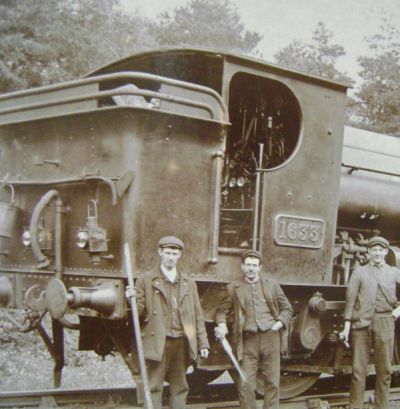
RCTS records that approximately 85 Buffalos were fitted with extended cab roofs. These cabs remained open at the back to allow room for fire irons to be used. The scarcity of photographic evidence of these extended cab roofs suggests they were removed and reverted to a normal open cab state at an early stage. |
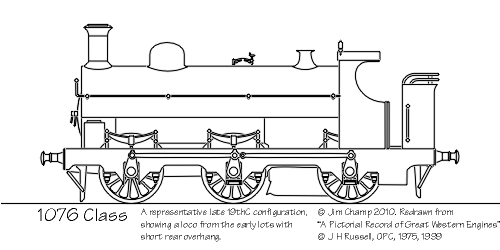
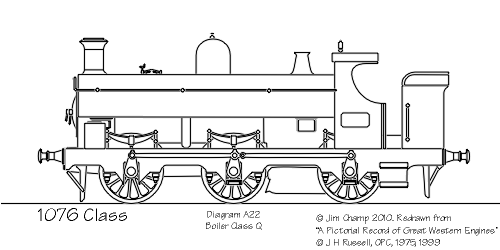
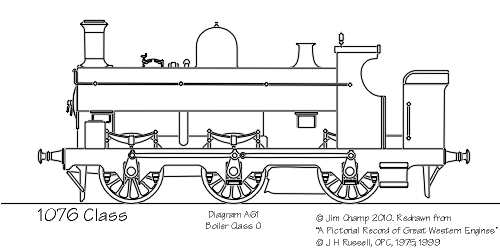
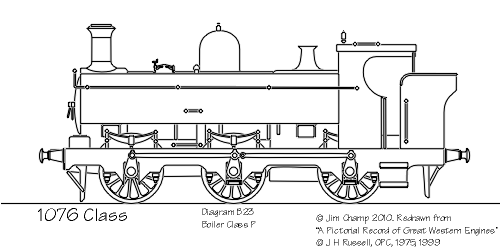
|
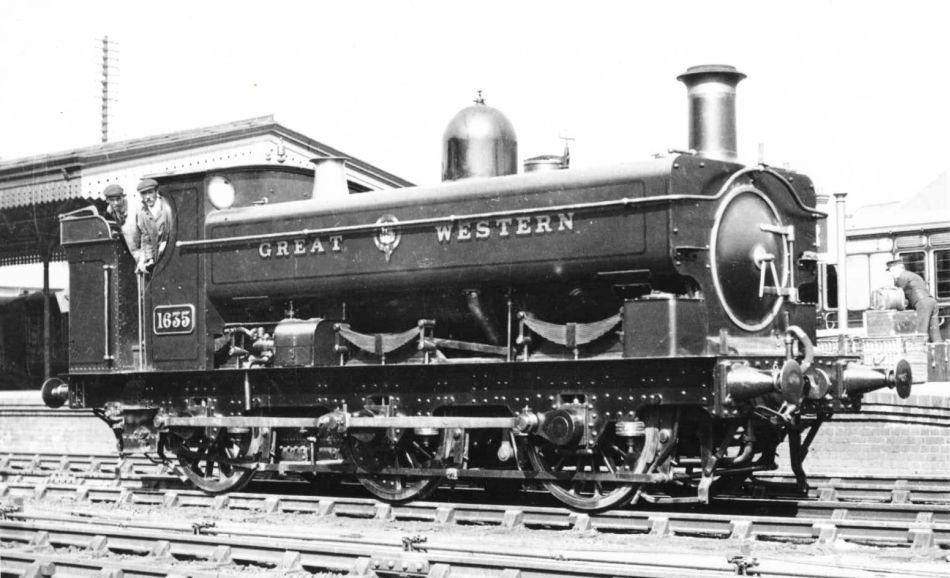
1635 shortly after being fitted with pannier tanks in August 1911. Tanks, cab and bunker are lined, but no lining below the footplate is apparent. The spring shackles, handrails, smokebox door rim, hinges and handles have been burnished, a level of finish usually reserved for express passenger locos. It is not clear why some locos were lined after receiving pannier tanks, possibly they were earmarked for passenger service, or station pilot use, or merely because early pannier tanks were considered prestigious at the time. The Garter Crest never suited pannier tanks, being partially obscured by the handrail. It is probable this Garter Crest would not survive the loco's first repaint.
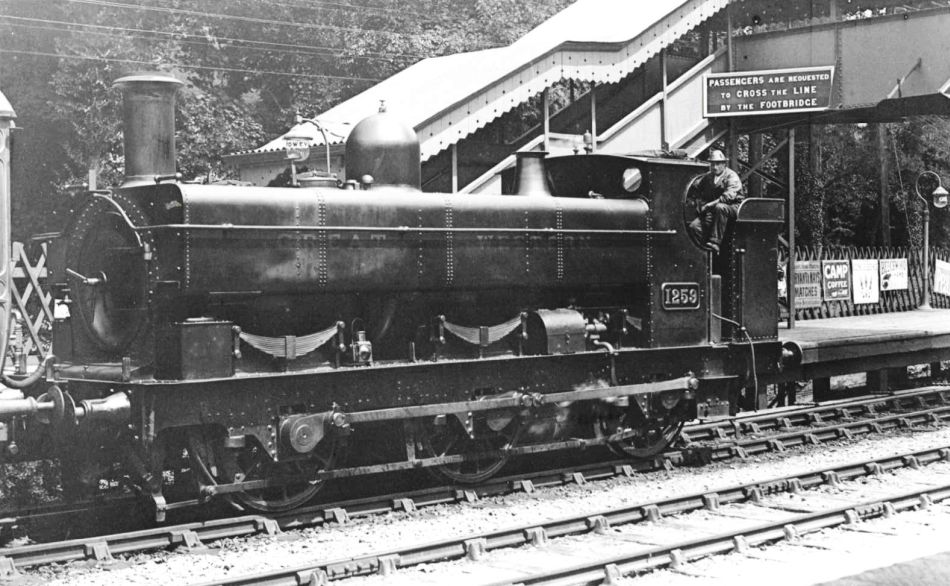
1259 at Fowey, 7 July 1921, with a passenger train, probably from Newquay. The loco was one of four Buffalos shedded at St Blazey at the time, and had been converted from a saddle tank about a year before. In those days, Fowey had a footbridge. The platform fencing and the station lamps are not of a recognised GWR style. The middle road is inside-keyed with 15' rail lengths.

Not long before its withdrawal in 1925, 1249's frames have acquired a bunch of strengthening patches.
| 751, fitted with pannier tanks since 1915, gets a new lease of life in 1929 with an enclosed cab and new bunker, but would be withdrawn a couple of years later. |
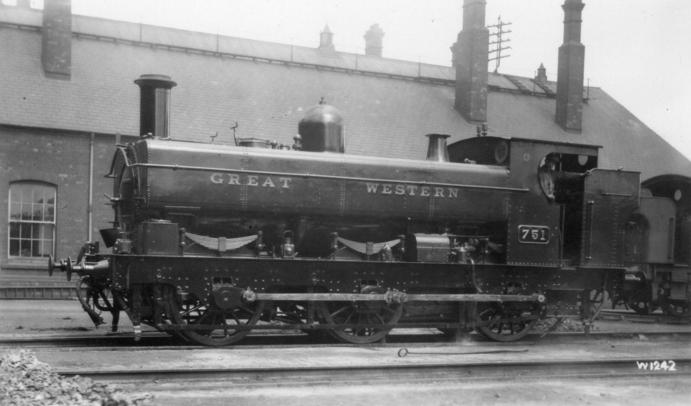 |

960, pictured between August 1924 when it received pannier tanks and its withdrawal in May 1932.
| 1080 received pannier tanks in 1927, and is seen here at Tyseley in 1929. It was one of the original six side tank locos, and seems to have retained its short rear overhang. |
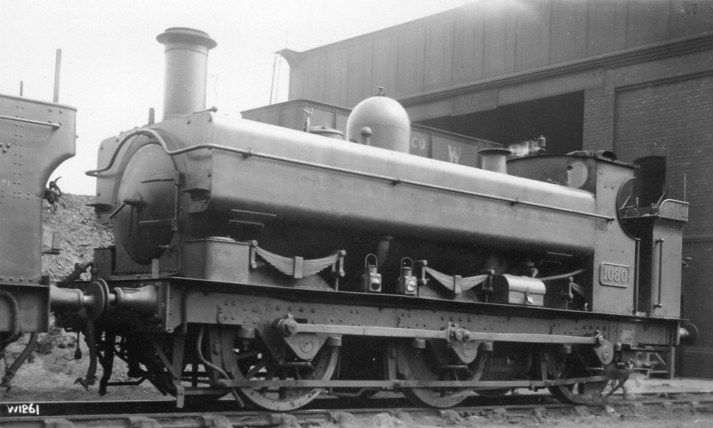 |
| Rear view of 1176 (at Exeter, 1930), showing the vacuum pipe on the right-hand side. |
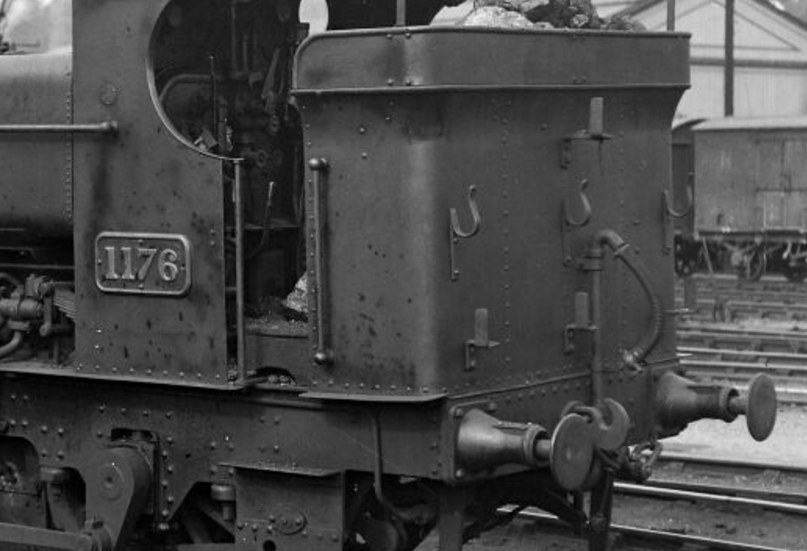 |
| Buffalo tank, number unknown, but typical of a Q class boiler open-cab engine with a late form of Collett bunker. This particular engine has picked up a wider than usual front buffer beam. |
 |
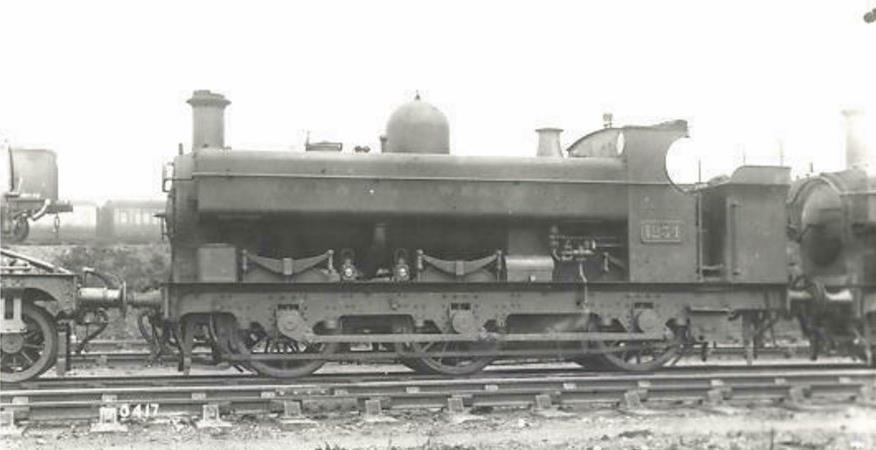
Proving that Swindon could make just about anything from its large trove, 1234 (pictured at Newport) has a high-pitched O class superheated boiler with a smokebox extending proud of the tanks. It existed in this form from November 1928 to June 1933, after which it reverted to a normal length Q class boiler. The O class boiler locos had larger diameter domes, and can be spotted by the tank handrail aligning with the top of the bunkerside flare.
| Autofitted 1256 at Plymouth Millbay. It has a high-pitched O class boiler, and a large diameter Armstrong smokebox door. Date unknown, but after it was autofitted in November 1928, and could be before or after it was superheated in September 1933. It was withdrawn in January 1936. |
 |

Although several Buffalos had been autofitted from 1915, there was a specific programme starting in the mid-1920s, intended primarily for locos working in the Plymouth area, which involved fitting screw reverse. The locos included: 738, 1147, 1167, 1168, 1234/5/52/65/9/71/84, 1567/70/1600. Some of these locos were probably autofitted prior to this programme, and 1271, pictured here, had in fact been the first recorded autofitted Buffalo in 1915 (when still a saddle tank). These locos were fitted with enclosed cabs with characteristic rectangular windows in their fronts, and most of them received extended tanks and smokeboxes, as shown on 1271, at a later stage (usually c 1930). ATC was fitted c 1930–1. The extended smokeboxes could feature either Collett fronts and smokebox doors, or retain the original Churchward features. The locos were fitted with larger-diameter (16") Collett buffer heads, reflecting the increasing adoption of that size for many locos working with long autotrailers from the mid-1920s onwards. The larger 16" heads were bolt-ons to the Dean buffer heads. Like other autofitted locos of the era, there is a packing piece between the buffer stock and the headstock, which increased the buffer length by approx 1.5". The autofitted Buffalos disappeared in 1937, being superseded by members of the 64xx class.
| Autofitted 1235 near Laira on 1 May 1925. The loco still has its original length tanks at this time. |
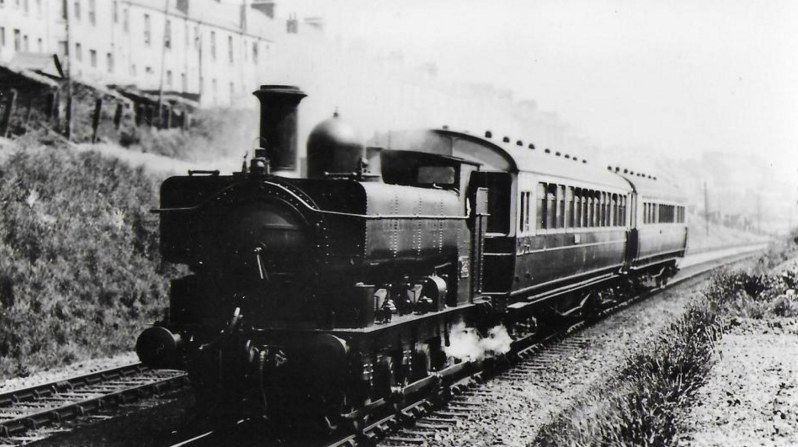 |
| Autofitted 1600, illustrating the extended smokebox and tanks, and the rectangular windows in the front of the cab. |
 |
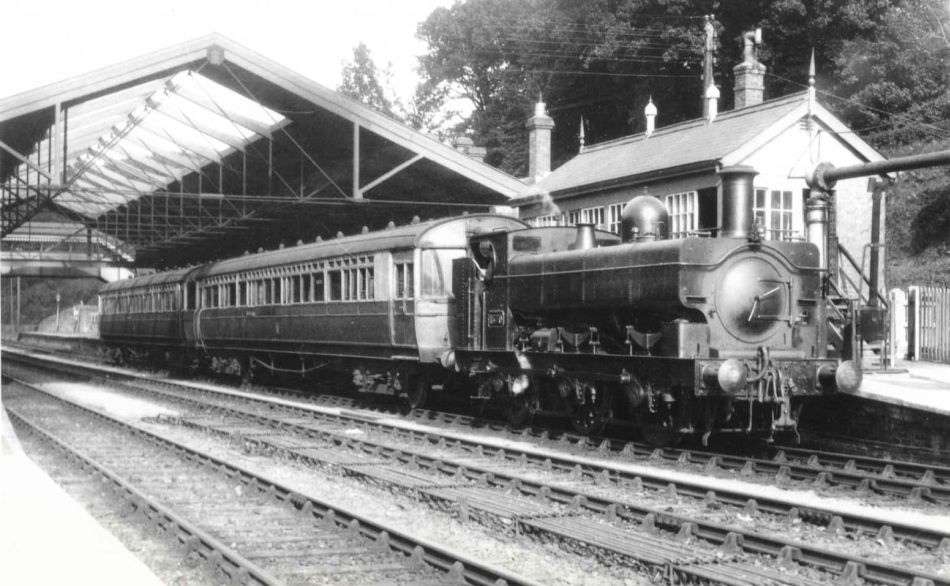
1570 at Tavistock on a Plymouth auto, 1931. The picture was taken by Dr Ian C Allen, a well-known photographer of the time, and appeared in Great Western Album (Ian Allan), by Dick Riley. The loco is a good example of how quickly the early tanks were changing in appearance around this time. It received panniers in November 1925 (possibly with an enclosed cab), was fitted with screw-reverse in December 1928 (with a new or another cab revision with rectangular front windows), ATC probably fitted c 1930 (on Buffalos it seems to have been located at the rear), and within a year of this photo, when pictured at Yelverton, had been fitted with an extended smokebox and extended tanks. It was eventually withdrawn in October 1935, being supplanted by the new 64xx locos.
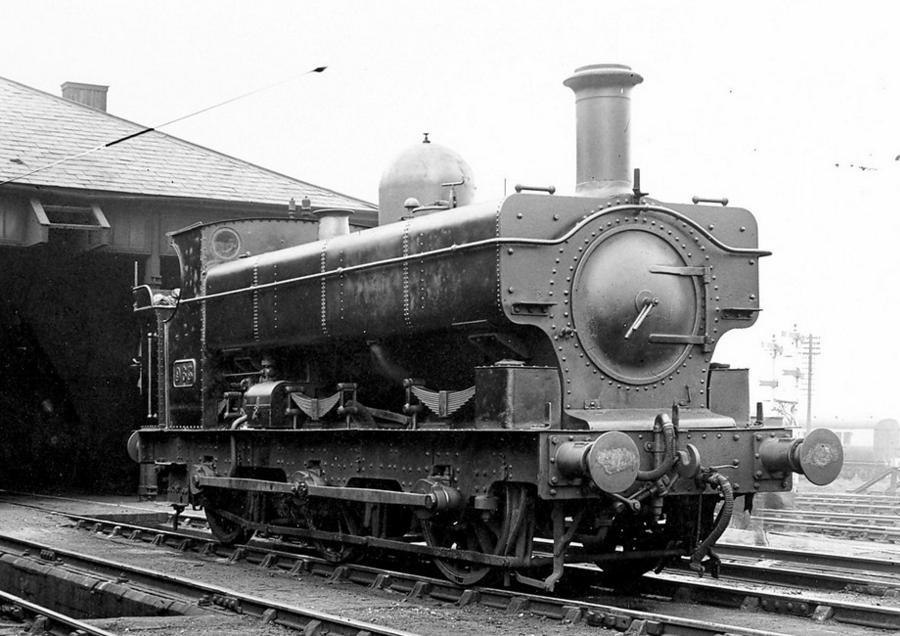
With a high-pitched O class boiler (fitted in 1922), 963 is in its last months at Pontypool Road shed in 1935. The loco has acquired a set of Collett parallel-body buffers, and the dome is of a large diameter, which was normal for this class of boiler. It was withdrawn the following year.
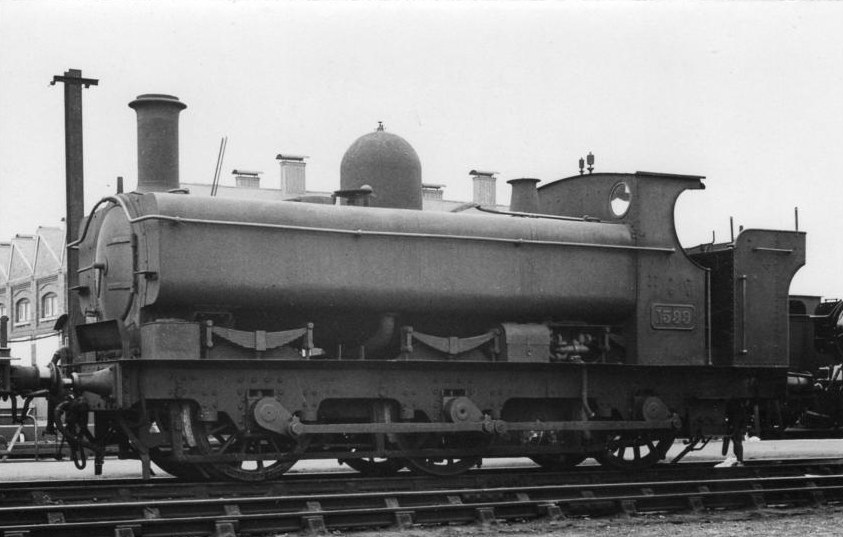
A dozen 23 Buffalos were fitted with P class boilers and large (1200g) tanks between 1925 and 1930. These can be distinguished from the Q class boilered locos by their boiler tops being proud of the tank tops, the Q class boiler locos being 'flat-tops'. Some of these locos had enclosed cabs, others did not. These locos were significantly wider (tanks, cab, bunker), at 8', compared to the 7'5" body width of other Buffalos, and they had 8'6"-wide footplates. In effect, the footplate and everything above it was a set of 2721 class parts, which was the contemporary 'standard'. They were the largest and heaviest Buffalos, with the middle axle weight encroaching into the 'blue' category, but apparently these locos were kept in the yellow route restriction category. 1599 is in its last days, at Swindon, 28 June 1936.
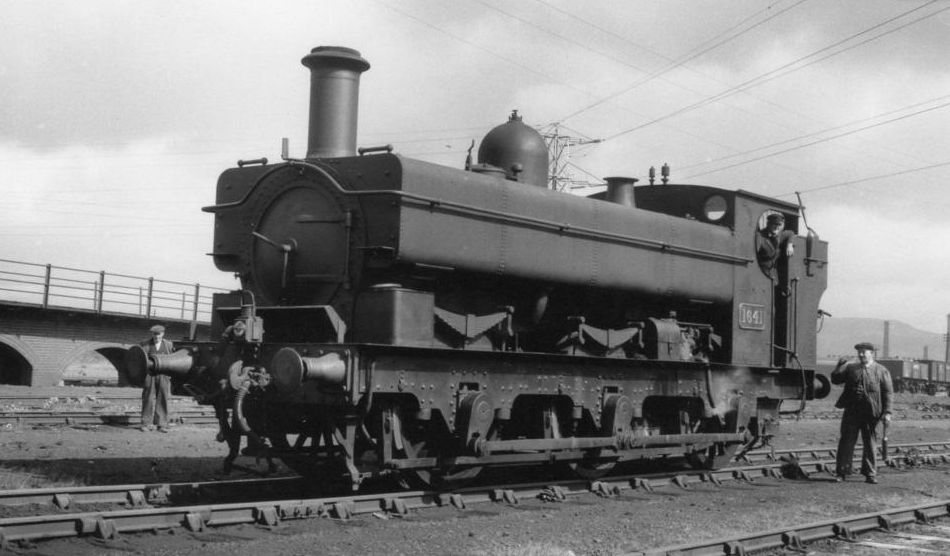
A late survivor – 1641 at Neath shed yard on 17 August 1937
Swindon 1661 Class
A variation was the 1661 class 'production line' conversions of 40 2361 class 0-6-0 tender engines in 1886. The 1661s were the tank engine version of the 2361 class, and had the 7'9" + 8'0" wheelbase and 5'2" wheels of the 2361 class. The front overhang was 4'7" and the rear 6'4¼". They had open cabs initially, and boilers similar to the P class, and can be readily distinguished by their underslung springs and the hangars below the footplate on the outside of the frames. Some saddle tanks were fitted with extended smokeboxes/tanks. The saddle tanks were 1080g capacity, and the later pannier tanks were 1095g. The 5'2" wheels meant the boiler pitch rose to 7'3". The chimney tops on the pannier locos were over 13' high. The body width remained at 7'5" when fitted with pannier tanks.
These locos do not seem to have been greatly liked, and several were sold off to Welsh lines, only to return at the grouping. Belpaire boilers started appearing around 1901, and pannier tanks about 1914. About half got enclosed cabs and/or enlarged fireboxes. They were scrapped early, mostly in the late 1920s, the last going in 1934. At nearly 48tons when full, these locos were some of the largest and heaviest of the outside-framed panniers, and spent most of their lives hauling heavy coal trains.
| 1680 in original condition, with an S2 front-ring boiler, a six segment tank, a tall dome and a tall filler. Only one tank step and handrail are present. The picture is prior to 1903 (when it received an S4 boiler). It would receive pannier tanks in October 1921. |
 |
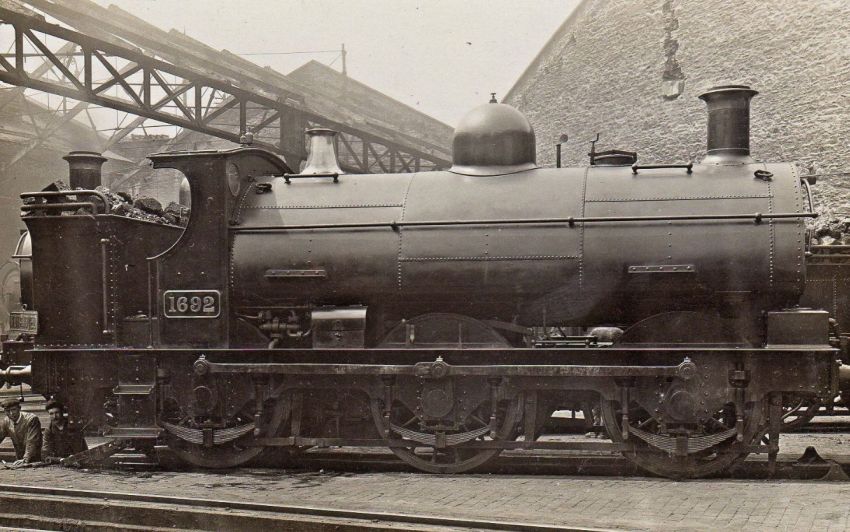
1692, with an extended smokebox and a three (and a bit) segment tank. The cab and bunker are lined. There are two steps and two upper handrails on each side of the tank. 1692 was withdrawn in 1911, never having received pannier tanks.

1673, above, with open cab, Churchward bunker, and flush-riveted tanks, and below, 1688 at Oxford on 9 April 1927 with snaphead-riveted tanks, enclosed cab, Collett bunker and Collett smokebox. 1688 and 1693 (below) have cranks with larger bosses, fitted presumably to cope better with the higher torque needed on the large wheels.
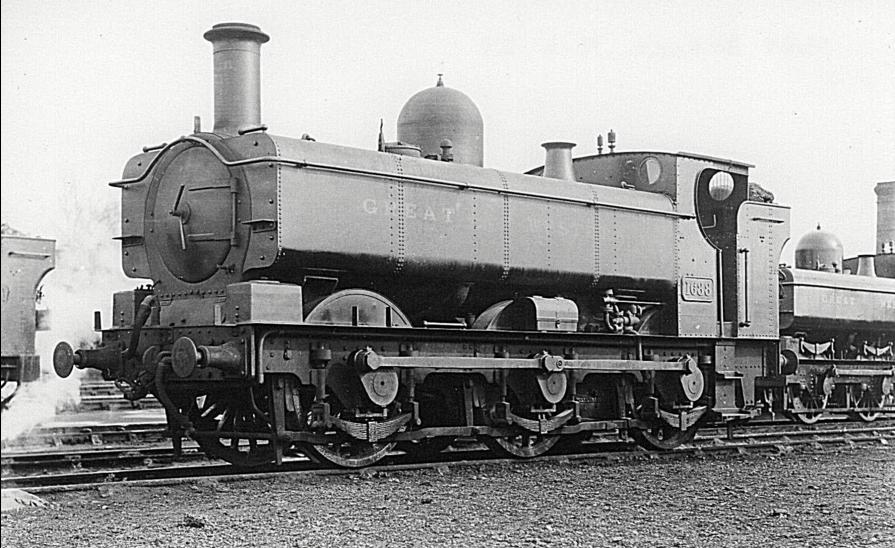

Nearing the end of its life, 1693 at an unknown location. It has a topfeed boiler, but it is not known whether the feed pipes appear directly from the side of the boiler beneath the topfeed location or are routed on the top of the tank. 1693 and 1688 above have not received small handrails on the tanks to assist accessing the filler.
Wolverhampton/Swindon 119 Class
This small class of eleven locos had a complicated history, some originating as tender engines in 1861 to a Daniel Gooch design. They were later converted to saddle tanks, some with condensing gear, at Wolverhampton during the Armstrong era, and were finally fitted with pannier tanks from 1913, usually fitted at Swindon. Most had been withdrawn by 1928, the last one (120) surviving until 1933.
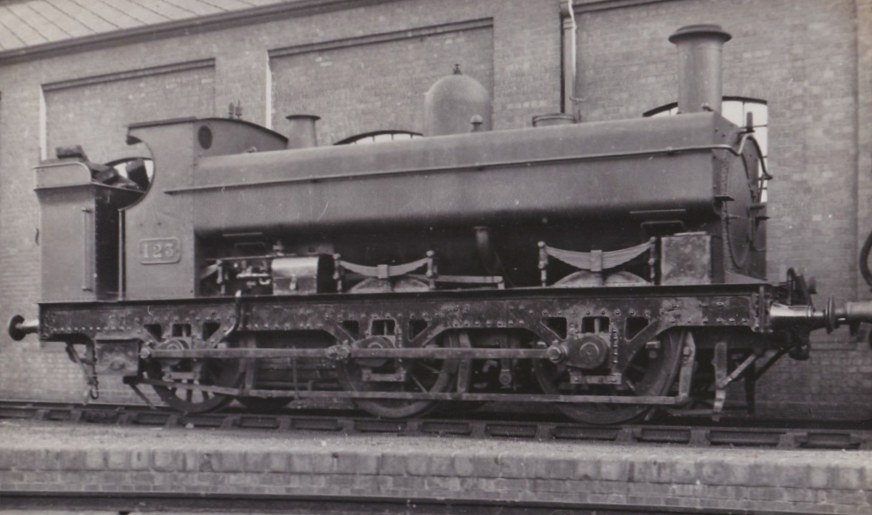
123 at Newport, 10 October 1926

124 at Old Oak Common, 21 March 1921. It has been fitted with tiebars between the hornguides.
Wolverhampton/Swindon 322 Class
This small class of six tanks originated as Beyer Peacock tender locos built in the 1860s. These tank conversions first appeared in 1878, and received various types of boiler and saddle tanks. Wheels were 5' diameter (later 5'2"), and tank capacities varied between 1040g and 1100g. All but one were fitted with pannier tanks from 1918 onward, with Q class belpaire boilers, and most received P class boilers from 1924, with larger tanks of 1200g capacity. One loco received an enclosed cab, but all had been withdrawn by 1932.

326, in early form after being converted from a tender loco. Note the non-round spectacle shape.
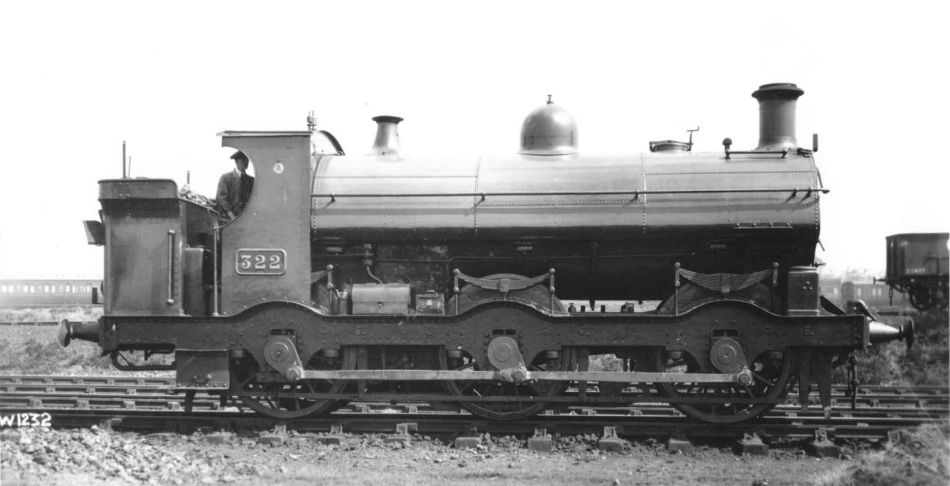
322, c 1922, with a medium-height chimney. It was the only one of the class fitted with a back dome S4 boiler, and received panniers in April 1925.

322 at Tyseley, in its final post-1925 form with a P class boiler, large tanks, cast chimney, enclosed cab and Collett parallel-body buffers. It was withdrawn in October 1930.
Inside frames
Wolverhampton 645/1501 and 655 Classes
Inside frames started with the Wolverhampton 4'6"-wheeled 633 side tank class, which never acquired saddle or pannier tanks so are not strictly part of our tale. Some of these were fitted with condensing apparatus for use on the Metropolitan & District underground lines in London, and curiously these were never fitted with cabs.
The 645 Class of 1872, again 7'3" + 8'3" wheelbase with 4'7½" wheels came next, followed by the 1501 subclass from 1878. A significant variation between these subclasses was bunker size. Early 645s had a 5'3" rear overhang, short saddle tanks and a small bunker. This overhang increased to 5'9" with the first locos of the 1501 series. All these had a 4'8" front overhang. The 645 were built without cabs, and received a basic cab at the end of the 19th century. They had T class boilers. There were 32 645 (plus a few sold to other companies) and 72 1501s, which had more conventional saddle tanks and open cabs from new.
The 32 members of the 655 class, last of the large Wolverhampton engines, followed from 1892, and were larger again with a 5' front overhang and 6' rear. Again, they were built with T class boilers. A further 20 locos appeared as the 2701 subclass in 1896–97, and were dimensionally similar to the 655s.
Some 645/1501 received lengthened frames and bunkers, tending to merge them with the 655 class. Brake rods on the 645 and 655 classes were behind the wheels, which was standard Wolverhampton practice, but some locos gained outside-wheel brake rods in later years. The capacity of the saddle tanks was typically 1180g. P Class boilers appeared from 1902, some with saddle tanks. Pannier tanks were introduced from about 1913, and were 1200g capacity. As built, front guard irons followed standard Wolverhampton practice of being small lower extensions to the front brake hangers, but some locos acquired seperate and stronger Swindon-style guard irons in later years. Around 15 received enclosed cabs. Most were scrapped in the 1930s, but a few survived the war and even into the first year or two of British Railways.
Although pannier tanks did not appear before 1913, some 1501 class locos (1501, 1516, 1517, 1521, 1523, 1542) received B4 Belpaire fireboxes when those locos got new 3-segment saddle tanks in 1904–6. When pannier tanks began to be fitted, 1519, 1549, 1554 and 1811 retained their S4 boilers for a while, as did 645 class 764 (panniers fitted July 1913).
655s tended to receive P class Belpaire boilers and pannier tanks a little later than the 645s. Some were scrapped in the 1930s, but most survived the war. Some 21 made it onto the BR books and the last were scrapped in 1950. |
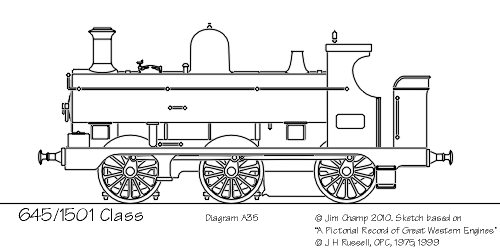
645/1501 class with an open cab
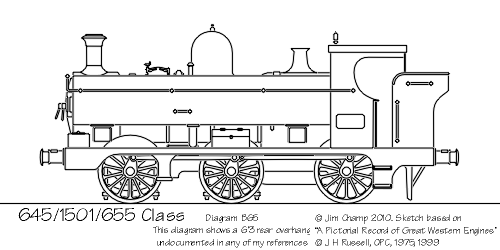
655 class with enclosed cab and extended bunker |
| Dimensional summary for 645, 1501, 655 and 2701 classes |
| Class |
Built |
Qty |
Numbers |
Front overhang |
Rear overhang |
| 645 |
1872–73 |
35 |
645–654, 656, 757–766, 768–775 |
4'8" |
5'3"
(6'4" for later frame extensions) |
| 1501 |
1878–81 |
72 |
1501–60, 1801–12 |
4'8" |
5'9"
(6'4" for later frame extensions) |
| 655 ('1741') |
1892–94 |
32 |
655, 767, 1741–50, 1771–90 |
5'0" |
6'0"
(6'6" for later frame extensions) |
| 2701 |
1896–97 |
20 |
2701–20 |
4'8" |
6'0" |

772, of the 645 class, in near original condition with a short tank, Wolverhampton rolltop tapered chimney, original lamp sockets and full lining. The boiler is a 'W3 small dome'. Note the style of 'between spoke' wheel balance weights. The Wolverhampton rolltop chimneys had disappeared by c 1904.
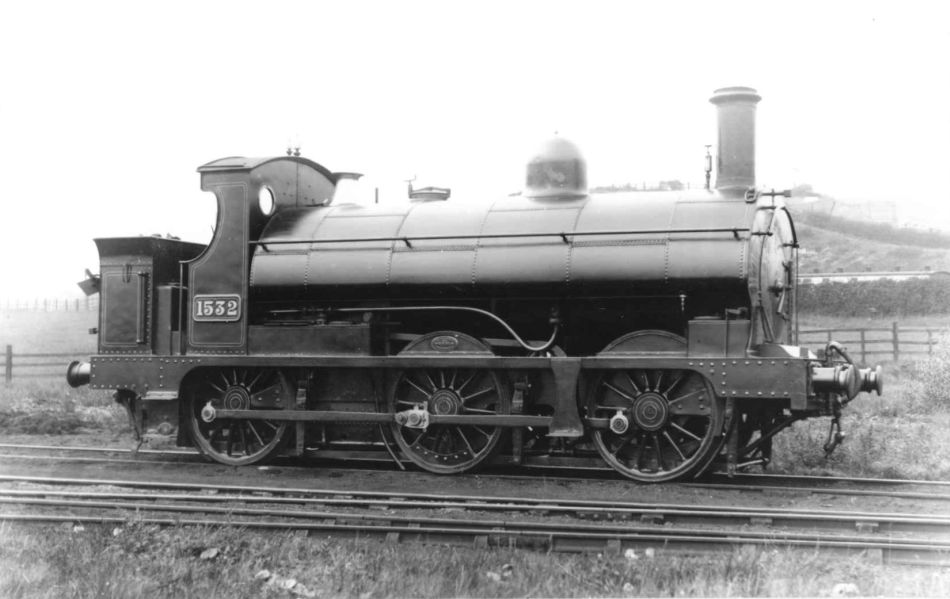
1532, of the 1501 class, in similar condition to that of 772 above, but with a full length tank. The small-radius cab roof is a Wolverhampton characteristic, as is the shallow valance. The main handrail on the tank does not wrap around the front. The boiler, one of the S4 types, has a tall dome. A front step has been tacked on to the valance. The area around the injector has been boxed off. Wolverhampton livery. Date unknown, but probably c 1890.
| 1548, of the 1501 class, in early condition, c 1900. The Wolverhampton cab is tall and the cab's width (possibly as narrow as 6'10") is actually less than the width of the tank. The tank handrail does not wrap around the front, but it does extend onto the cab side sheet. |
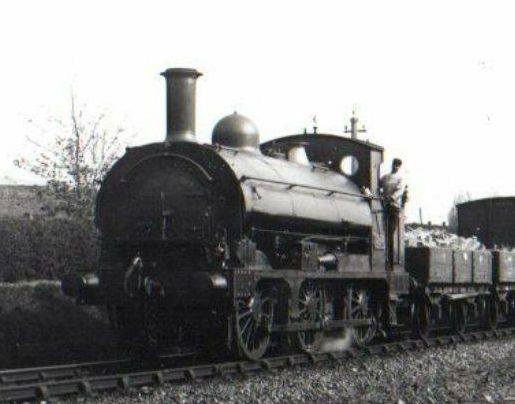 |
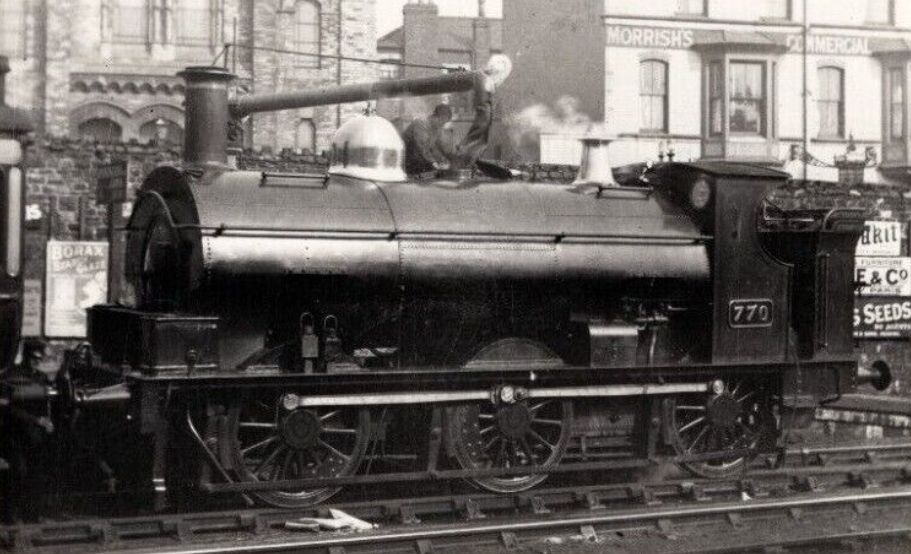
770 taking on water at Newport c 1905. It has a front ring S2 boiler and large front sandboxes. By this time, locos of the 645 and 1501 classes were acquiring wider footplates and wider Swindon cabs and bunkers. It is missing a front step.

2704, of the 655 class, in near original (1895) condition, but with an extended smokebox and a five and a bit segment tank. Picture date unknown. It received pannier tanks in 1930, and lasted until March 1950.
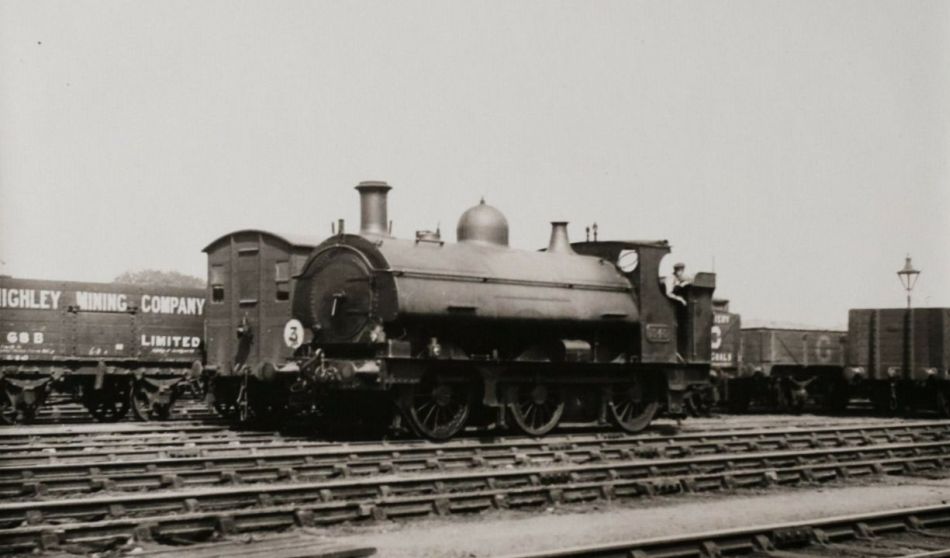
1545 (of the 1501 class) carries a trip traffic duty disc at Stourbridge Junction. Date unknown, but prior to pannier tanks being fitted in 1919. The loco has an extended smokebox, a large dome and a very tall safety valve cover. Cabfronts on saddle tanks varied in height, and this one has large spectacle glasses.

766, of the 645 class, in later condition with an extended smokebox and a 3-segment saddle tank. It has a large dome and a tall safety valve cover. Underneath the saddle tank is a B4 belpaire firebox. It received pannier tanks in February 1929.
| 1556 (of the 645 class) is near to its withdrawal in September 1932. Unusually for this date, it has retained its narrow cab and narrow footplate, and has a smaller than usual capacity tank. |
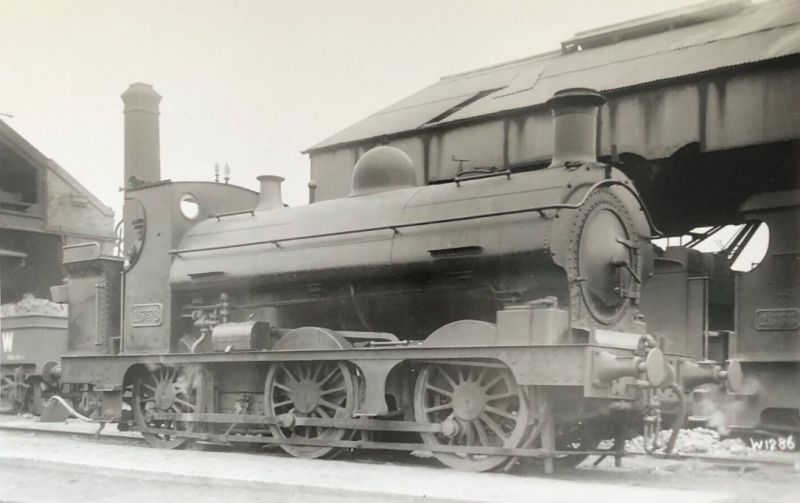 |
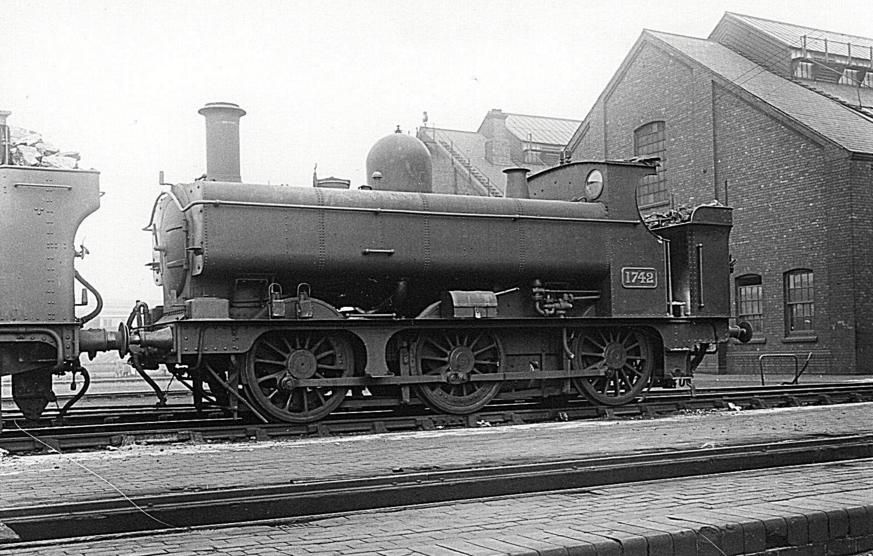
655 class 1742 at Tyseley on 13 October 1935, with a Churchward bunker retained on its original short rear overhang. The loco was shedded there for many years. When pannier tanks were fitted to these early types of inside-framed large locos with large tanks, both Swindon and Wolverhampton introduced the small handrail on the tank to assist climbing up to the filler. It lasted until early 1950.
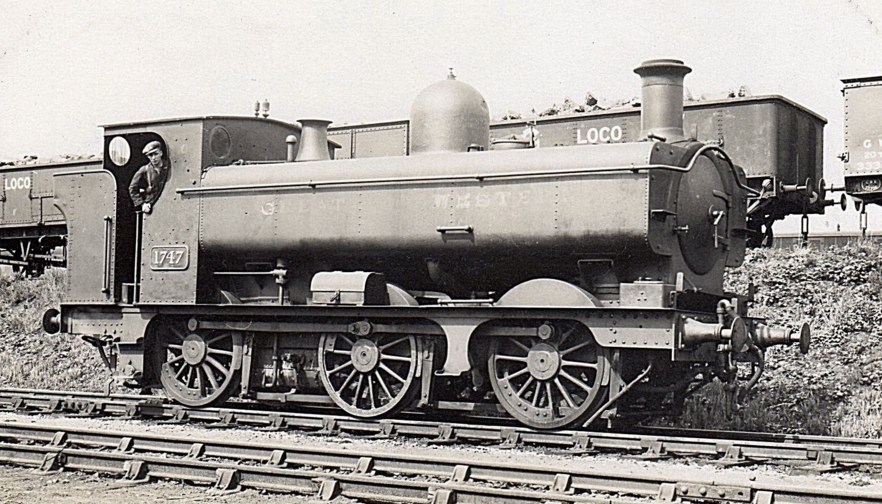
1747, of the 655 class, at Tyseley with a non-standard chimney
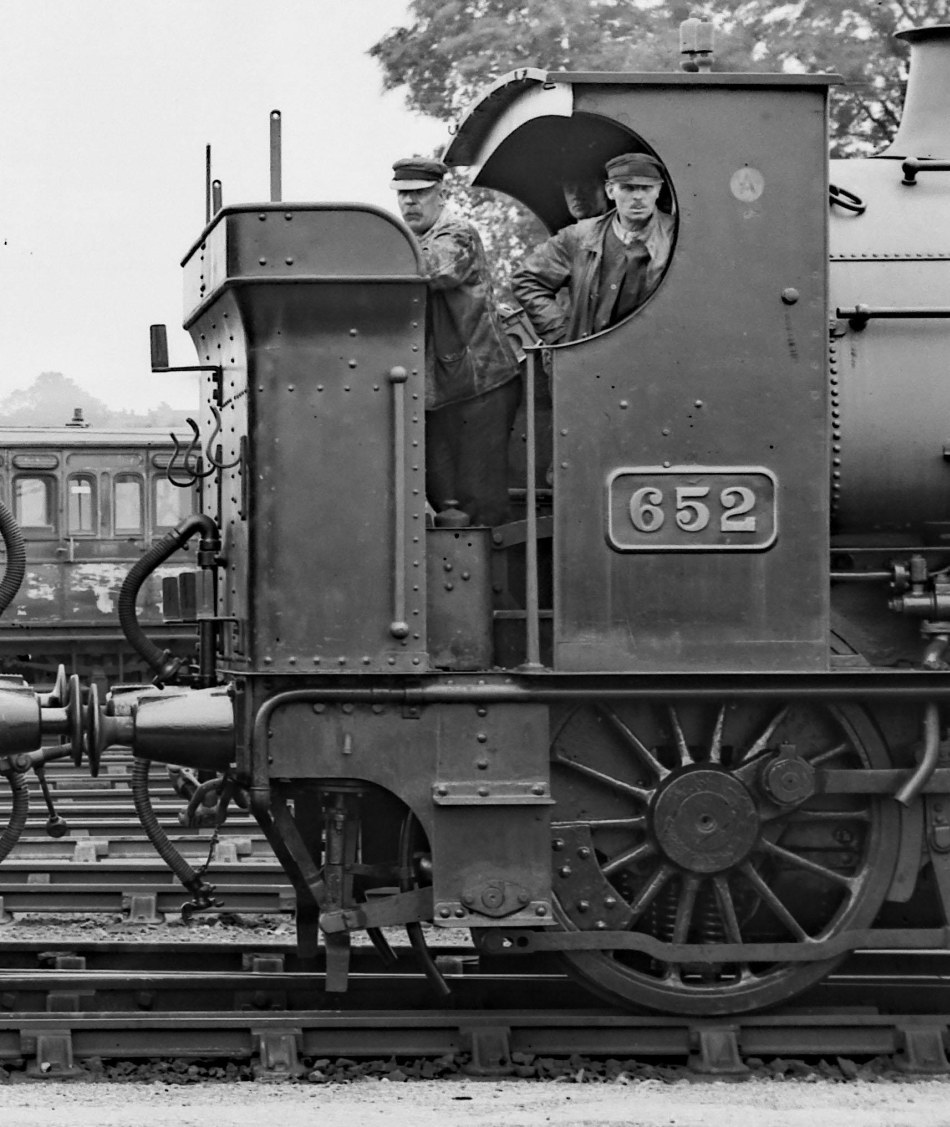
652, showing the very short bunker length of the 645 class. It also illustrates how inconvenient the rear sandboxes were on many GWR tank engines. The loco has a set of Collett taper buffers, unusual for a tank loco. The brake rodding is outside the wheels. 24 September 1926. Picture courtesy David Burton.
Swindon 1813, 1854/1701 and 2721/2779 classes
The first inside-framed Swindon class was the 1813 class of 1882–84. Like the 633 these were built as side tank engines, but with open cabs. These had a 4'9" front overhang and a 6'0" rear overhang, and thus an intermediate sized bunker. The boiler was effectively a slightly thinner P Class. 40 were built, numbered 1813–32, 1834–53.
They were followed by the 1854 (or 1701) series of 1890–95, numbering 120. These had P class boilers, 7'3" + 8'3" wheelbase with 4'6" wheels, again later converted to 4'7½" and with a larger rear overhang of 6'6", adopted by all subsequent classes. They were numbered 1854–93, 1701–40, 1751–70, 905–7, 1791–1800, 1894–1900. Most of the 1854 locos would have received extended saddle tanks and smokeboxes at some time prior to being fitted with pannier tanks.
The last 19th century builds at Swindon were the 2721 class, 58 built from 1897–1900, and another 22, the 2779 subclass, built with slightly larger cylinders in 1900/1. These all had the same wheelbase as the 1854s and were built with the thicker tyred 4'7½" wheels. They were numbered 2721–78. The main differences from the 1854s were the volute springs and fluted coupling rods, although many 2721s were carrying fishbelly rods towards the end of their lives. The 2779 subclass (2779–2795) were built with extended smokeboxes and tanks, although some 2721s also received extended smokeboxes and tanks. The 1854 and 2721 class locos were classified as blue route restriction.
1813, 1854 and 2721 class locos were fitted with 16-spoke wheels, but some late refurbished locos received 14-spoke, so the situation was not uniform. (The norm for all other classes was 14-spoke wheels.)
Most 1813 locos received saddle tanks and true P class boilers from 1894, but one retained side tanks as late as 1907. This class was also amongst the earliest to receive pannier tanks, one as early as 1903. Thus all three styles could be seen together on the same class of 40 engines. The new tanks didn't start to be widespread until 1910/11. Most locos got enlarged bunkers in the 1920s, about half with enclosed cabs. The tended to be withdrawn in the 1930s, with just one surviving to BR ownership.
For the 1854/1701 class, Belpaire boilers appeared from 1901, and pannier tanks from 1911. Withdrawals started in the 1930s and 1940s. 1729 was scrapped in 1943 after having been virtually torn apart in an air raid 9. 23 made it to BR ownership, but the last were scrapped in 1951.
As with the 645/1501 and 655 classes, most of the 1813, 1854/1701 and 2721/2779 locos were fitted with small handrails on their pannier tanks to assist accessing the filler, but the longitudinal position of the handrail was not standardised.
41 of the 2721 class received enclosed cabs, one whilst still fitted with a saddle tank, and most received enlarged bunkers. The majority of the class received panniers before the end of WWI, and all had been converted by 1933. A few of the 1854 and 2721 locos ran with topfeed boilers at various times. These topfeeds would have had small covers.
All 2721 class locos survived WWII, about half were transferred to BR, but all were withdrawn between 1948 and 1950. |
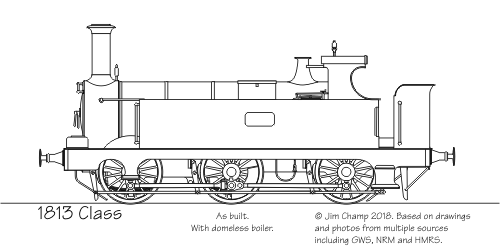
This sketch attempts to reconstruct the as built appearance of the 1813 class
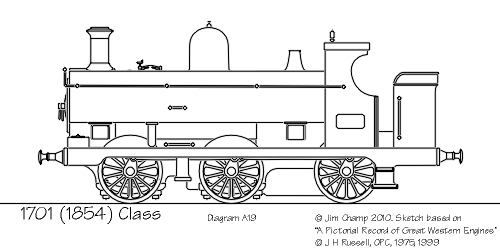
1701 class
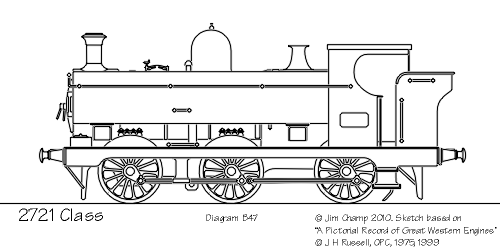
The 2721 class with enclosed cab and extended bunker. The direct relationship with the 5700 is clear. |
| 1875, of the 1854 class, in an early condition with a front ring S2 boiler and original length tanks. Date is probably prior to 1900. The loco was fitted with panniers in February 1913 and lasted until late 1945. |
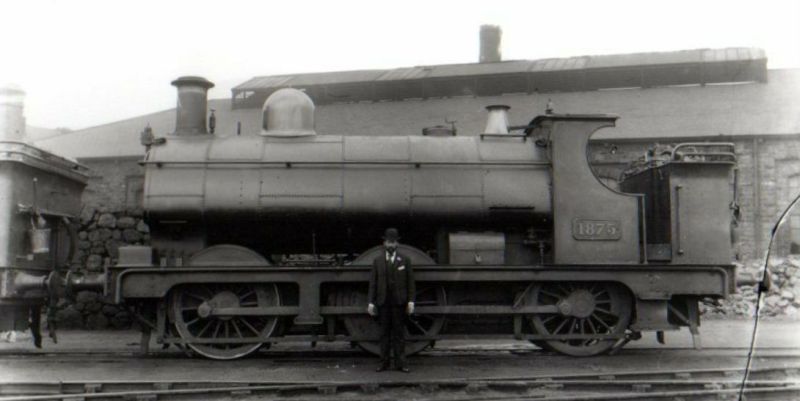 |
| 1815, of the 1813 class, in an early c 1905 condition with a back dome S4 boiler and original length tanks. The rods can articulate sideways ('Admiralty' rods). The jack is accomodated adjacent to the centre splasher. The loco was fitted with panniers in August 1915 and was withdrawn in December 1936. |
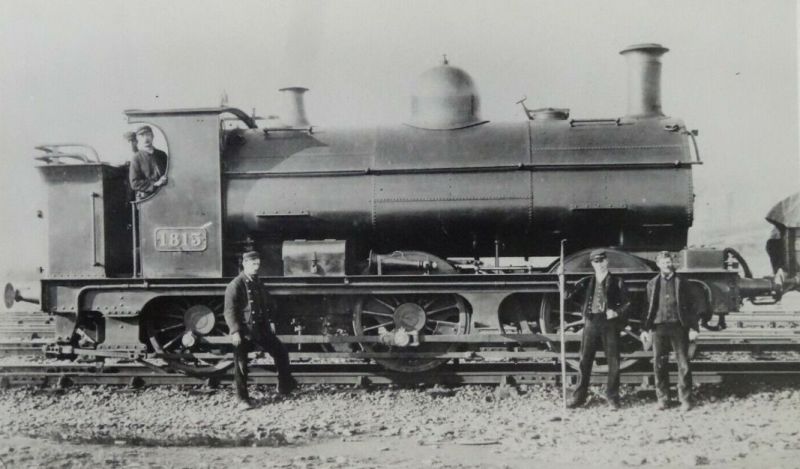 |
2742, with polished boiler fittings, possibly at Exeter. The loco still has its old-style lamp spigots, so this view could be as early as c 1904. The loco was fitted with pannier tanks in August 1915.
This loco has original length saddle tanks. (The 2779 subclass, 2779–2795, had extended smokeboxes and tanks.) |
 |
| May 1910. 1850 is not the first of the 1813 class to receive pannier tanks, but it is one of the first to get full length panniers. The boiler is an S2 front ring type. |
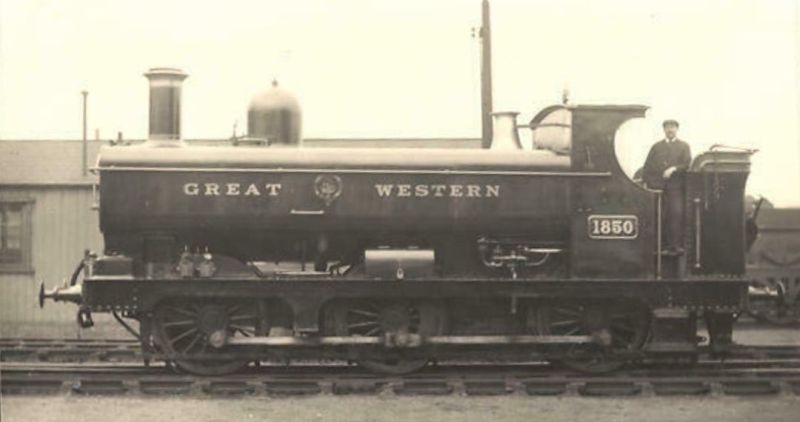 |
| 1793, of the 1854 class, with a conventional non-extended 3-segment tank, showing how much narrower its tank was compared to the cab width. There seems to have been significant variation in saddle tank widths even within the same class, which can render official drawings of the day less than helpful. Pannier tanks were fitted to this loco in February 1921, and it lasted until late 1945. |
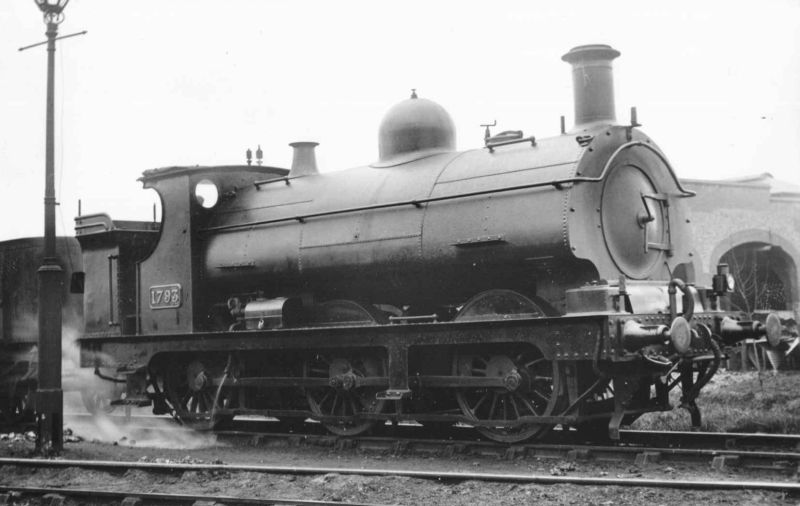 |
| A grubby 2740 at Cardiff General, with a front-ring B2 boiler, fitted in 1912, and an extended smokebox. Pannier tanks were fitted in October 1920. |
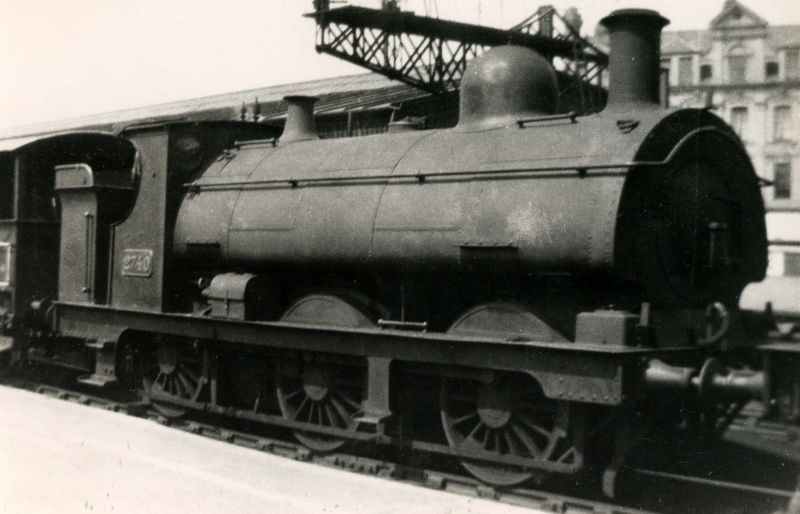 |
A saddle tank with an enclosed Collett cab was extremely rare. 2743 has picked up a standard late-1920s cab and bunker before receiving panniers in 1933.
Only a few of the larger locos were converted to panniers after 1930, so this combination on 2743 might have been unique. |
 |

2723 outside Swindon works, 7 September 1935, with flush-riveted tanks.
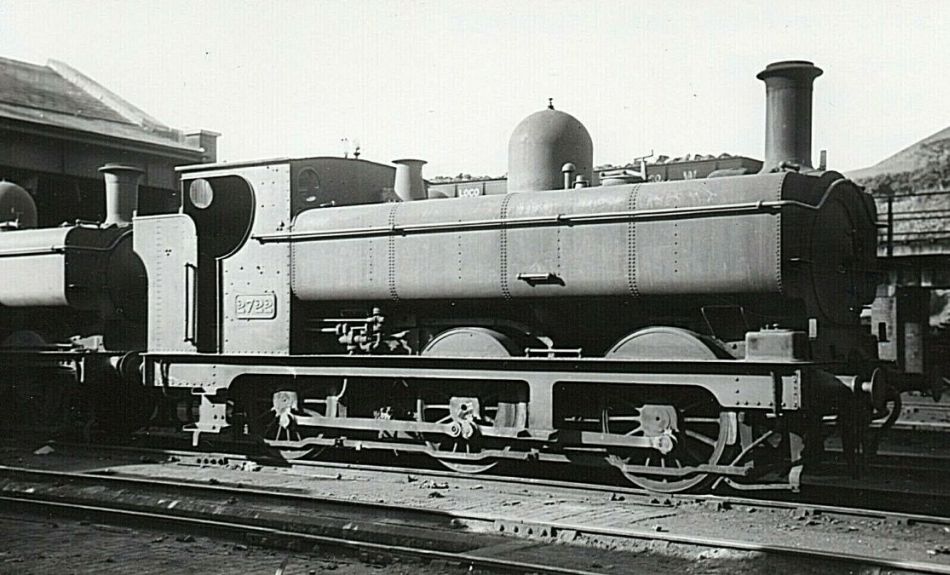
2722 at Duffryn Yard on 22 July 1937, with fishbelly rods.

1815 at Swindon, c 1932. Members of the 1813 class were the first engines to receive pannier tanks, and appear to have retained copper caps to their chimneys.

1793, of the 1854/1701 class, in typical early 1920s condition, at Old Oak Common

1738, a member of the 1854/1701 class, in typical early 1920s condition
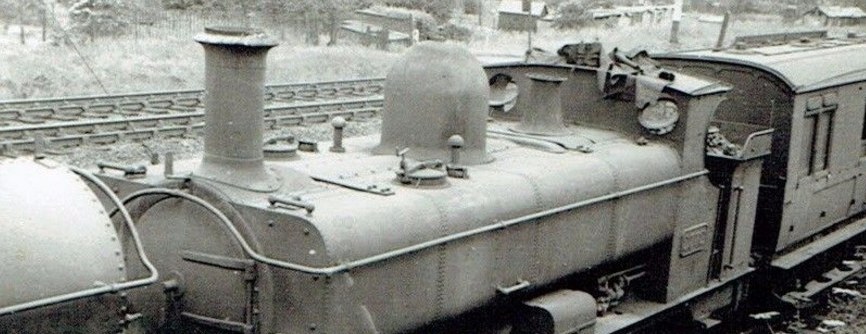
Tanktop detail of 2772, showing the very slight hump in the boiler cladding between the smokebox and the firebox.

1717, of the 1854/1701 class, with an open cab

1709, a member of the 1854/1701 class, with an enclosed cab, at Newport Pill
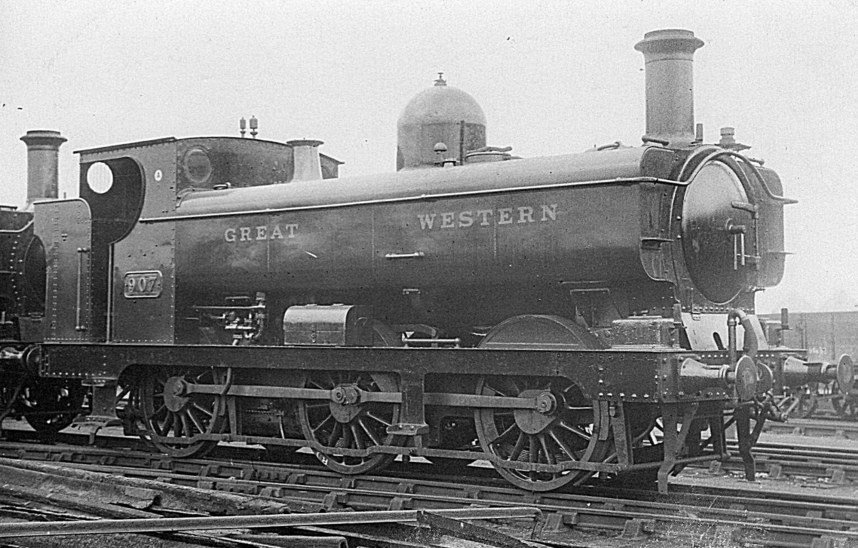
907, of the 1854/1701 class, with an enclosed cab. Apart from the valance and chimney style, and the sandbox location, there is little cosmetic difference between the later appearance of this class and the Collett 57xx.
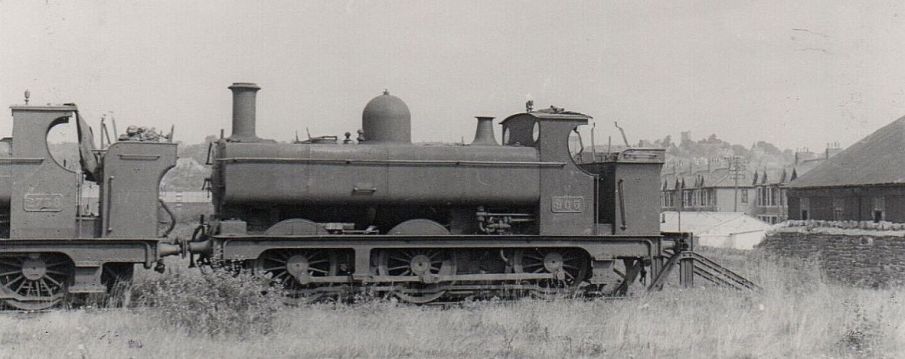
Put out to pasture, 905 is at Newport Pill on 6 July 1947. It was withdrawn in November of that year.
Collett and Hawksworth
5700/8750/9700
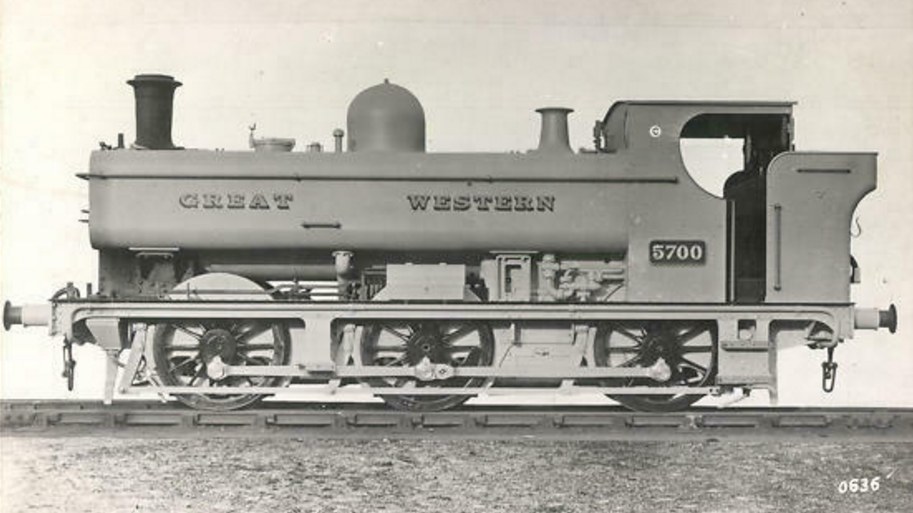
5700, in works grey, in 1929. The first 50 of the 5700 class were constructed by the North British Company. Steam heating apparatus and ATC was not incorporated in this first lot, but were both added later. Image courtesy of Kevin Dare
By the time Collett took over, the older outside-framed engines were getting on for fifty years old, and replacements were required. In Collett style he took the earlier locomotives as a model, and the 57xx could be regarded as being essentially a 1930s condition 1854 with the larger cylinders of the 2779 series of the 2721 class. They had the same 6'6" rear overhang as the last Swindon saddle tanks, but a slightly increased front overhang of 5'6". The tank capacity was 1200g, and the bunker capacity was nominally 3.4 tons. They had many detail improvements in design and construction, and could run much greater distances between overhauls than their predecessors 10. 250 were built in 1929/31, many by outside companies with loan act government finance. Build details can be found on the Wikipedia page.
5775, one of the Swindon-built locos, was fitted with a doughnut-shaped experimental topfeed above the firebox as early as 1929, but fortunately it was not adopted, and the next topfeed generation would not appear until much later, in 1942.
A subclass of 50 from 6700 (numbers 6700–49) was also built in 1930/31, but without vacuum brakes or ATC or steam heating, so could only be used for shunting. They were fitted with 3-link couplings.
Of the locos built by outside contractors, 6700–49, 7700–24 and 8725–49 were built with riveted tanks. (A few of them, e.g. 8729, received welded tanks later.)
Except for 6700–49, which had steam brakes, the 5700 class locos had vacuum brakes and steam heating. ATC was fitted to earlier members of the class within a few years. (Steam heating was not initially fitted to the first lot, 5700–49, but was fitted to most of these locos later.) |
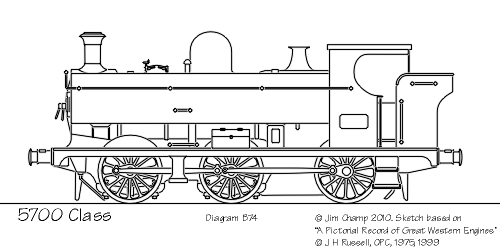
5700 class
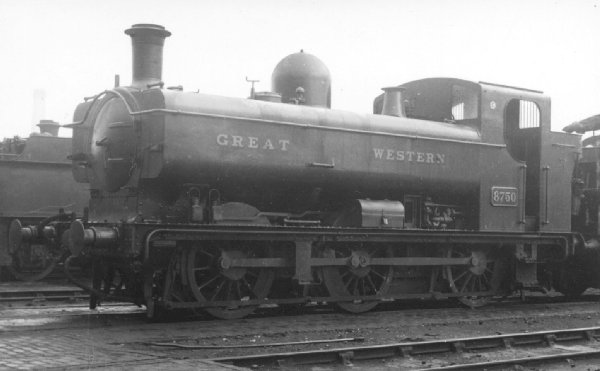
8750, in new condition. Image courtesy of Kevin Dare |
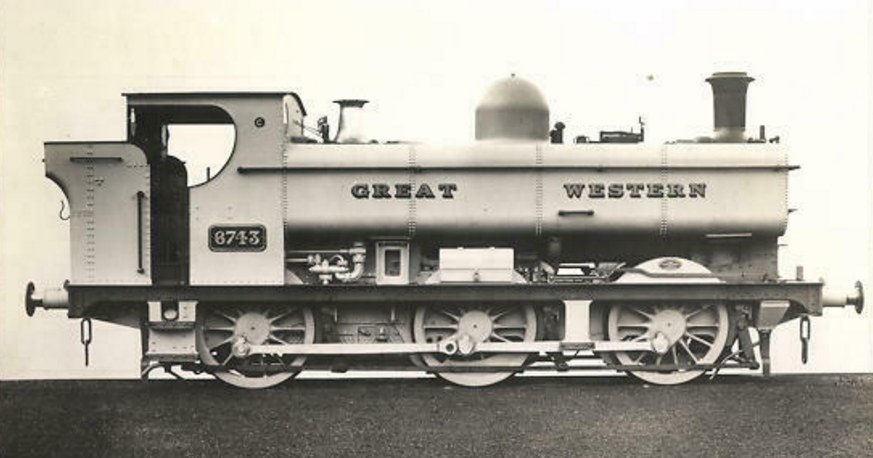
6743, one of the 'shunting only' locos, gets the works grey treatment, probably immediately after building in 1931. This loco was built by the Yorkshire Engine company. The shine on the safety valve cover might not have survived being put into service. Subcontractors seemed to be keen on presenting a works grey specimen, or perhaps it was a requirement of the contract, and 6721 (a Bagnall loco) appeared with full lining.
In 1933 the 8750 subclass was introduced which had a more thoroughly enclosed cab than the earlier lots. About 420 of these were built up until 1950. All were fitted with ATC, steam heating and vacuum brakes from new, except 6750–79 (built from 1947 to 1950), which were 'shunting locos' fitted with steam brakes and three link couplings only, and thus were effectively an 8750 version of the 6700 subclass.
The 9700 subclass of 11 was built in 1933. These were fitted with condensing gear and had distinctive short hybrid pannier/side tanks, an 8750 style cab and a water feed pump on the right hand side of the smokebox. They were fitted with tripcock gear for working over the Metropolitan lines and had a special type of ATC shoe that could be lifted clear of the centre conductor rail. They replaced the "Get Wets": 633 and Metro class tanks with condensing equipment and still without any kind of cab in 1933!
There was little development of the class other than a new form of topfeed introduced in 1942, to both the 5700 and 8750 classes, although it did not become standard for new construction until 1944. Backfeed boilers remained in existence for a long time however, and locos could swap from one form to another in boiler interchanges at works visits. There were one or two temporary 8750 class conversions to oil fuel.
|
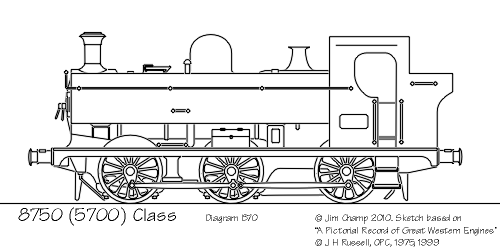
8750 class
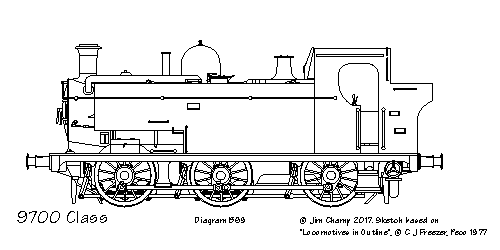
9700 class
|
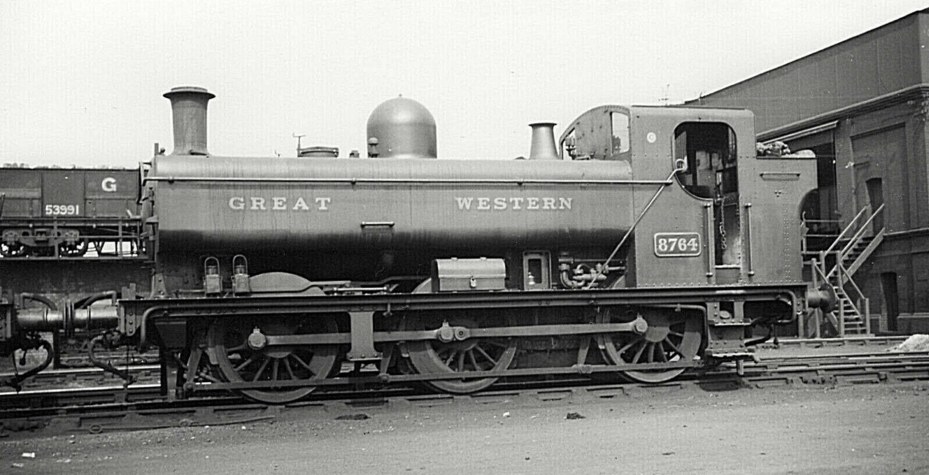
8764 at Old Oak Common, 22 April 1934
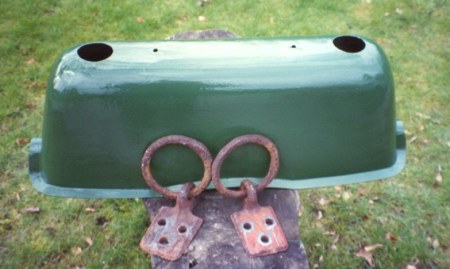
Posing behind a couple of tank-lifting rings, this is the casing fitted over the topfeed on the topfeed boilers fitted from 1944. In side view, the casing has slightly tapered sides (unlike the casing on the Dukedogs and the 48xx 0-4-2T, which had parallel sides). Image courtesy Kevin Dare. |
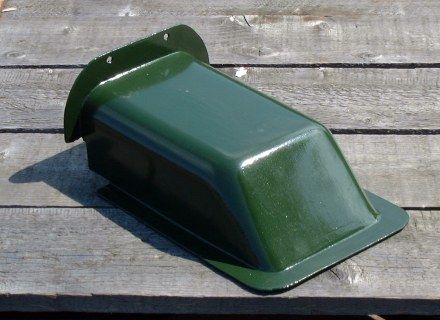
Cover for the lubricator pipes between the tank top and the cabfront. The pipes exit the cab front and go under the boiler cladding. Image courtesy Kevin Dare. |
| The lubricator pipe cover at the cab end on the right-hand side, on 7714. Image extract courtesy Gareth Price, click image for full version. |
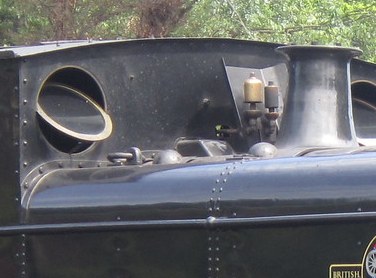 |
Apart from the main difference in cab styles between the 5700 and 8750 classes, other detail differences were in brake hangers, cab handrails, tankfront and cabside steps, injector routing, tank filler types, and the introduction of whistle shields, cab doors and cab shutters.
- The brake hangers on the 5700 class were of the 'twin strips' form, whereas the 8750 locos had a more substantial cast version. Many of the 5700 class were fitted with the 8750 class style of brakes later in their lives.
- The later cab handrail style, and adding cab shutters, started in April 1937 4. Many 5700 locomotives had their original style cab handrails altered to the later style of the 8750 class.
- The style of the footsteps on the front of the tanks changed from a simple flanged one on the 57xx class to a welded one with turned up sides on the 8750 class.
- There were also variations in the way the injector overflow pipe passed through or outside the footplate.
- Tank fillers fitted to early engines had the traditional 'screw down' lids, but later engines had the more modern 'clasp' style of lid, fitting from it is thought 1935 onward to new build locos (probably lot 293 onward). Older locos were generally not retrofitted with the newer style of filler, but of course tank swaps meant that the new type could eventually appear on older locos.
- A small whistle shield was introduced for the 8750 class locos in lot 293 (9760–9784) of 1935, probably, according to Wikipedia 22, from 9773 onward, and a larger whistle shield was adopted part way through lot 306 (of 1937/8) from 3774.
- Steps on the fireman's side of the bunker were introduced in 1936 part way through lot 299, and were retrofitted to earlier locos in due course. On the 57xx locos, an additional hand grab was fitted to the fireman's side of the cab roof. On the 8750 locos, the extra handrail was high up on the fireman's side, extending onto the cab roof. Fitting of these extra handrails often coincided with the fitting of the bunker steps, but not always.
- Cab shutters and hinged doors were fitted as standard on 8750 class locos, and began to be fitted to earlier 57xx locos from April 1937. The retrofitting for the earlier locos was a lengthy process, with the last recorded fitting being in September 1951.
In 1950, 57xx and 8750 class locos were reclassified from 'blue' to 'yellow' route restriction, in consideration of their low hammer-blow. The 9700 condensers retained their blue route restriction however because of their heavier middle axle weight.
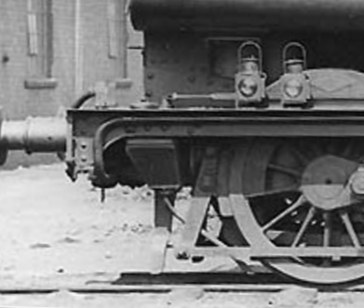
5700 class brakes |
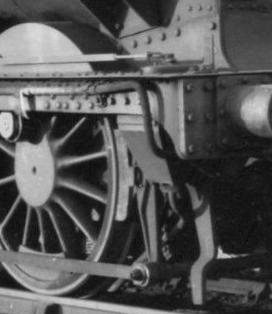
8750 class brakes |
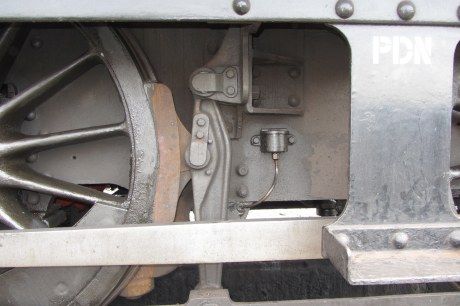
Centre |
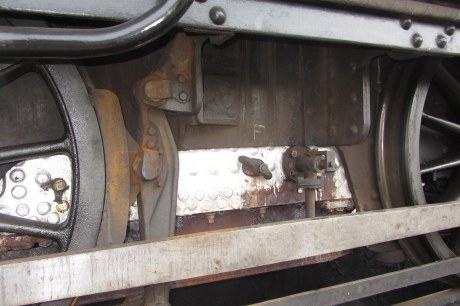
Rear
|
| Detail of the reinforcing brackets on the top pivots of the brakes of a 8750 class. These images of preserved 3738 courtesy of John Darch. |
| 5714's cab handrails, as built |
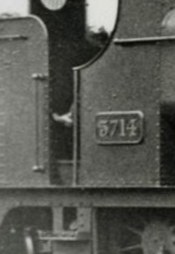 |
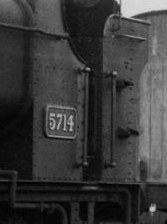 |
5714's cab handrails, toward the end of its life |
On some locos, there was a flanged joint in the vacuum pipe on the left-hand side valence
On this loco, the overflow pipe from the injector passes outside the footplate |
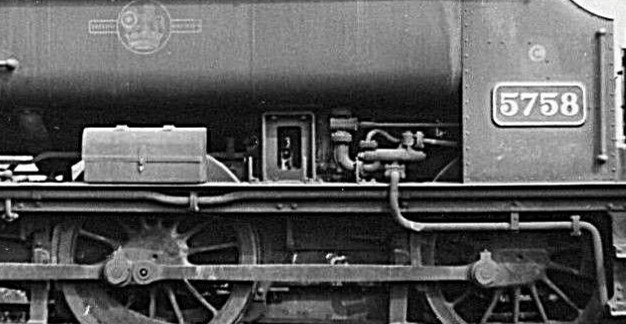 |
Sandbox filler lid and sandbox operating rod
Picture courtesy of Mark Branson |
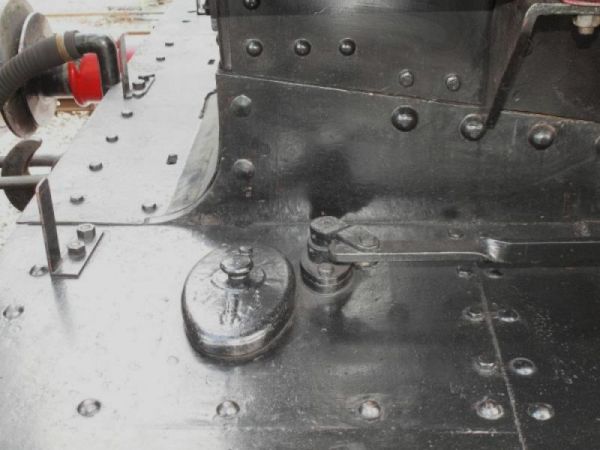 |
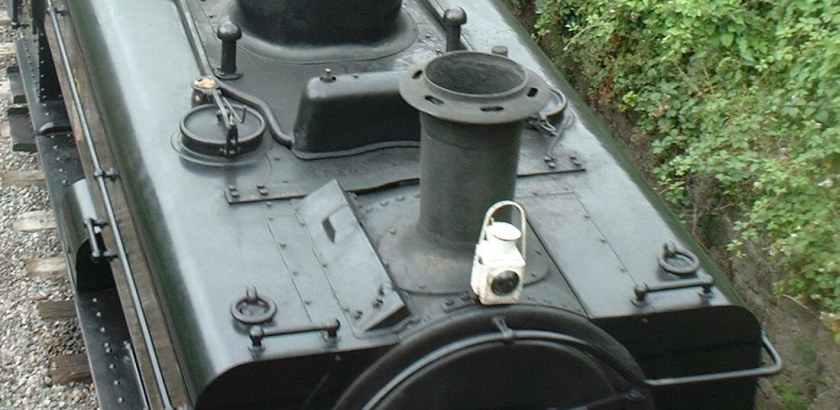
Detail of the tank top on preserved 5764. The rectangular shape adjacent to the chimney is the 'lubricator and blower pipe cover', which allows the pipes from the cab to come from under the boiler lagging, around and into the smokebox.
Under British Railways ownership the 57xx spread around the system: about 20 were allocated to the Southern Region after 1958, with a pair working as banking engines in Folkestone harbour 11.
All were withdrawn between 1957 and 1964, with some being sold on to London Transport and the National Coal Board. 13 have survived into preservation.
For information on the building dates and the builders of the 57xx/8750 classes, see John Daniel's listing
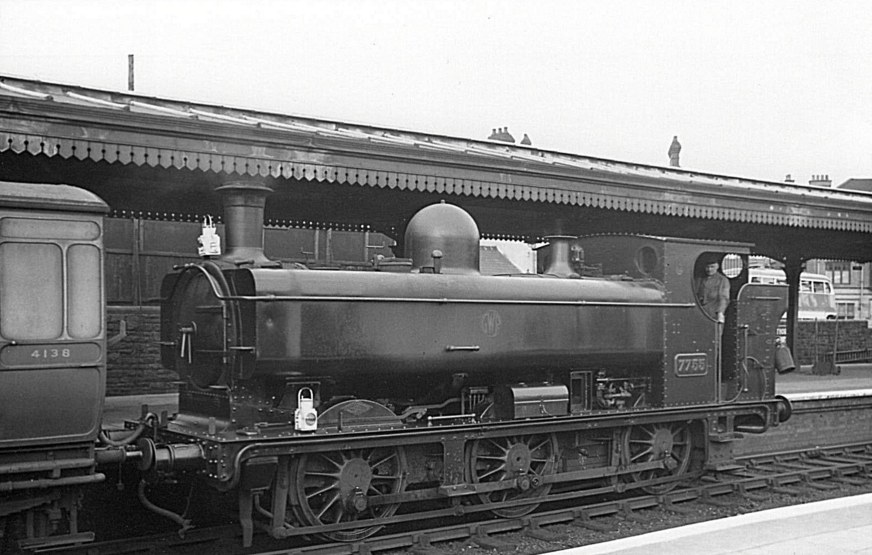
7755, one of the locos built by the North British Locomotive Co, at Llanelly c 1938. For the locos made by outside contractors, makers works plates were fitted to the front left-hand side splasher.
4698 looking very smart. The crest is offset toward the rear of the tank, which seems to be the most common placing (both for early and late crests) on 57xx/8750 panniers.
This is one of the locos allocated to the Southern Region. It has four extra (SR) lamp irons (two on the front and two on the rear), and has probably been overhauled at Eastleigh. It has not yet received its Nine Elms (70A) shedcode plate.
The position of these extra SR lampirons varied. |
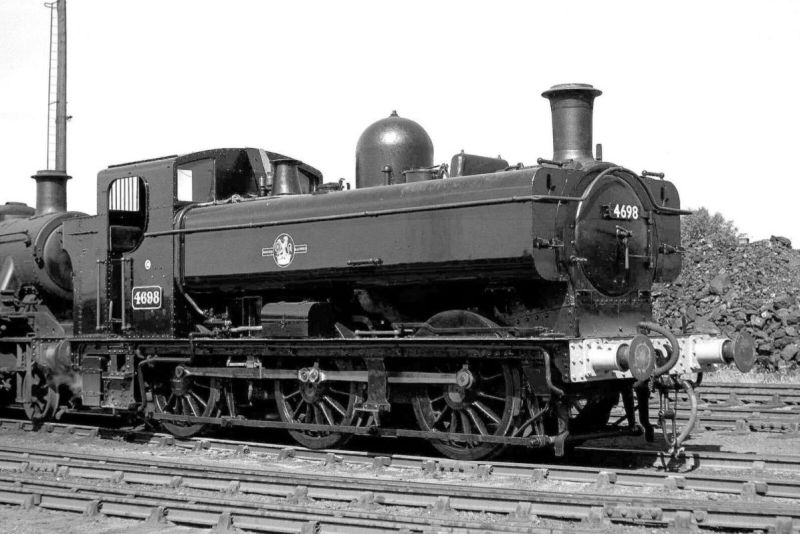 |
| 6763 at Cardiff Canton on 15 January 1961, with a shiny safety valve bonnet (following a visit to Caerphilly works) and a late crest centred on the tank. It is one of the 30-strong 'shunting only' 8750 subclass built very late (1947–50), most of them never receiving GWR livery. The loco in front of it is a Hawksworth 16xx. |
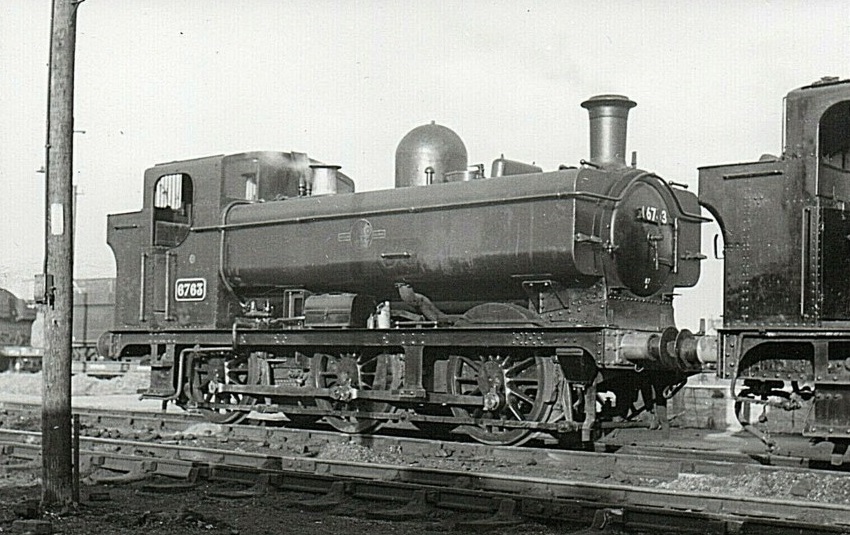 |
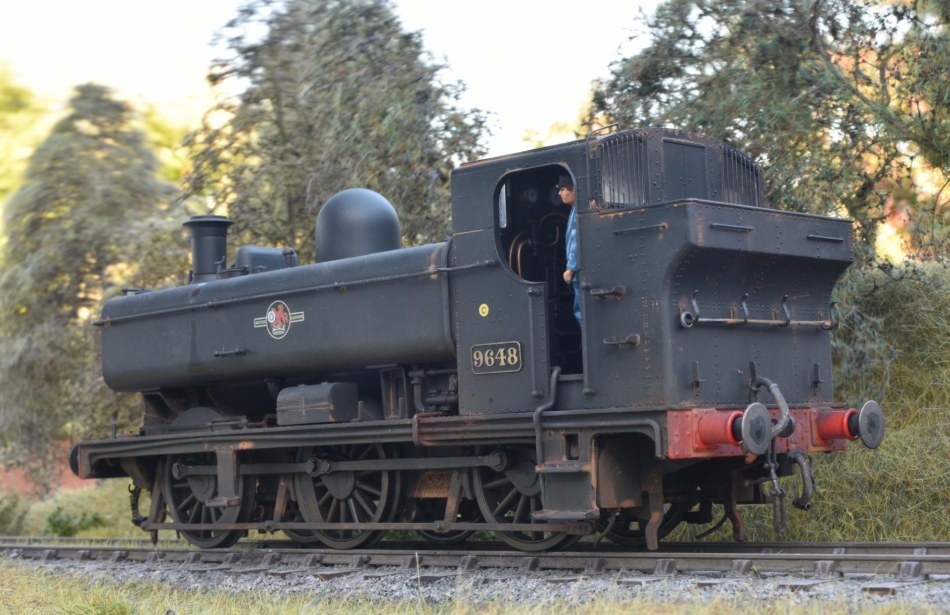
David Magill's weathered Minerva 7mm pannier
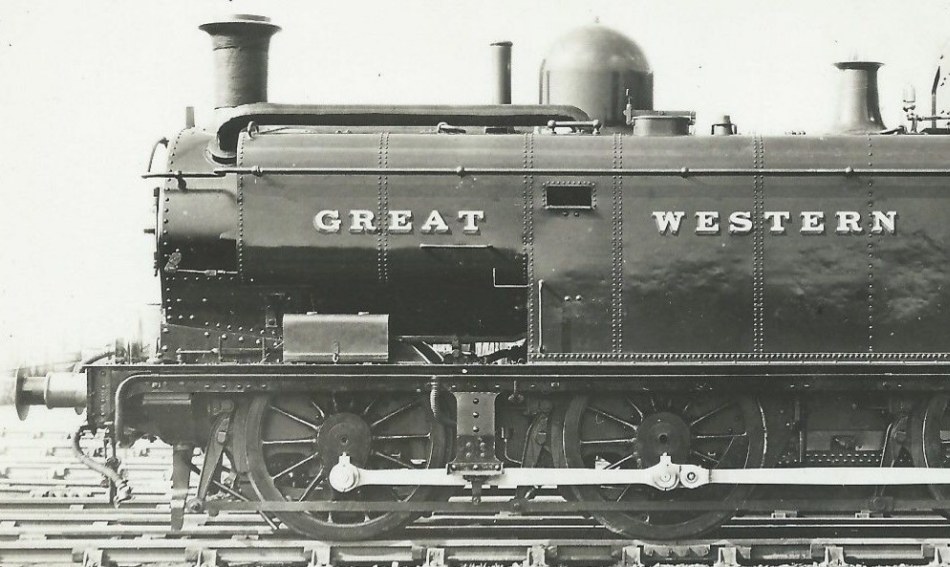
The front end of newly-outshopped condenser 9701. Its tripcock gear is behind the step, and is clipped up into the raised position. The tanks on these condensers were 1230g capacity.
Detail of Weir pump
|
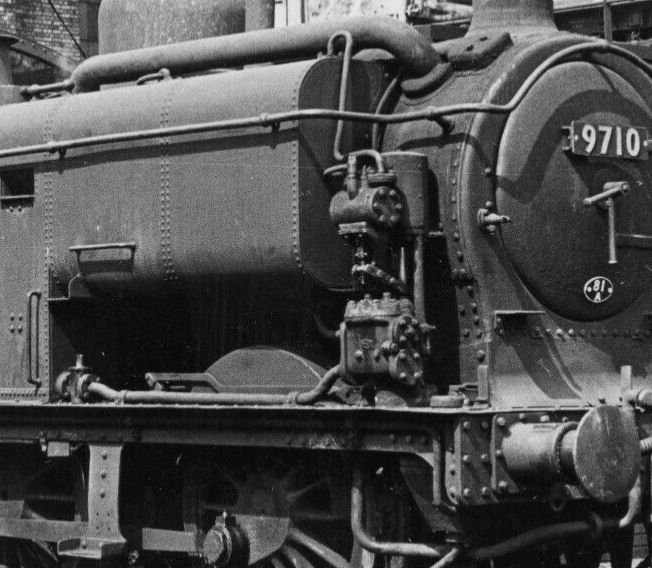 |
8750 class cab fittings
(this shows clacks for a backfeed boiler) |
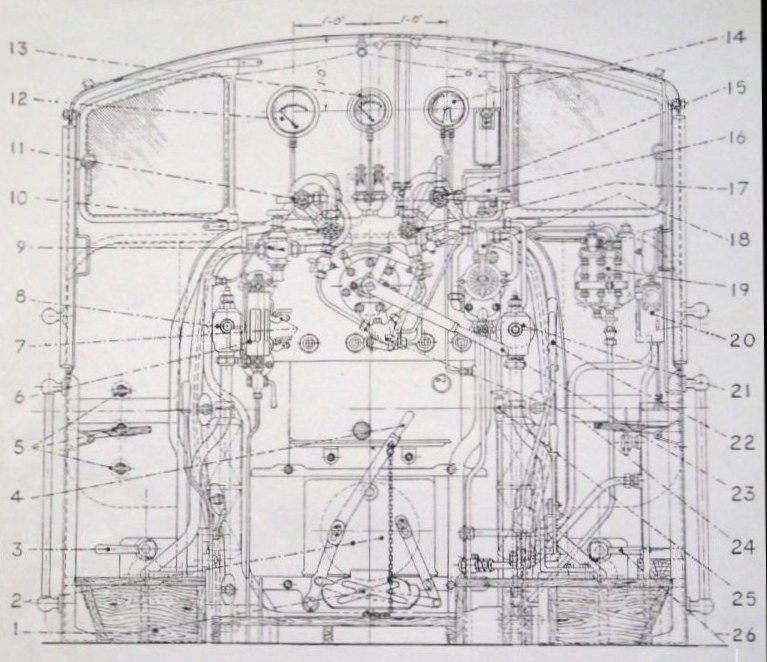
|
| 1 | Firehole flap | | 14 | Vacuum gauge for train pipe and vacuum chamber |
| 2 | Fire doors | | 15 | Steam valve for blower |
| 3 | Water valve for left-hand ijector | | 16 | Vacuum setter for steam brake |
| 4 | Fire door handle | | 17 | Steam valve for right-hand injector |
| 5 | Test cocks for water tank | | 18 | Handle for steam and vacuum brakes |
| 6 | Boiler water gauge | | 19 | Sight-feed lubricator for regulator, valves and cylinders |
| 7 | Test cocks for boiler water | | 20 | Cab-signalling apparatus |
| 8 | Clackbox for left-hand boiler feed | | 21 | Clackbox for right-hand boiler feed |
| 9 | Reducing valve for carriage-warming steam | | 22 | Reversing lever |
| 10 | Steam valve for left-hand injector | | 23 | Regulator handle |
| 11 | Steam valve for carriage warming | | 24 | Lubrication control valve |
| 12 | Boiler pressure gauge | | 25 | Oil cup for steam brake cylinder |
| 13 | Carriage warming steam gauge | | 26 | Water valve for right-hand injector |
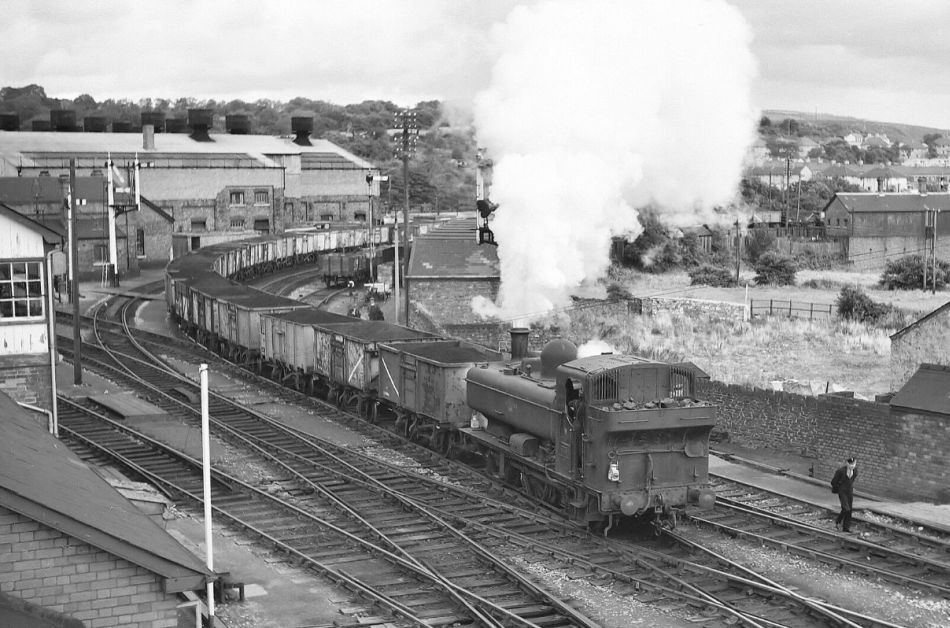
Panniers spent much of their lives on unglamorous work. 3738 heads a long coal train from the Ogmore Vale through Tondu Junction.
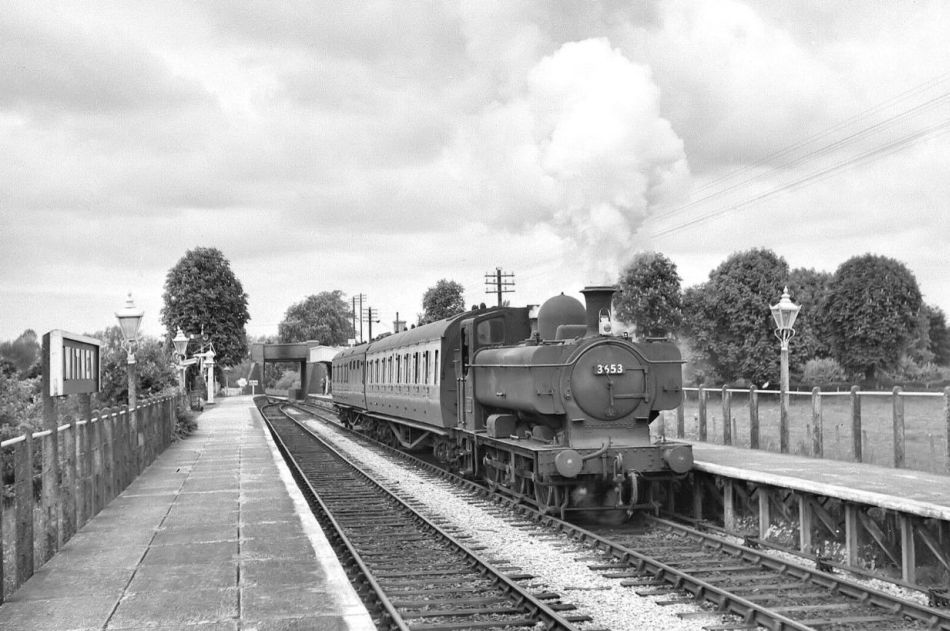
3653 departs from Witney with a train to Oxford
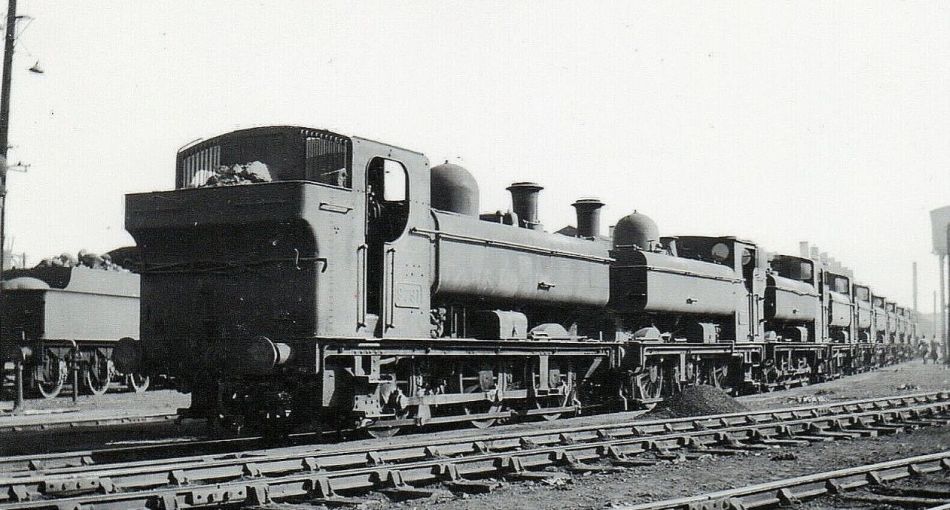
The long goodbye. Reading shed on a Sunday in 1960.
9400
| The finale to the large pannier tanks was Hawksworth's 9400 class. According to one source 12, the GWR General Manager Sir James Milne felt that the large domes on the 5700/8750 looked rather old-fashioned. Although substantially similar to the Collett engines below the footplate, these were significantly bigger and heavier engines than their predecessors – 2' longer overall, and the width was now 8'6", 6" wider than the previous standard. The tank capacity increased to 1300g, 100g more than the previous 1200g norm. They had a Standard 10 boiler, much larger and tapered and domeless, an especially wide cab, and tanks that stopped short at the smokebox. However, the wheelbase and wheel size remained at 7'3" + 8'3" wheelbase and 4'7½" wheels – unchanged from seventy years earlier! At over 55 tons, these were the heaviest of the pannier tanks and restricted to red routes. The first ten were built at Swindon and came out in GWR colours, but the remaining 200 were built between 1950 and 1956 under British Railways, all by outside contractors. The class marked a return of copper-capped chimneys for goods tank locos. The boilers of the first ten, built at Swindon, were superheated – the remainder of the class was unsuperheated. |
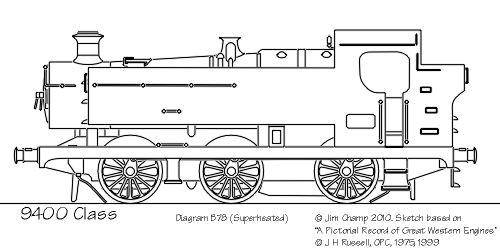
9400 class
|
There has been much criticism of the decision to build the 9400, especially so many of them, even from GWR Sources 13. However, RCTS 14 states that they were originally designed not to supplement 57xx but to replace withdrawn absorbed locomotives from the Welsh companies. There were around 200 absorbed 0-6-0T and 0-6-2T tanks surviving at the end of the war, all of which were due to be withdrawn over the period that the 9400 class deliveries were scheduled. The larger capacity boiler and increased adhesive (= braking) weight gave the 9400s capabilities that the 5700 class lacked, and the class had a widespread allocation over various ex-GWR districts. In the event everything changed, and many had a very short lifespan. Off the GWR system some were used in twos and threes and even fours as bankers on the Lickey Incline. Two have survived into preservation.
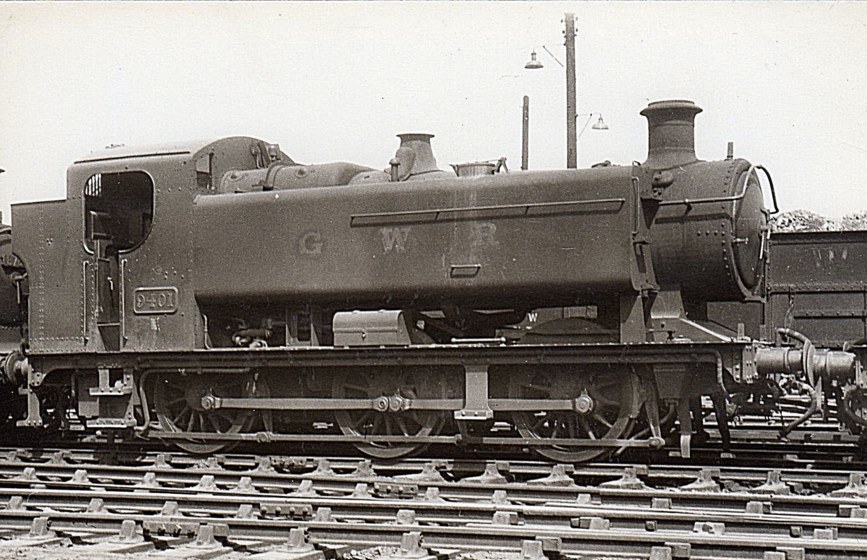
9401 at Old Oak Common c 1949. The first ten locos were outshopped with G W R insignia, and had a sloping cover, underneath the smokebox, over the front of the cylinders. Later engines did not have the cover. The position of the filler, above the small tank handrail, was moved forward on other locos in the first batch and on later batches. The rear steps were in the same plane as the bufferbeam on the first ten locos, all other locos had the rear steps attached to the side hanging plate. (The steps on the first ten locos were subsequently changed to be as per the other locos.)
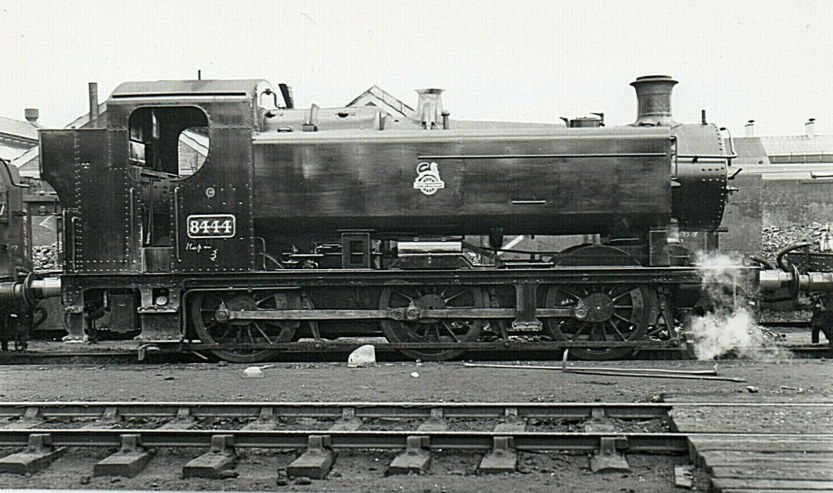
The eight panels making up the tank are just discernible on this shiny 8444. It was very rare to see a polished safety valve bonnet on this class, but it was also seen on 9431 and 9494 ex-works from Caerphilly.
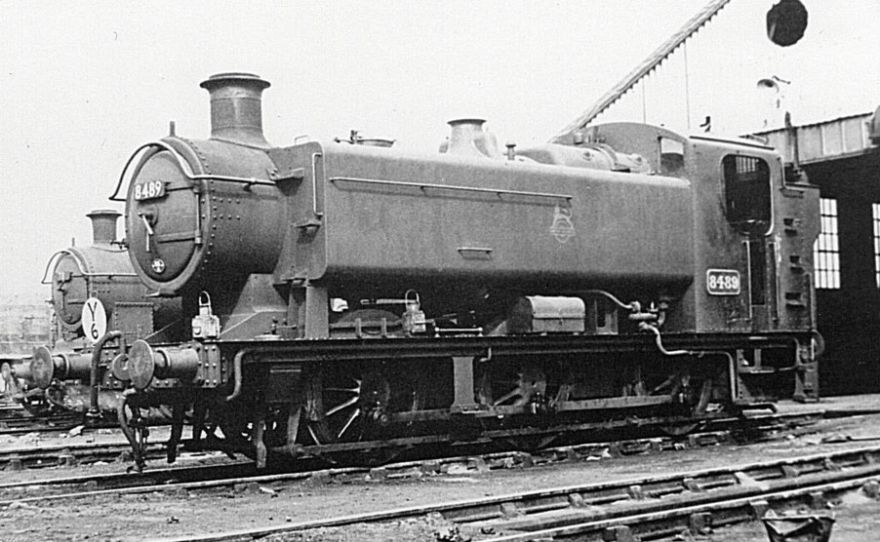
8489 at Radyr, 30 May 1954. The overflow pipe from the injector is routed outside of the footplate.
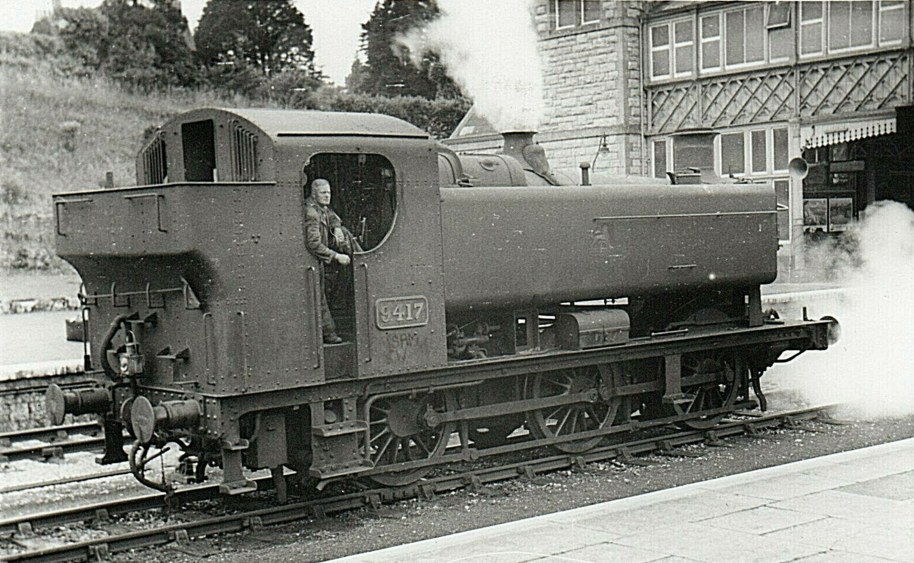
A dozen or so locos of the class were allocated to west country sheds. Here is 9417 at Torquay, 5 July 1952. The fire iron hooks on the bunker rear are welded on, and are of a 'squarer' shape compared to the previous 'curvy' style that had been standard under Dean, Churchward and Collett. This squarer shape was also carried by the other 15xx and 16xx Hawksworth pannier classes. 9417 also illustrates the position of the rear steps, attached to the side hanging plate.
The small classes
In the Victorian era these were exclusively built at Wolverhampton.
Armstrong/Dean
850/1901 Class
The 850 class had a 7'4" + 6'4" wheelbase, 4'7" front and 6'3" rear overhangs and smaller 4' wheels. When thicker tyres were used they increased in diameter to 4'1½". 36 were built between 1874 and 1877 as saddle tanks with no cab, just a spectacle plate and side sheets. The boiler pitch for early locos was 5'10¾".
The 120 of the 1901 class, built 1881 to 1897, were essentially very similar, but had open cabs and the larger tyres from the start, and larger tanks on those built from 1888. Saddle tank capacity for the 1901 class locos varied but was typically 800g. Subsequent Swindon modifications to boilers and tanks had the effect of raising the boiler pitch to 6'0¾", and this became standard when the locos started to receive pannier tanks from 1910.
Once they had all received saddle tanks and cabs the two classes were effectively merged.
One-third of the 850 class locos ran with H-spoke wheels.
Brake rods on the Wolverhampton small tanks were behind the wheels. Front guard irons were lower extensions to the front brake hangers, but many locos gained seperate and stronger Swindon-style guard irons in later years.
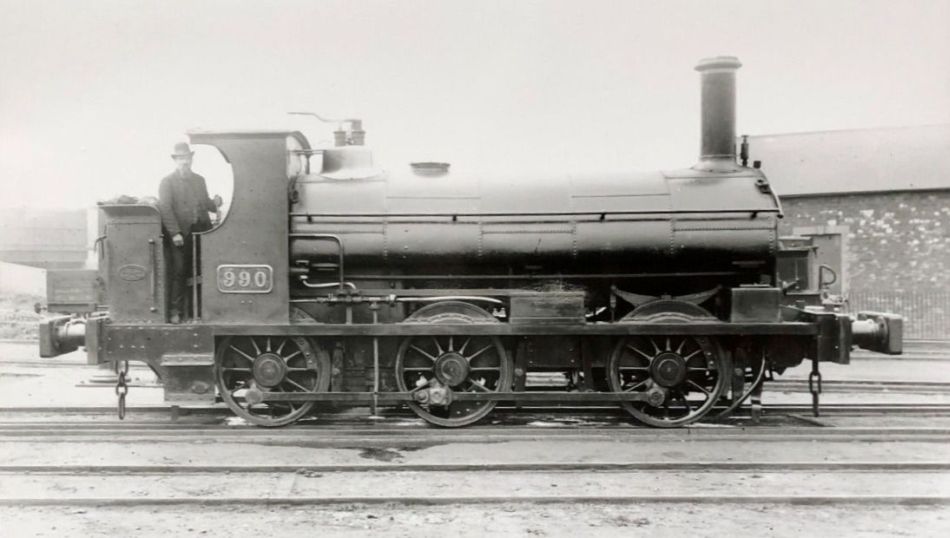
36 of the initial 850 class locos were built with R6 boilers, which had the dome and the safety valves combined into a single fixture above the firebox. As pictured here, 990 is in near-original condition with a Wolverhampton chimney but has had a cab fitted. Very difficult to date, but possibly c 1880–5. The couplings are of early 4- and 5-link forms. This particular loco has wooden beams bolted to the bufferheads, so would seem to be a works shunter, possibly at Stafford Road. The R6 boilers had disappeared by 1904.
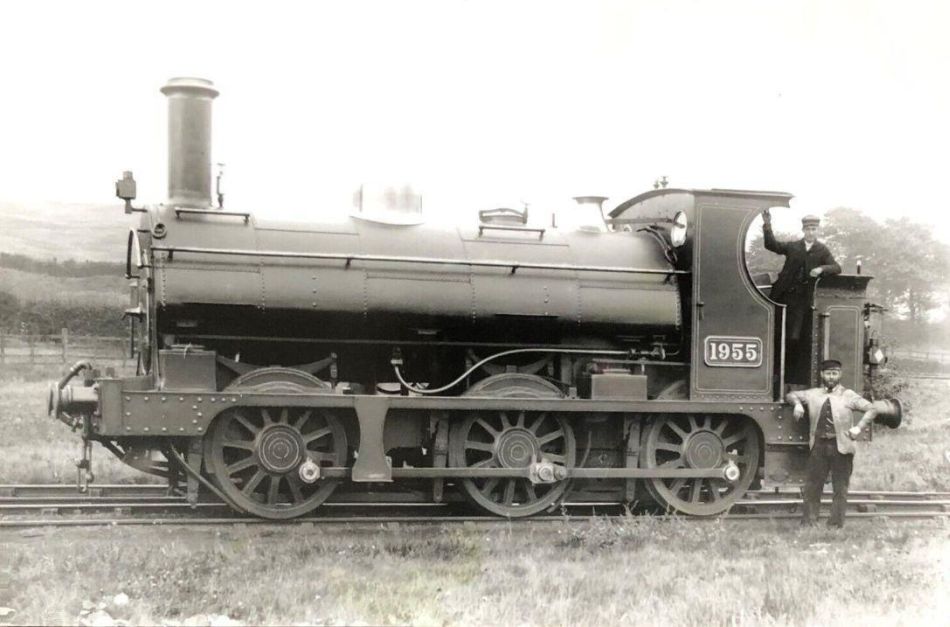
1955 looks very new, so this could be 1888. A front step has been tacked on to the valance and the handrails at the front are seperate. The front smokebox plate has flares at its lower sides. The rear sandbox is in front of the cab, and operates on the centre drivers. It is probably in Wolverhampton blue-green livery.
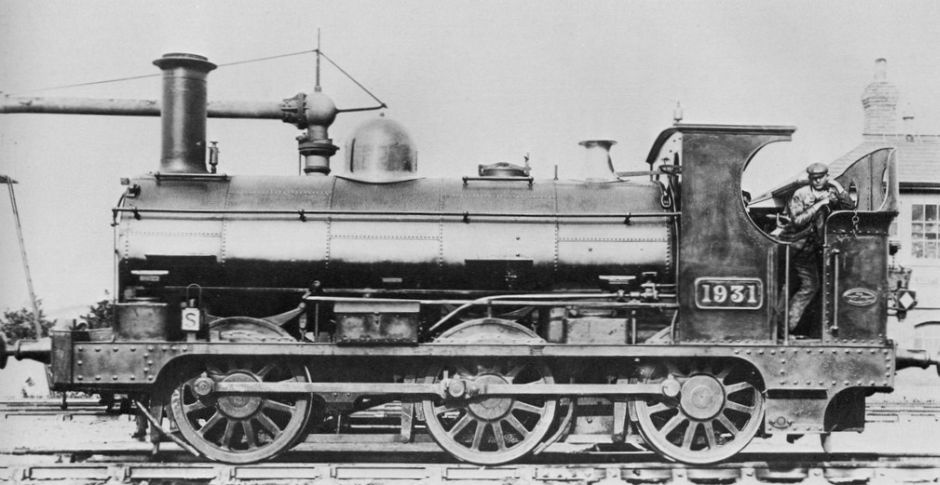
1931 in early five-segment saddle tank mode, with a cab and Wolverhampton bunker and rear spectacle plate. The filler is behind the dome, and there are two tank steps and two upper handrails on each side. The worksplate is on the bunker side. The toolbox is overhanging the footplate.
| Some 850s and 1901s received lengthened frames (by 6" or 9") and rear overhangs, and thus larger bunkers. Belpaire fireboxes started to be introduced in 1910, but the round firebox boilers were long lived and a few never received the Belpaire boxes. Most were converted to pannier tanks from 1910 through to the 1920s. Width over the cab was 7'2", the footplate was 7'6" wide and the bufferbeam was 7'5" wide. Quite a number had pannier tanks fitted on boilers with round top fireboxes. Seventeen locos retained (or in a couple of cases reacquired) saddle tanks until scrapping 21, and two (1925 and 2007) retained saddle tanks into BR days. Around half gained enclosed cabs. Front steps started to be fitted from the early 1930s. Scrapping started in the early 1930s, but 43 survived into BR days and a good few were still active into the 1950s. The boilers were always class R, although they differed in detail over the years. |
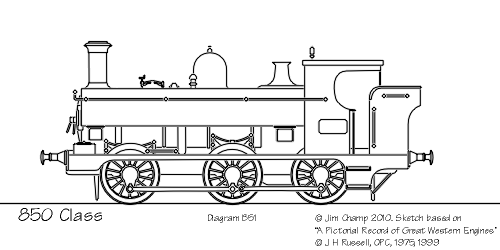
850 class
|
854 at Exeter, with a tall safety valve cover and normal-spoked wheels. Probably early 1920s.
By this time, medium height chimneys had become the norm for 850/1901 saddle tanks, and rear sandboxes were now placed in the cab area, and operating on the rear drivers.
The loco received pannier tanks in December 1926. |
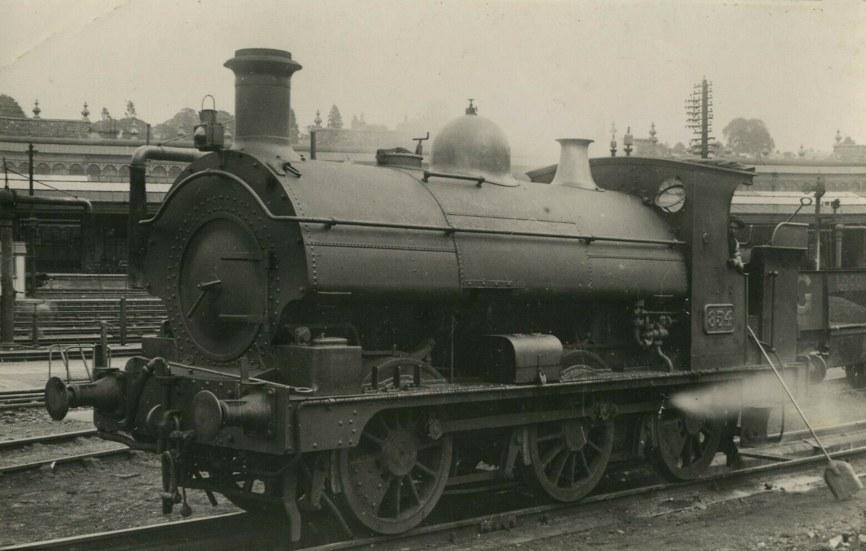 |
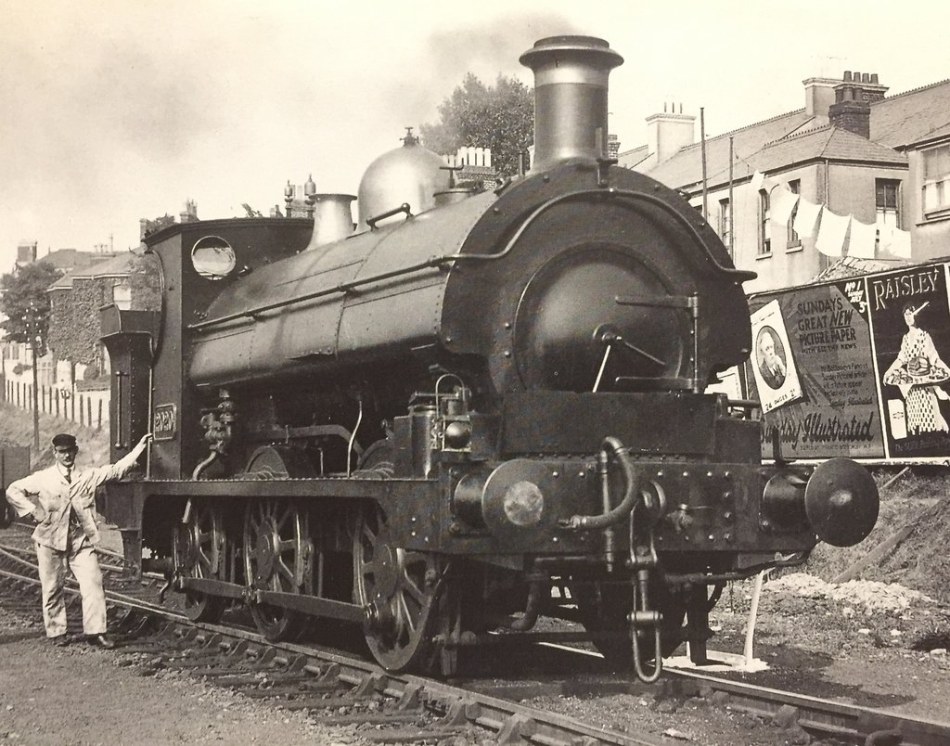
2020, the final member of the 850 class, at Plymouth in 1921, with H-spoke wheels. The loco has been fitted with large diameter buffers, which was unusual for a non-autofitted loco, so perhaps the large buffer heads indicates it was allocated for ECS use. The loco is in immaculate condition, and it is unusual for a dome to be polished at this date, so maybe the loco is a Laira pet. It would receive pannier tanks in October 1923.
| A small number of 850 class locos were fitted with very short chimneys for lines with height restrictions. Plymouth docks was such a place, and here is 863 at Laira on 15 June 1928. The wheel tyres are extremely worn. |
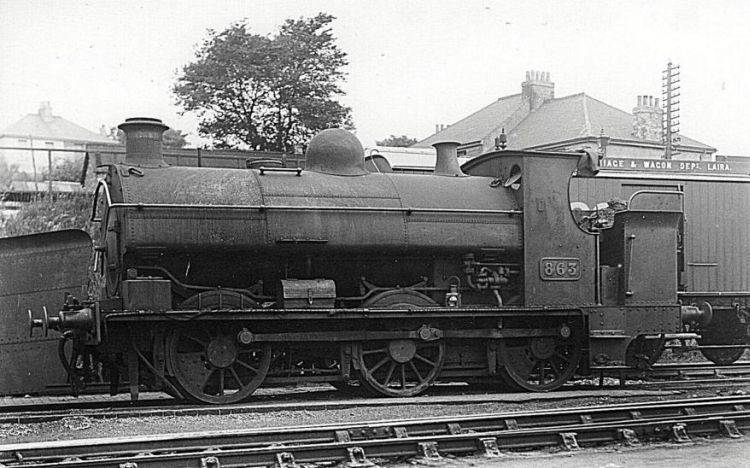 |
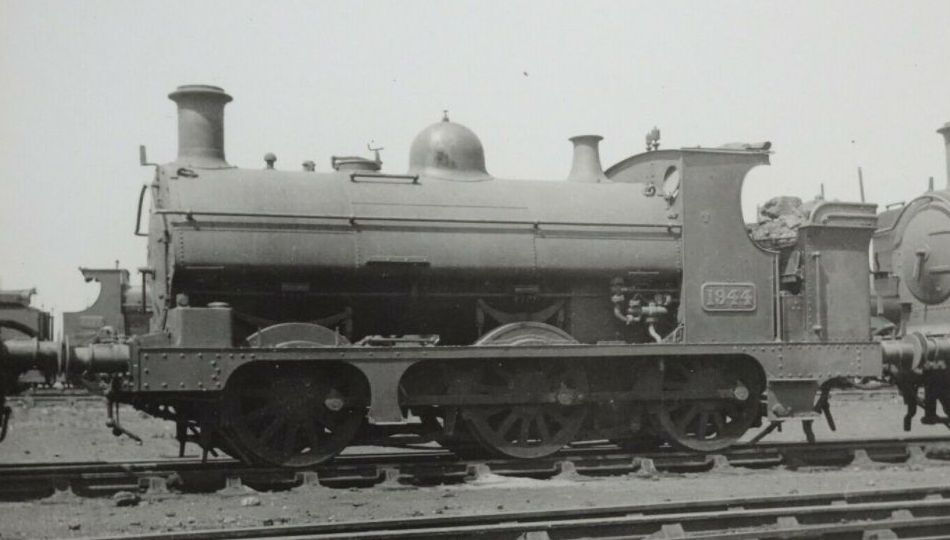
1944 at St Philips Marsh on 10 May 1933. It has a tall safety valve cover. A tank vent and filler bumper have been fitted. It never received pannier tanks, and was withdrawn the following year. Tank vents were rare on 850/1901 class saddle tanks.
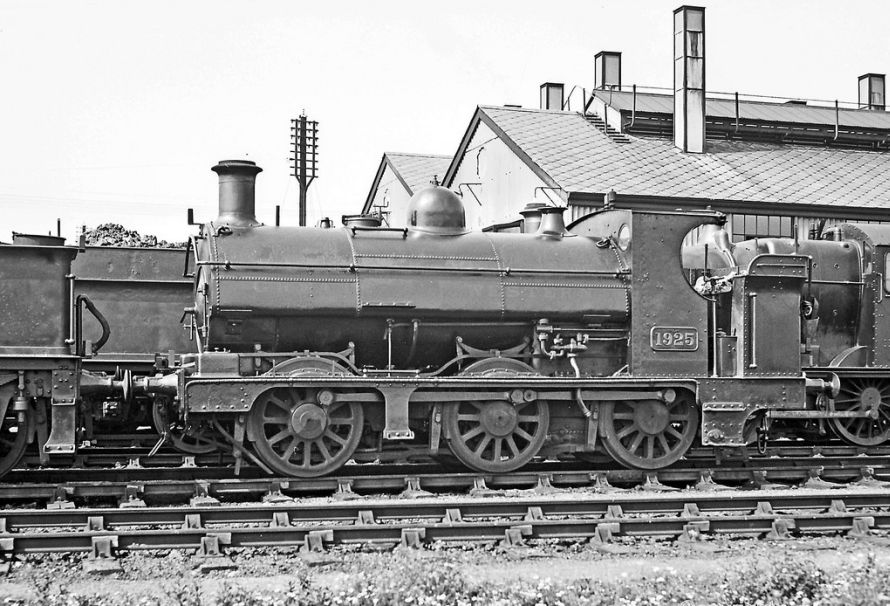
1925 at Didcot, 16 August 1936, with a short safety valve cover. 1925 and 2007 took turns working the Lambourn branch in the mid- to late 1930s, and retained their saddle tanks into BR days. 1925 and 2007 carried 'GREAT WESTERN' insignia on their tank sides at this time, unusual for saddle tank locos, even by this late stage.

868, still with early dished smokebox door and snaphead-riveted tanks has a Churchward bunker in the upper picture, and a few years later, below, has acquired an extended frame, a Collett bunker and some front steps. Both pictures are at Swindon.
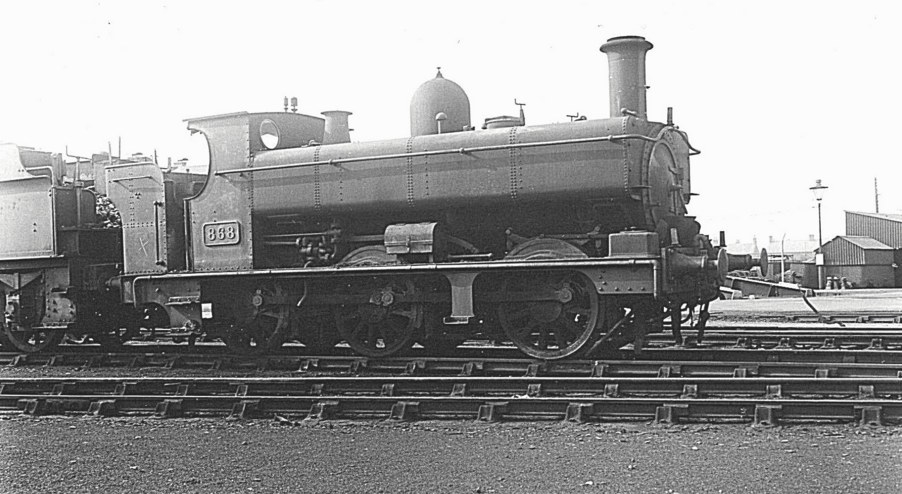
| Cute. Open-cabbed 1976 at Radley in 1931, with the Abingdon branch train. The 4-wheeler diagrams are T35 + U4 + S9 + T35, the brake 3rds having had their guard's duckets removed and plated over. |
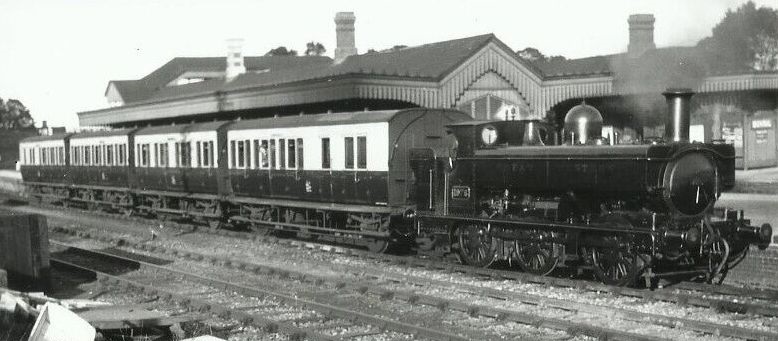 |
1954 at Aberystwyth, 22 August 1934, with enclosed cab.
The front step is non-standard, and the vacuum pipe seems to be routed internally rather than the normal position of outside the valance. |
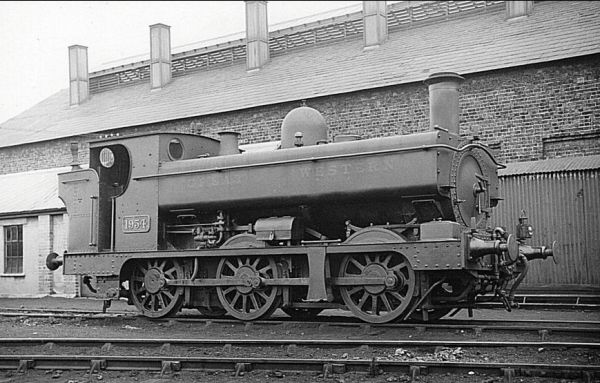 |
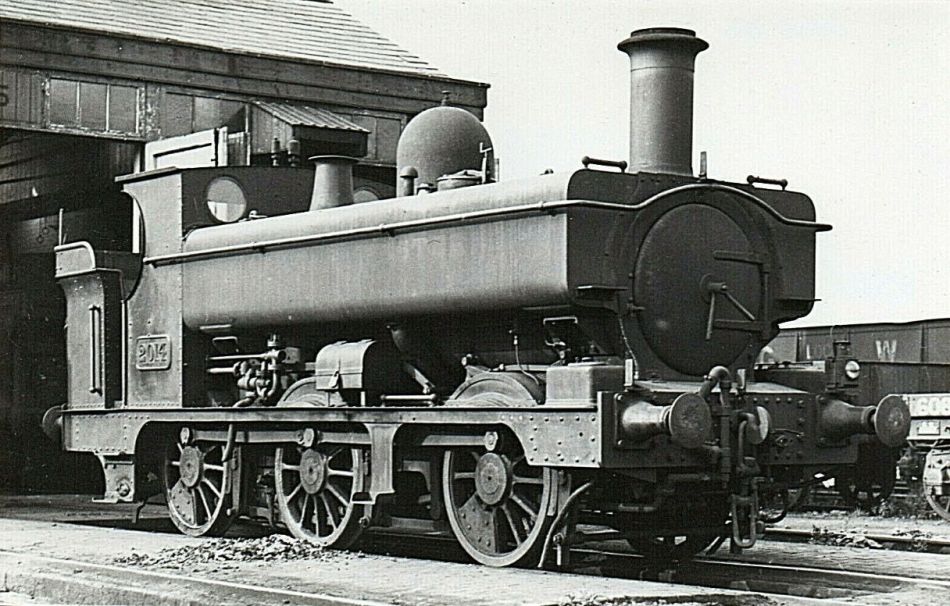
2014 at Swindon, 1937
A grubby open-cabbed 1949 at Oxford on 11 April 1950, with a Wolverhampton bunker.
Note the difference between the spacing of the insignia compared to 1935 below. |
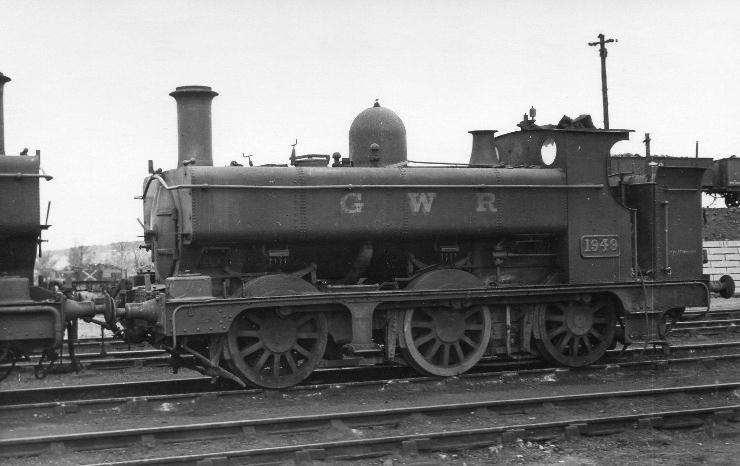 |
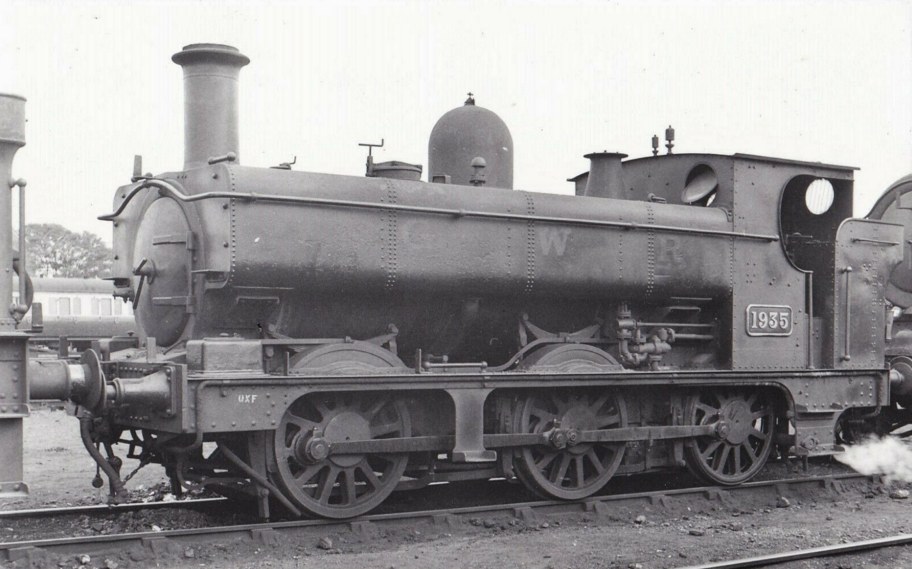
1935 at Oxford, September 1949
2021/2101 Class
From 1897 Wolverhampton built the 2021 class, an enlargement of the 850 which had a boiler with a larger firebox, known as the Class U. These still had the 4'1½" wheels, but with 7'4" + 7'4" wheelbase and 5' front and 6' rear overhangs. From 1902 the last batches were built with a Belpaire firebox and a domeless boiler, but still with saddle tanks. These were the 2101 class. The class totaled 140 locos.
These too sometimes received extended frames and bunkers, taking the rear overhang to 6'9". Like the 850/1901 classes, the 2021 locos were 7'2" wide over cabs. Their footplates and bufferbeams were 7'7" wide. When pannier tanks came along the 2101 series retained the domeless boilers for a while, but eventually all reverted to domed boilers. The pannier tanks were 900g capacity, 100g less than the saddle tanks. A few boilers featured a topfeed with a small cover casing. Many of the 2021 class were autofitted, and two (2120 and 2140) were even temporarily fitted c 1906–7 with a dummy coach shell so that they looked more harmonious in the middle of their trailer cars. This enclosed bodywork was removed in 1911, with the locos reverting to a normal appearance. Two more were used by Collett for experimental rebuilds to develop the 5400 and 6400 classes. Some swapped back to saddle tanks with boiler changes, and around 60 had enclosed cabs, some on occasion reverting back to the open ones. A very few were withdrawn before the war, but most survived until the 1940s and 1950s, some as late as 1958 to be the last surviving GWR pre-grouping 0-6-0 tanks 15. 2048 had the distinction of being the last saddle tank to be converted to a pannier, in 1948. |
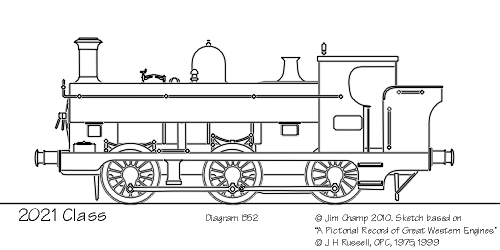
2021 class, with extended rear overhang and bunker |
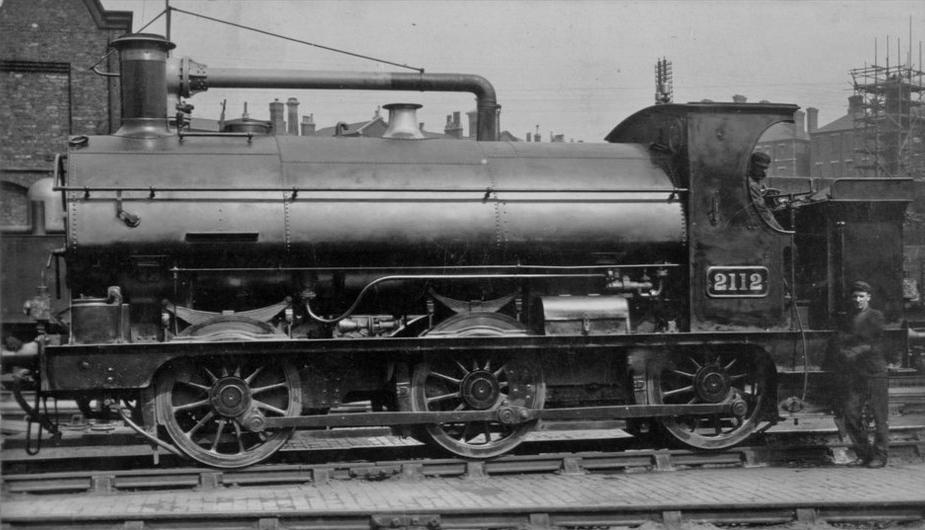
Domeless 2112 in early condition still with its manual blastpipe control lever at the front of the tank
| A pre-WWI domeless 2118 with a tall chimney. The bunker style, thought to have originated at Newton Abbot works, antedates the standard post-1924 Collett style. |
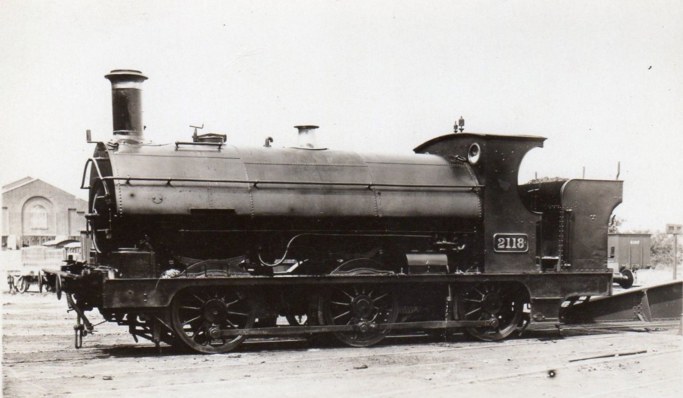 |
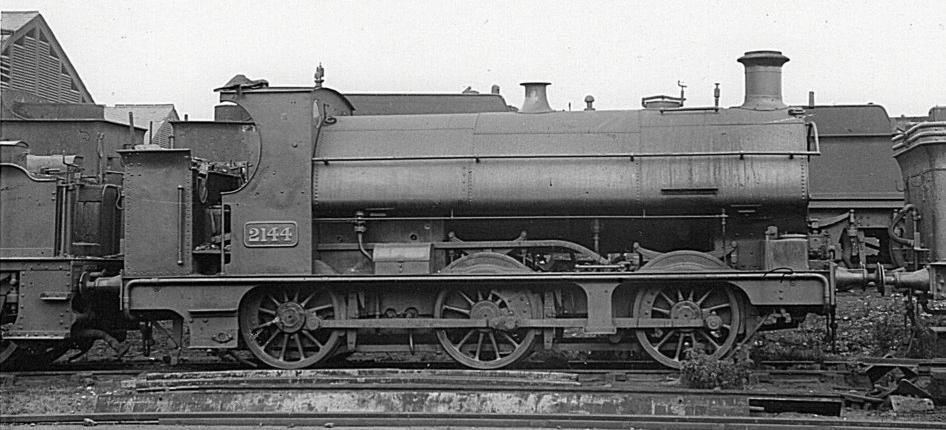
Domeless 2021 and 2101 class saddle tanks often had very short chimneys, e.g. 2021, 2028, 2048, 2121, 2124, 2144.
The rear of GWR bunkers, whether of Swindon or Wolverhampton origin, and whether saddle or pannier tanks, were usually rounded. However, there was a variant of the type 31 (RCTS notation) Wolverhampton bunker on a few of the 2021 and 2101 class locos that had square corners. Locos known to have featured these square-cornered bunkers were 2028, 2052, 2053, 2055, 2089, 2090, 2104, 2107, 2108, 2122, 2135, 2144 (as in the picture above), 2145 and 2154.
This is 2028 at Shrewsbury in 1935, where the bunker has been augmented with infilled coal rails, also square-cornered. |
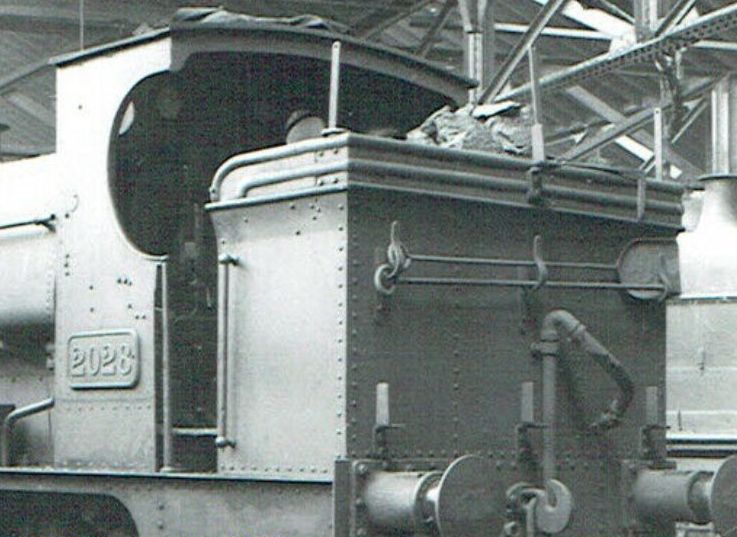 |
Smokebox doors
Before the introduction of the Collett pressed-ring style of front with a standard Collett smokebox door, there were smokebox door variations.
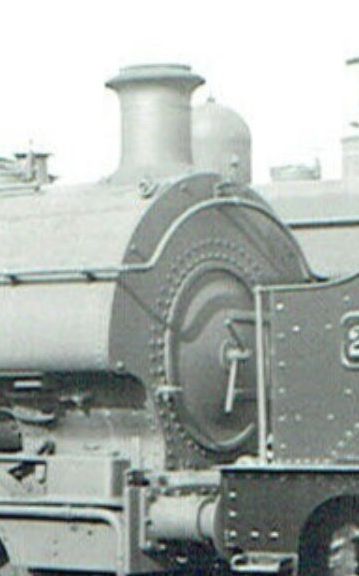
A Dean dished smokebox door on 2106 (Stafford Road, 1932) |
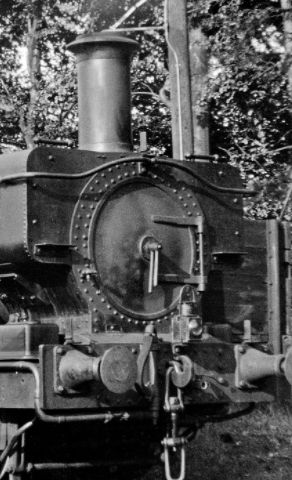
Dean dished smokebox door on pannier 2026
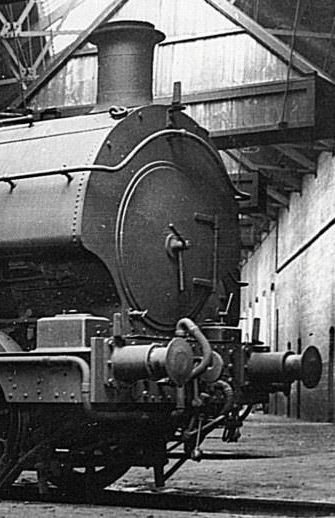
Large diameter Armstrong-style smokebox door on 2108 (Stourbridge, 24 April 1932) |
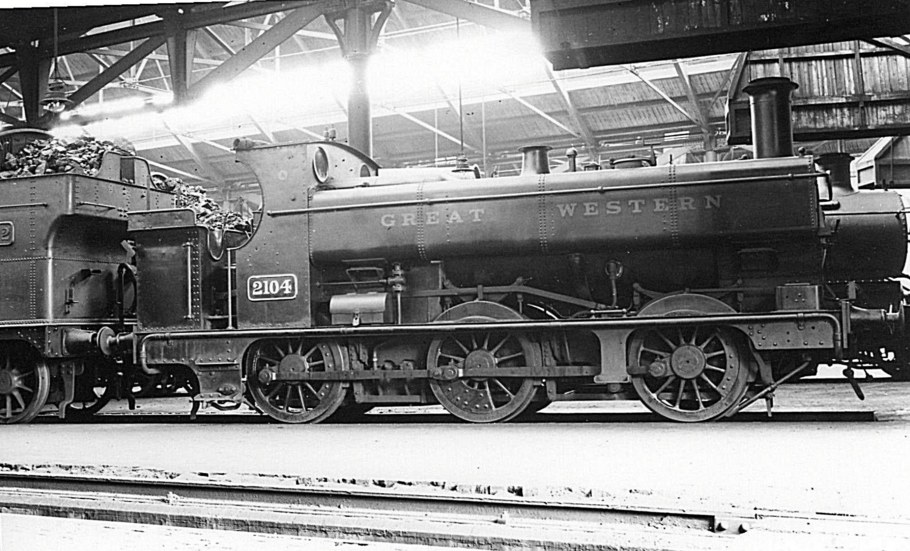
A domeless 2104 at Tyseley in 1930. For a top view of the firebox cladding, see here.
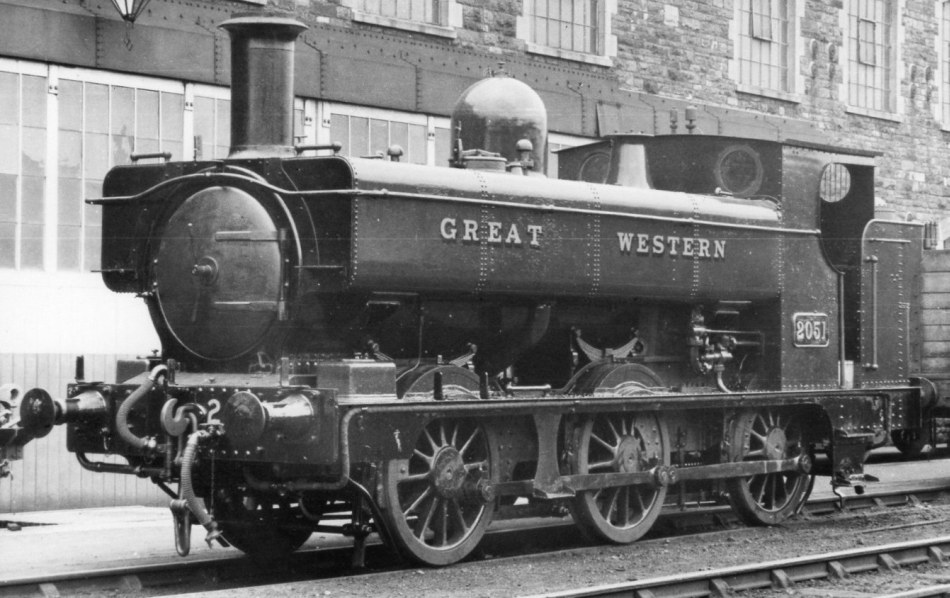
2051, freshly outshopped on 3 March 1935
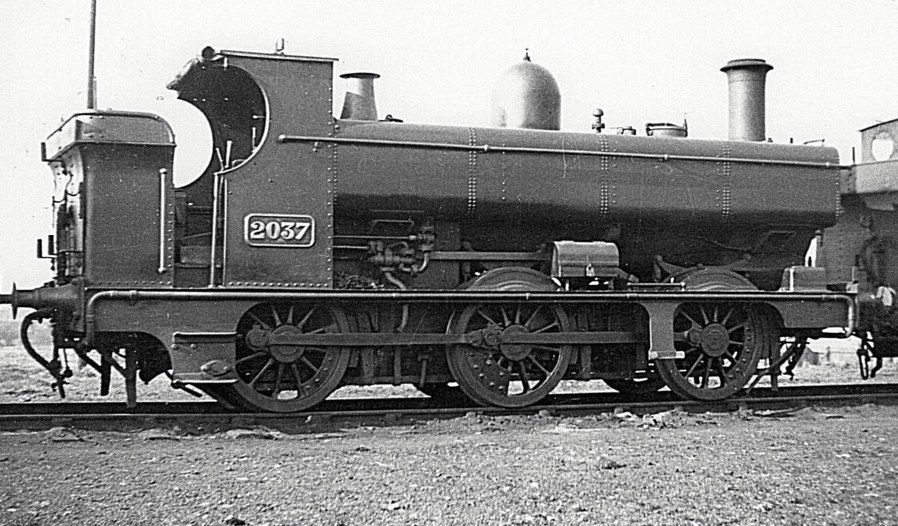
2037 at Newport Pill, 6 February 1938

2116, fitted with a rear weatherboard (probably by Wolverhampton), at Newton Abbot in 1936, possibly shunting the wagon repair shops.
Collett/Hawksworth
5400
As with the 5700 class, Collett had to develop replacements for older locomotives reaching the end of their lifespans. In February 1930, he took 2080, an autofitted 2021 class loco, fitted a larger (Standard 11) boiler and rewheeled it with 5'2" wheels to create a faster and more powerful locomotive. (2080 reverted to 4'1½" wheels in April 1931.)
A batch of new engines, the 25 members of the 5400 class, followed from 1931/2 with the last batch in 1935. These had the 5'2" wheels, still the 7'4" + 7'4" wheelbase and a fully enclosed cab. They were fitted with screw reverse. Overhangs were 5'2" and 7'7". They had a Standard 21 boiler (basically a Standard 11 but with drumhead smokebox). The tank capacity was 1100g. The class was the first to feature a revised filler with a clasp lever lid. Steps were fitted to the bunker on the fireman's side, mostly completed between 1937–9, whistle shields were fitted from 1938, and topfeeds were fitted to the boilers from 1943 onward. ATC fitting was completed by 1934.
The 54s were mostly withdrawn in the late 1950s, with one surviving to 1963. Although three made it to Barry scrapyard, all were cut up by 1965 so none were preserved.
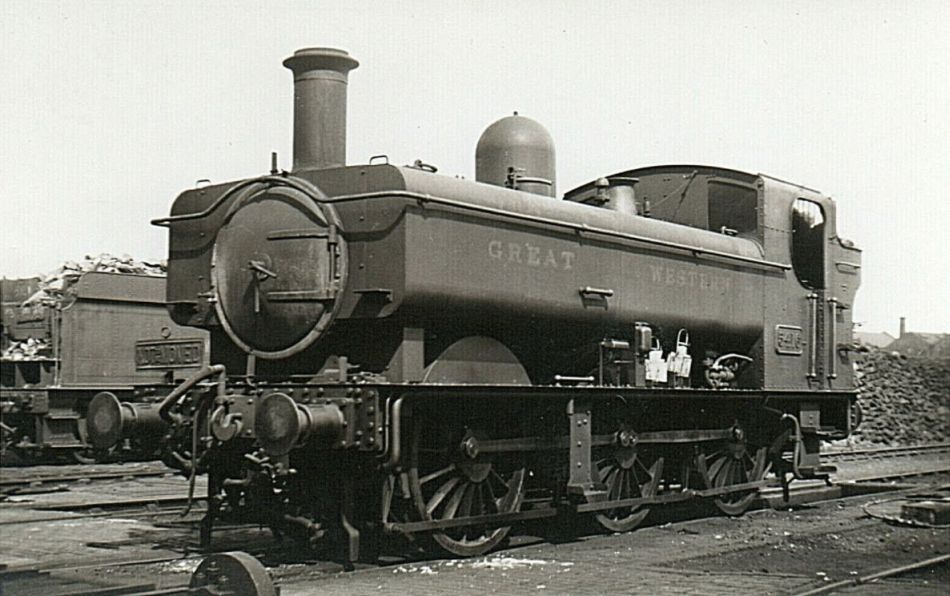
5416 at Old Oak Common, 15 May 1938. It is still in pre-1934 livery, and has a footplate-mounted lubricator. It has acquired bunker steps. The spare lamp stowage area is mid-footplate.
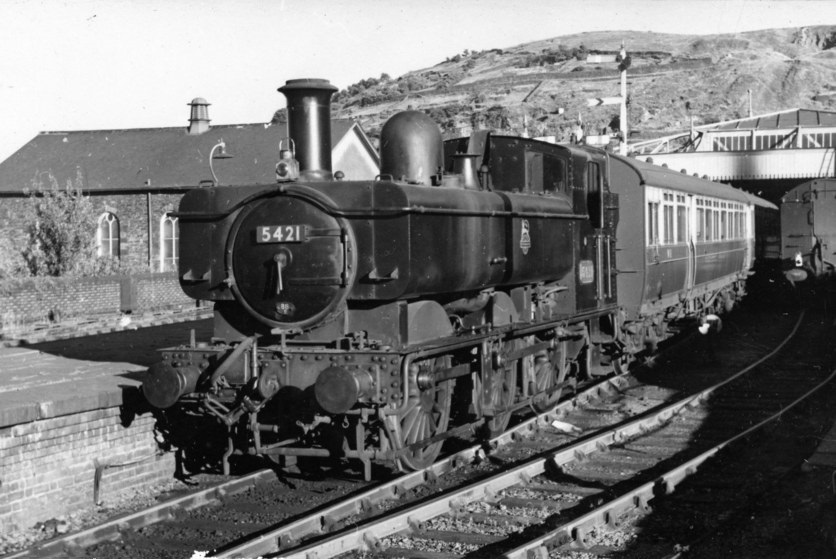
5421 at Pontypridd, 26 July 1952
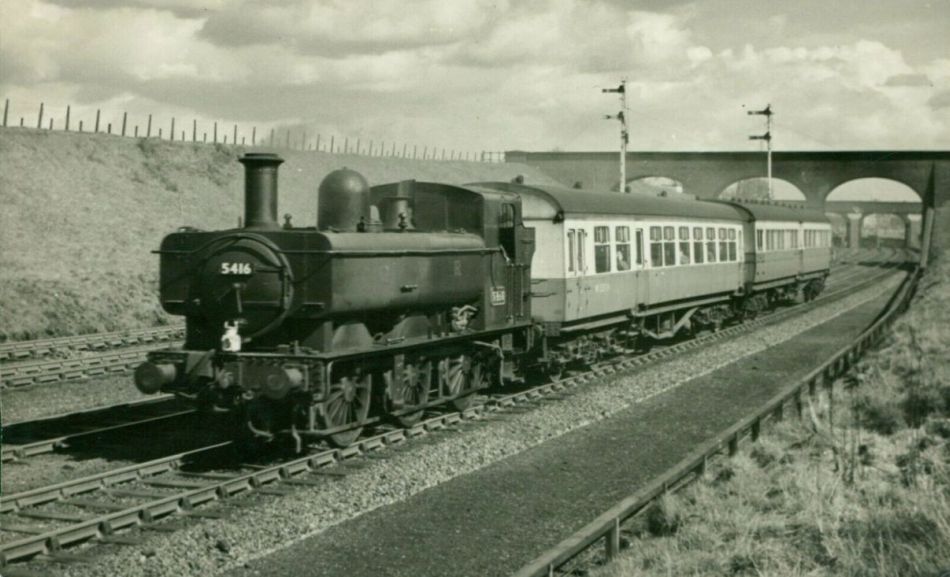
5416, near Saltney, with the 11:7am Chester to Oswestry service on 31 March 1954. The loco still shows its GWR insignia.
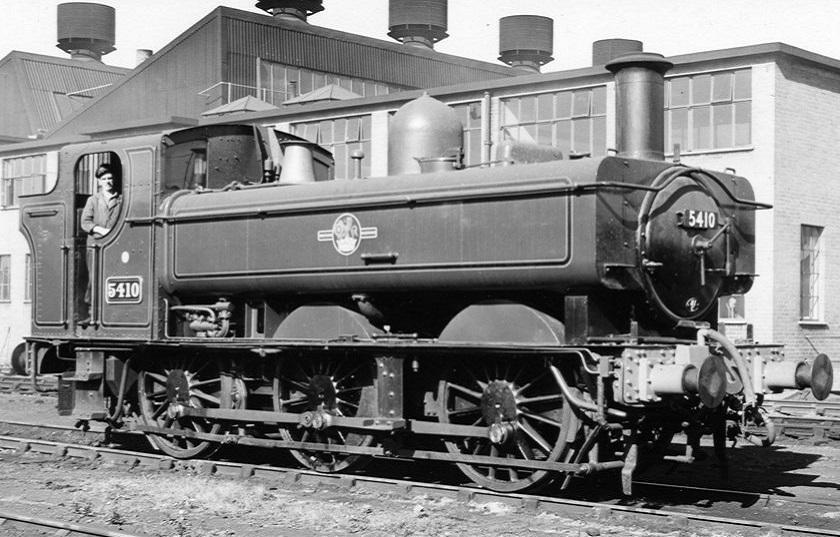
A very clean 5410 at Southall, in BR lined green
6400/7400
For hillier territory the 5'2" wheels were too large, so another 2021 class loco (thought to be 2062) was rebuilt, this time with the 4'7½" wheels of the larger tanks. This was the prototype for the autofitted 6400 class, with 40 built from 1932 to 1937. Screw reverse was fitted. For further notes on the detail variations in the 64xx class, see here. At approx 45½ tons, these locos were slightly lighter than the 5700/8750 locos, and had a greater route availability.
These were followed by the very similar but non-autofitted 7400 class, with a higher pressure boiler. 30 were built in 1936/37, ten more in 1948 and another 10 as late as 1950. The locos had lever reverse. Topfeeds were introduced to the boilers in later years, but the pool of non-topfeed boilers remained viable for many years, and locos could be seen with them even in late BR days. These 'small' engines were in fact as big and powerful as the early double-framed 'large' classes such as the 1076 class Buffalos, which were now disappearing.
The 64s lasted a little longer. Happily three were preserved, initially by the Dart Valley Railway, although they have since found other homes. The 74s nearly all lasted until the 1960s, but none survived. The tank capacity of the 64s and 74s was the same as the 54s, at 1100g. |
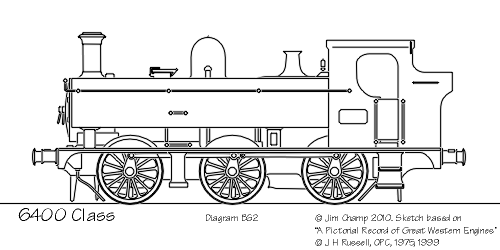
6400 class |
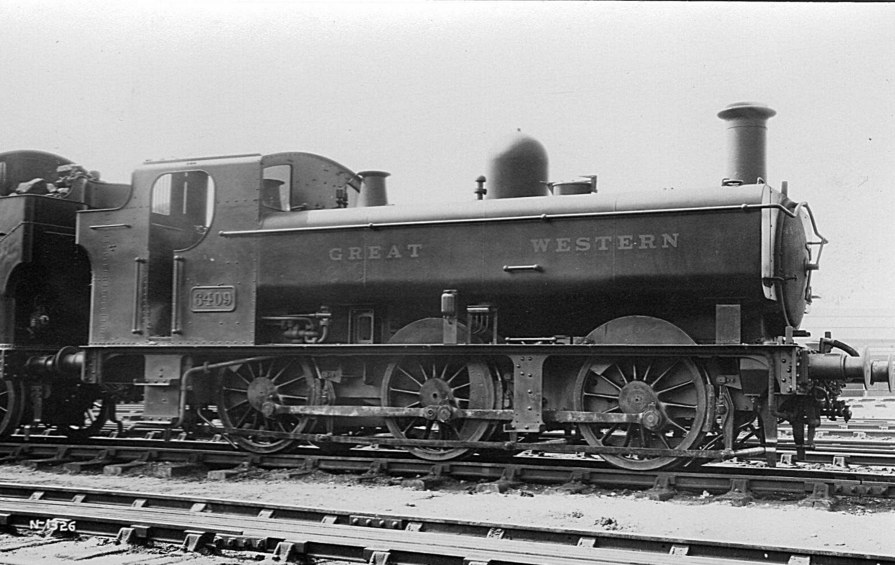
6409 in early days, with footplate-mounted lubricator
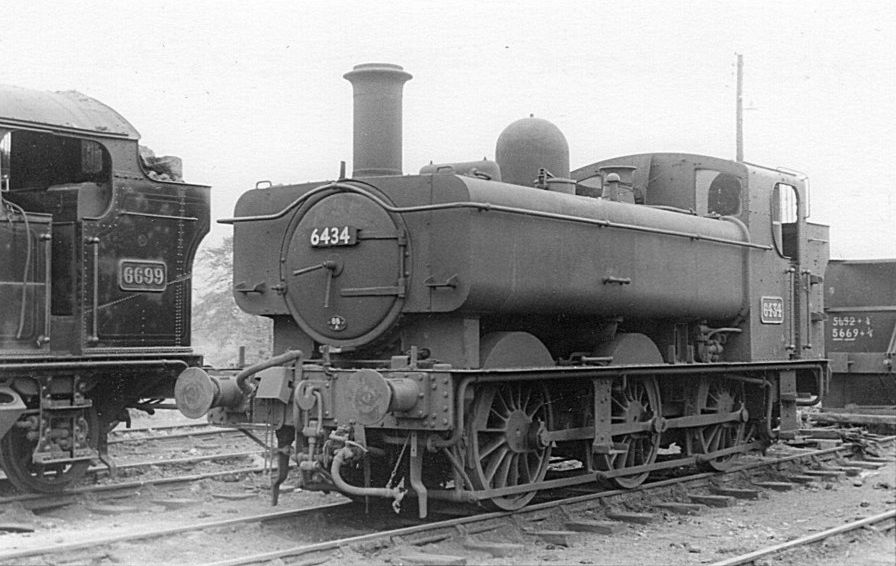
6434 at Radyr on 16 October 1960. Like many other autofitted engines, a packing piece is fitted behind the buffer headstocks.
| 7409 at an unknown location in early BR days |
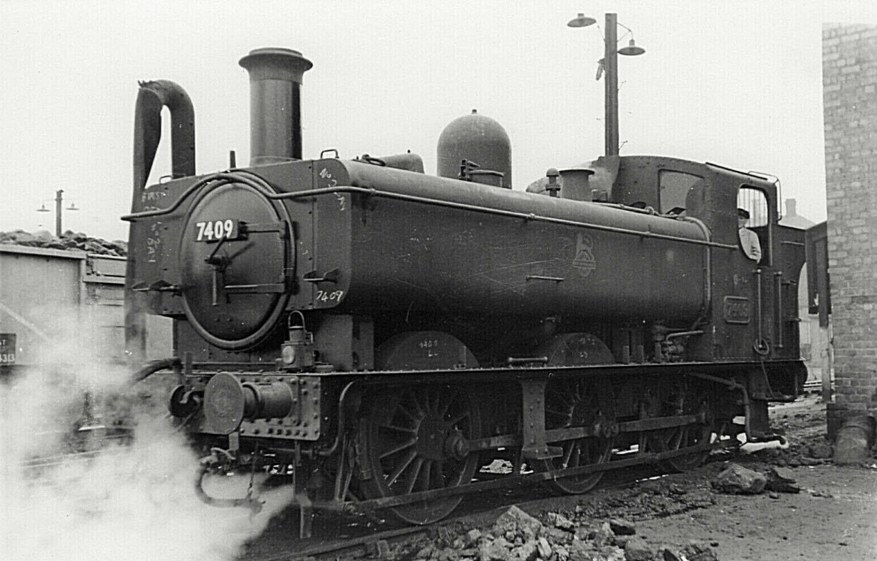 |
| 7427 with a local train at Plymouth, late 1930s. It was shedded at Laira at the time. |
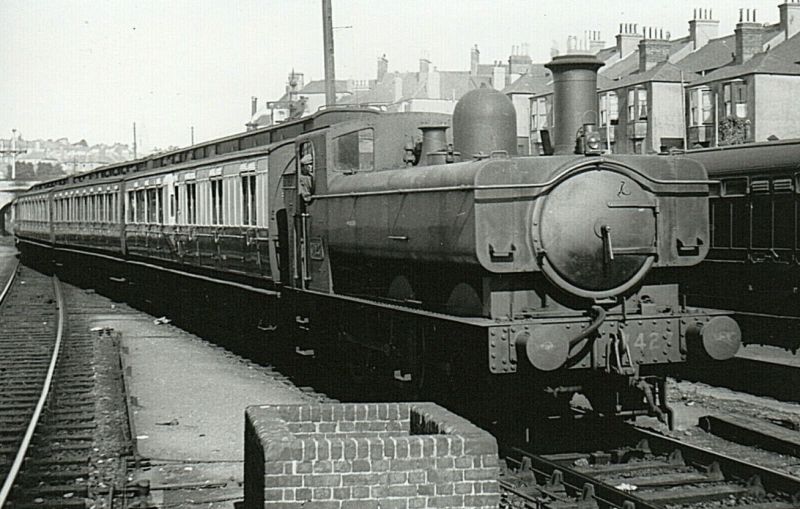 |
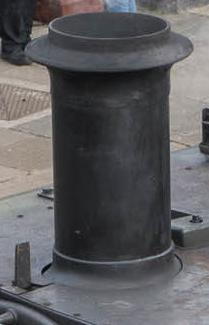 |
On flat-top panniers, the chimney base was set into a circular aperture in the top plate. The 2027 picture adjacent, with its tanks removed in 1957, shows the chimney is seated conventionally on the smokebox. | 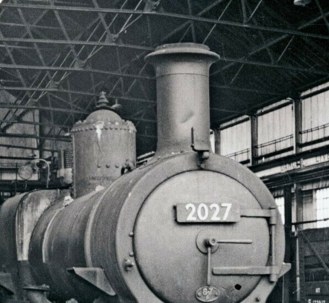 |
1600
Hawksworth again provided a finale, turning out the small lightweight 1600 class to replace the now very elderly 850s and 2021s, returning to the 4'1½" wheels, and keeping the 7'4" + 7'4" wheelbase. They were shorter than the 54/64/74 series, with 5'2" front overhang and 6'9" rear 16. The footplate was raised to a more conventional height compared to the earlier 850 and 2021 engines. All locos were fitted with topfeed, and unlike previous pannier designs, the feed pipes were tucked away underneath the boiler cladding.
The 1600s were built entirely under British Rail, but were in every sense a Great Western engine. Unlike the 9400s, the 1600 retained a domed boiler. Like the 9400s, they were also scattered round the system, two even ending up in Scotland 17. As well as being lightweight (41½ tons), the 1600s were low in height for use on lines with a restricted loading gauge. 80 were built, the first 50 in 1949/51, and the last 30 in 1954/5. They had a very short life, some being only 5 years old at withdrawal, which was between 1950 and 1965. One has survived into preservation. |
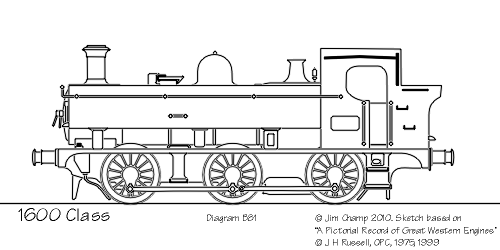
1600 class |
| Only a few years old, 1654 came to Slough in 1963, but would be gone a year later |
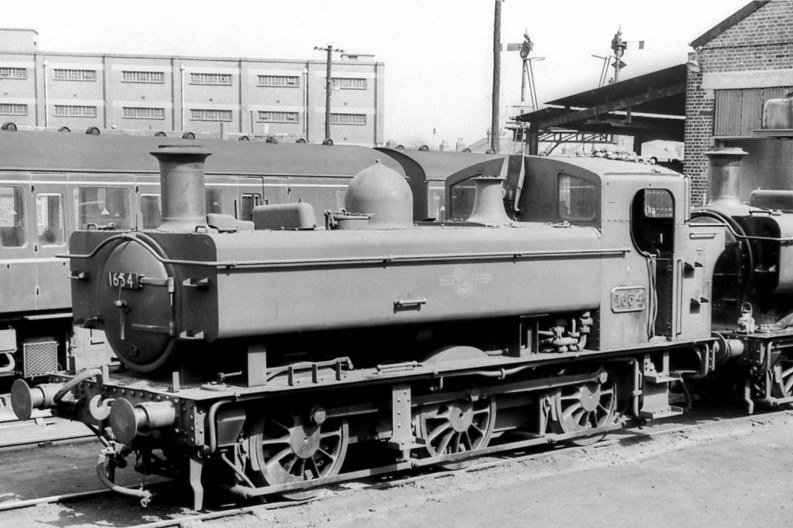 |
| 1665, 1666 and 1651 at Llanely in 1963 |
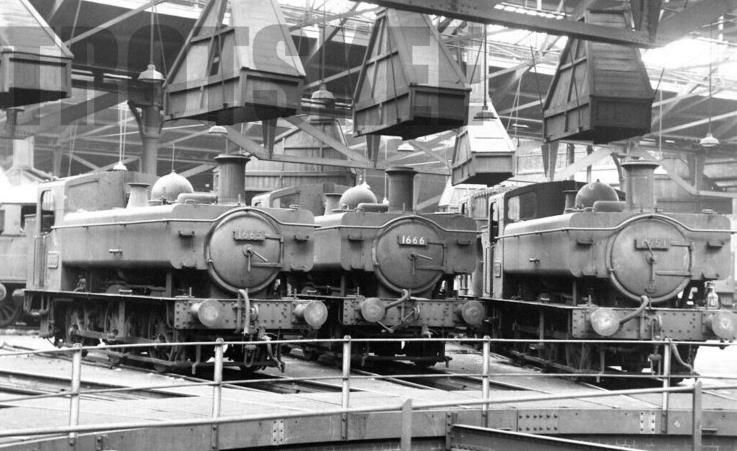 |
| 1636 shunting at Taplow |

|
Others
Beyond these major groups there were quite a number of small pannier tank classes and conversions. Quite a few absorbed 0-6-0 classes received similar rebuilds to the native engines, and little Manning-Wardle 0-6-0s with GWR cabs, fittings and pannier tanks were in the writer's opinion a particularly cute combination. There was even an 0-4-0 pannier tank, no 795, only 21' over buffers, which was one of the engines taken over from Powlesland and Mason 18.
| 795, built by Powlesland and Mason in 1903, as rebuilt with pannier tanks in 1926 |
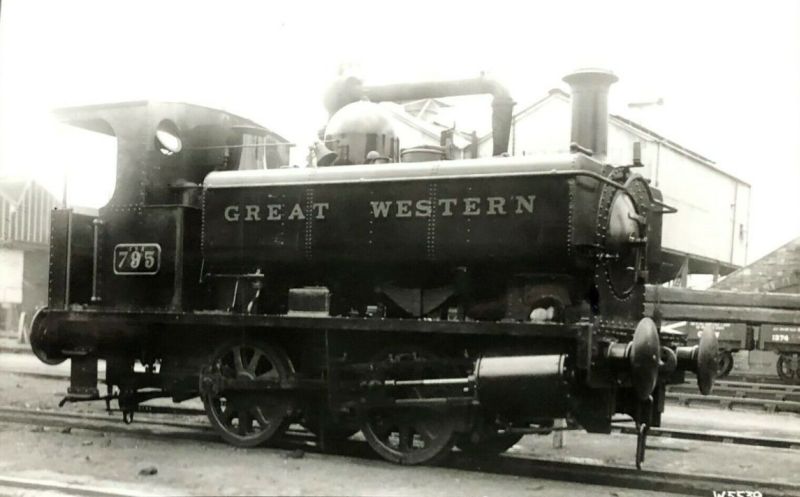 |
The other pannier tank classes built by the GWR in the 20th century were the very small and light 1366 class and the very substantial 15xx. The 1366 was an updated version of the 1361 saddle tank class, itself an update of an engine used on the Cornwall Minerals Railway 19. The 1366 tank capacity was 830g. The 15xx had a 9400 class boiler and 1350g tanks on a very short wheelbase (6'4" + 6'6") chassis with outside Walschaerts valve gear, and somewhat unsteady at speed 20. Most of them spent their brief lives on ECS workings at Paddington, but three were sold after BR service to the NCB for colliery use. One of each class has survived into preservation.
Three 0-6-4T crane tanks were built – the first of which appeared in 1901. The loco chassis had 4'1½" wheels and were the same as the 850 class. They were numbered 16–18, and all were named ("Hercules", "Cyclops" and "Steropes" respectively). They rarely ventured out of Swindon works or Stafford Road works.
| The origin of the design of the 1361 saddle tanks came from the locos of the Cornwall Minerals Railway. These originated as Sharp Stewart & Co sidetank designs, were rebuilt with saddle tanks by the GWR after the CMR had been taken over in 1876, and received standard Swindon cabs, bunkers and boiler fittings in due course. They originally had very thin chimneys, but were fitted with fatter ones as shown here on 1397. These chimneys were transferred to the 1361 class when the CMR locos were withdrawn (1397 going in 1933). The Collett 1366 panniers replaced the withdrawn CMR locos. |
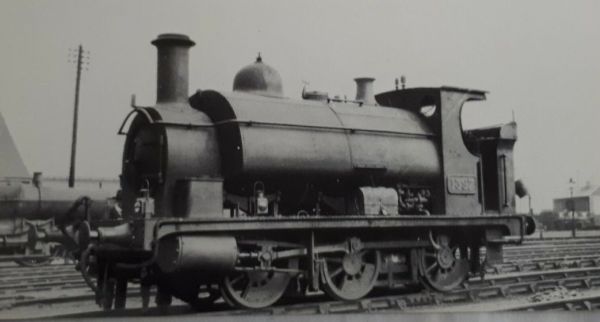 |
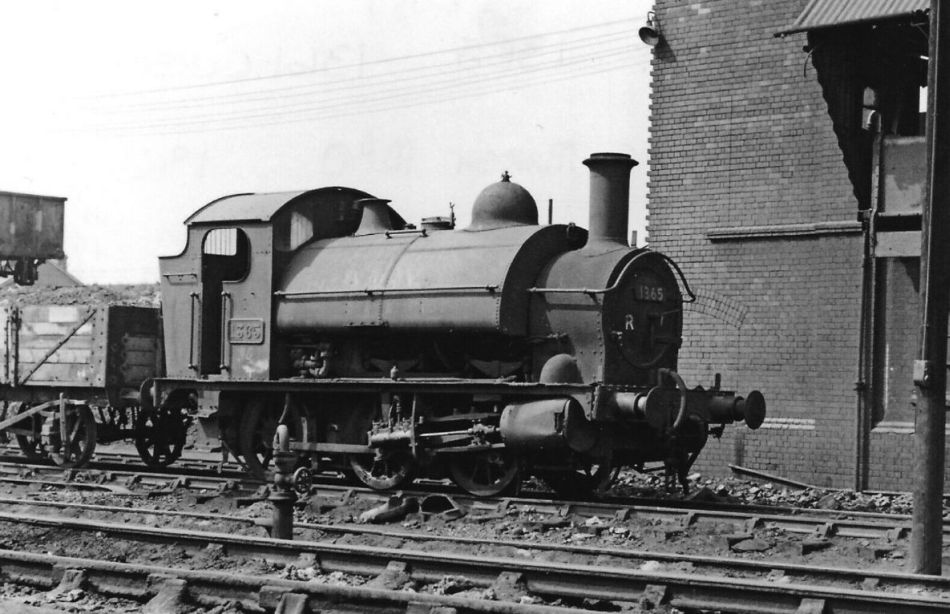
Looking distinctly worse for wear, 1365 spends its last days at St Philips Marsh in 1962.
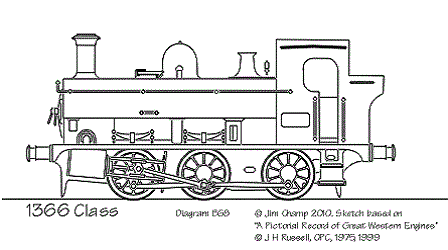
1366 class |
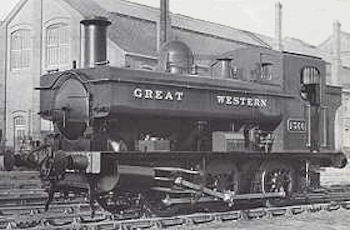
1366, ex-works in 1934. This class of six locos emerged a few months before the Roundel insignia was introduced. |
| 1370 at Weymouth in 1956. A bell is fitted, adjacent to the injector, for working the quay line. The overflow pipe from the injector is routed outside of the footplate. |
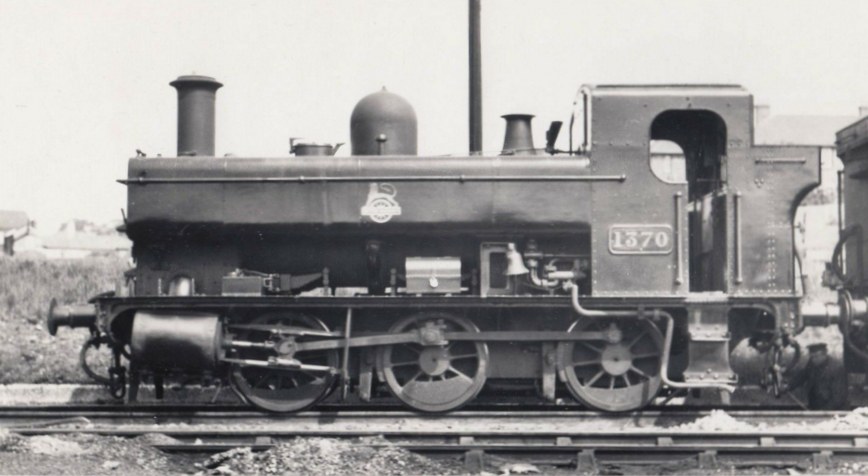 |
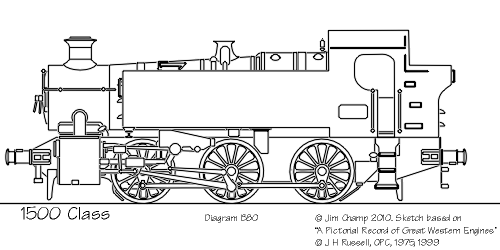
1500 class
| Official portrait of 1500, June 1949. The shed code ('PDN') is stencilled on the left-hand side motion bracket. A BR cast shed code plate was not fitted on the smokebox door until sometime later. |
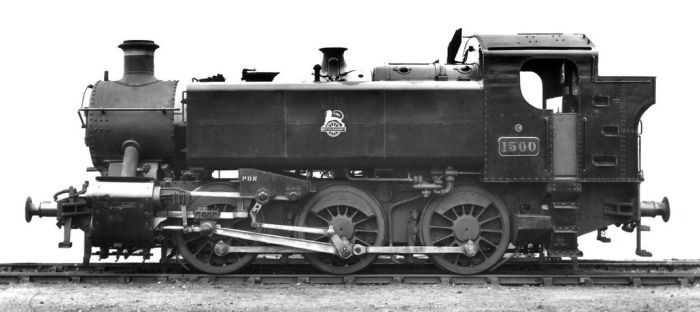 |
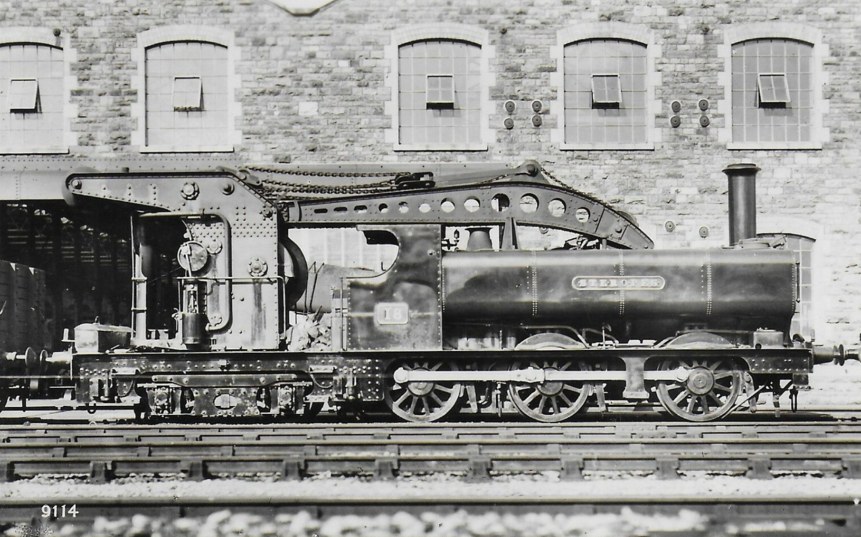
GWR crane tank 18 'Steropes', September 1936
Absorbed locos
The GWR inherited a bewildering variety of inside- and outside-frame 0-6-0 tank engines from the constituent companies at the Grouping in 1922. Most of these locos were given belpaire fireboxes, pannier tanks and Swindon boiler fittings.
Such locos surviving WWII were generally swept away with the arrival of the large 94xx tanks.
| 139, an ex-Rhymney Railway K class 0-6-2 tank, at Caerphilly in 1932 |
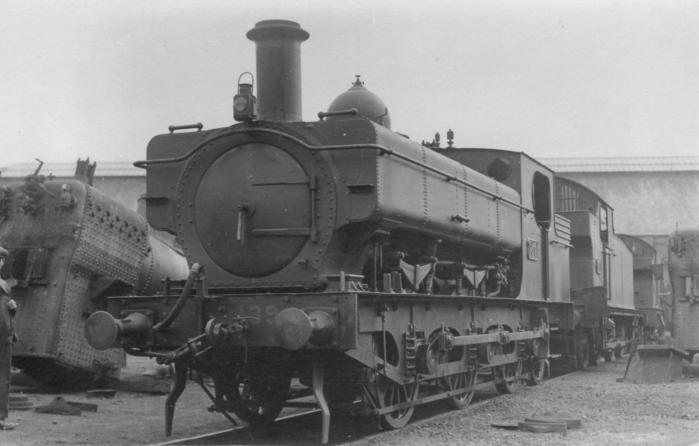 |
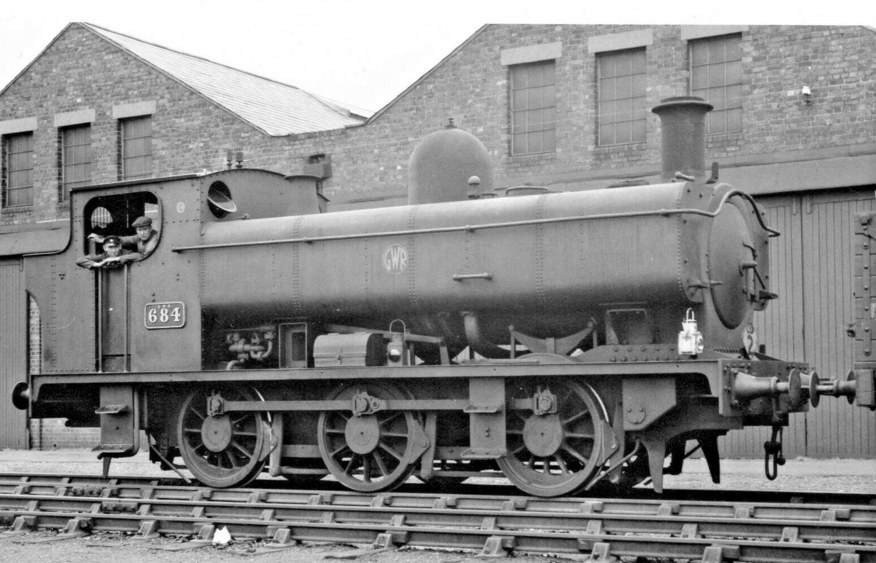
684, an ex-Cardiff Railway tank, at Cardiff East Dock on 18 September 1937. It was originally built as a saddle tank in 1920 by Hudswell Clarke, and survived until 1954.
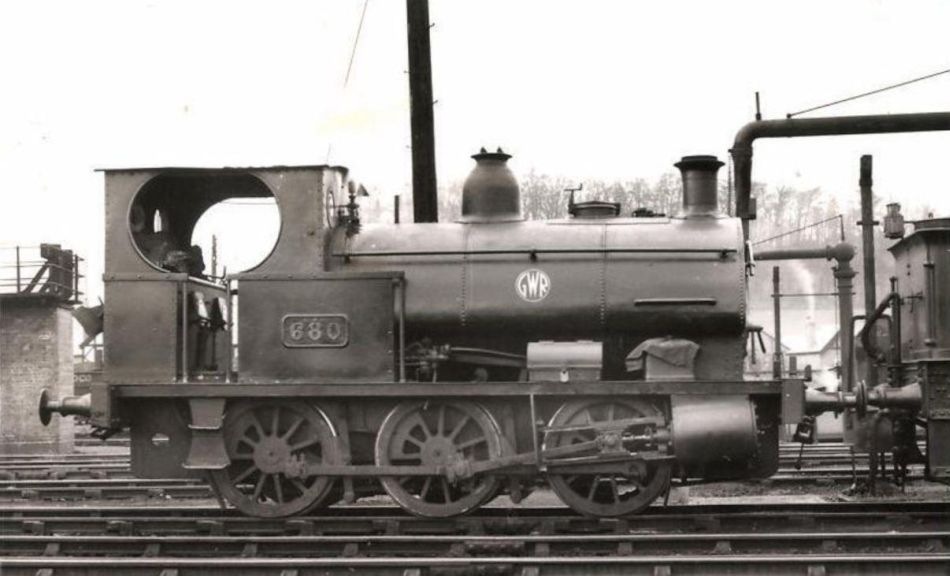
Some absorbed locos were not Swindonised. 680 was a Peckett tank built for the Alexandra (Newport and South Wales) Docks and Railway, and lasted until December 1948. It spent much of its life on the Tanat Valley Railway, and is seen here at Oswestry shed.
References
1 An Outline of Great Western Locomotive Practice, H Holcroft, Ian Allen Ltd (p42 1971 edition)
2 A Pictorial Record of Great Western Engines, Vol1 Gooch Armstrong and Dean, J H Russell, OPC, 1999. P144

1490, the first pannier tank, as built in 1898. It had 4'7½" driving wheels and 2'8" Mansell type carriage wheels on the bogie. It was intended as a successor to the Metros, but proved too heavy and unstable, and ended its short GWR career shunting at Bath and finally Swindon. It was subsequently sold to Ebbw Vale Steel, and sold again in May 1908 to the Brecon & Merthyr as their No 35, and again to the Cramlington Colliery Co. Ltd. of Northumberland as their No 5. After modifications it was used for a number of years, finally being broken up in 1929.
3 Holcroft, page 26
4 The Locomotives of the Great Western Railway Part Five: Six-coupled Tank Engines, N J Allcock, F K Davies, H M Le Fleming, P J T Reed & F J Tabor, The Railway Correspondence and Travel Society is the best source for this sort of detail.
5 Swindon Steam 1921–1951, K J Cook, Ian Allan Ltd (p63 and on, 1974 edition)
6 The Locomotives of the Great Western Railway Part One: Introductory Survey, N J Allcock, F K Davies, H M Le Fleming, P J T Reed & F J Tabor, The Railway Correspondence and Travel Society.
7 The Class letters for boiler classes which became extinct were later re-used for other types.
8 RCTS Part 5, p E13
9 Photo: All in a Day's work: Life on the GWR, Tim Bryan, Ian Allan, 2004, p123.
10 Cook, p84
11 Locomotives of the GWR Part 12: Chronological/Stat.Survey, F.M.Gates, Railway Correspondence & Travel Society, 1974, p123
12 Cook, p151
13 Cook, p151
14 RCTS Part 5, p E82
15 The Observers book of Railway Locomotives of Britain, H C Casserley, Warne, 1958 edition
16 Collett & Hawksworth locomotives, a Pictorial History, B Haresnape, Ian Allan, 1978 as reported on GWR-elist.
17 Casserley
18 A Pictorial Record of Great Western Absorbed Engines, J H Russell, OPC, 1978, p255.
19 Holcroft, p127
20 Holcroft, p160
21 Locos 855, 864, 873, 990, 991, 1216, 1904, 1913, 1925, 1932, 1933, 1939, 1944, 1963, 1981, 1984, and 2007.
21 GWR 5700 Class
22 735, 953/63, 1078, 1145/6/7, 1232/4/56/74/82/91/5, 1577/99, 1630/51/2.
23 1260/89, 1587/99, 1611/39 (non-superheated), 1238/50/95, 1561/9/98 (superheated).
Drawings are approximately redrawn from Russell but are strictly representative and may contain errors.
|

















































































































































































